Inbox and environment news: Issue 520
November 28 - December 4, 2021: Issue 520
Pittwater Natural Heritage Association: Signs Of Trad Elimination
Really EXCITING news!!! The Smut disease that affects Trad, that awful weed, is really taking off along the track to the Irrawong waterfall. We planted some infected stems there in October last year, sent from the CSIRO. Now the Smut is infecting quite a lot of nearby Trad. Watch for the yellow spots. Round spots on the undersides of the leaves are where the Smut, a type of fungus, is growing spores that spread the disease. It may not kill off the Trad but will weaken it so that other plants can get through the dense infestations.
To find out more about this project, please visit: Trad Biocontrol Release In Pittwater
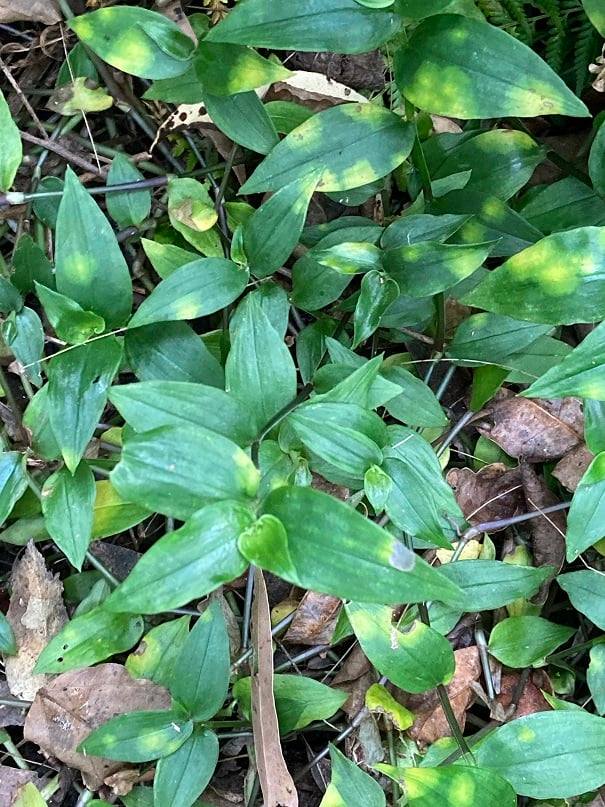
PNHA AGM 2021
The 2021 PNHA AGM, talks and lunch are on Sunday December 5.
The Bangalley Headland Reserve in Avalon has a big list of native flora and fauna species. Jayden Walsh, ecologist, and Sally Alldis, bush regenerator, will tell us about their work there.
Time: 11.30 am.
Place: Newport Recreation Centre.
Our famous Pittwater cards will be for sale.
Email pnhainfo@gmail.com if you'd like to come.
All Welcome. Double vaccination and sign in required.
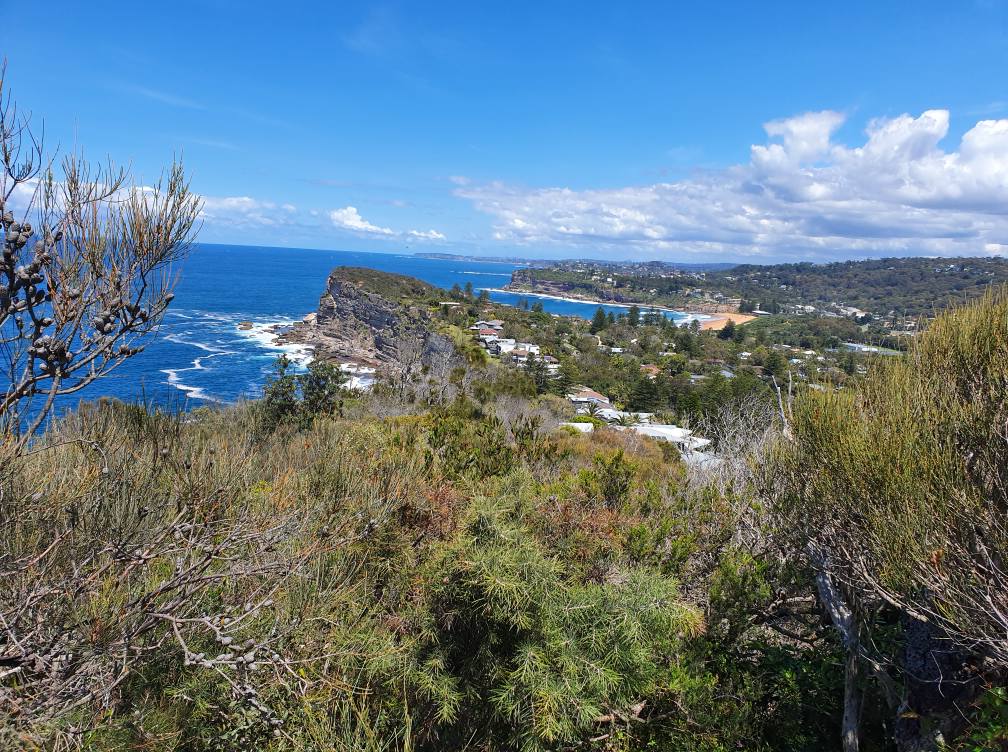
Flowering Now: PNHA
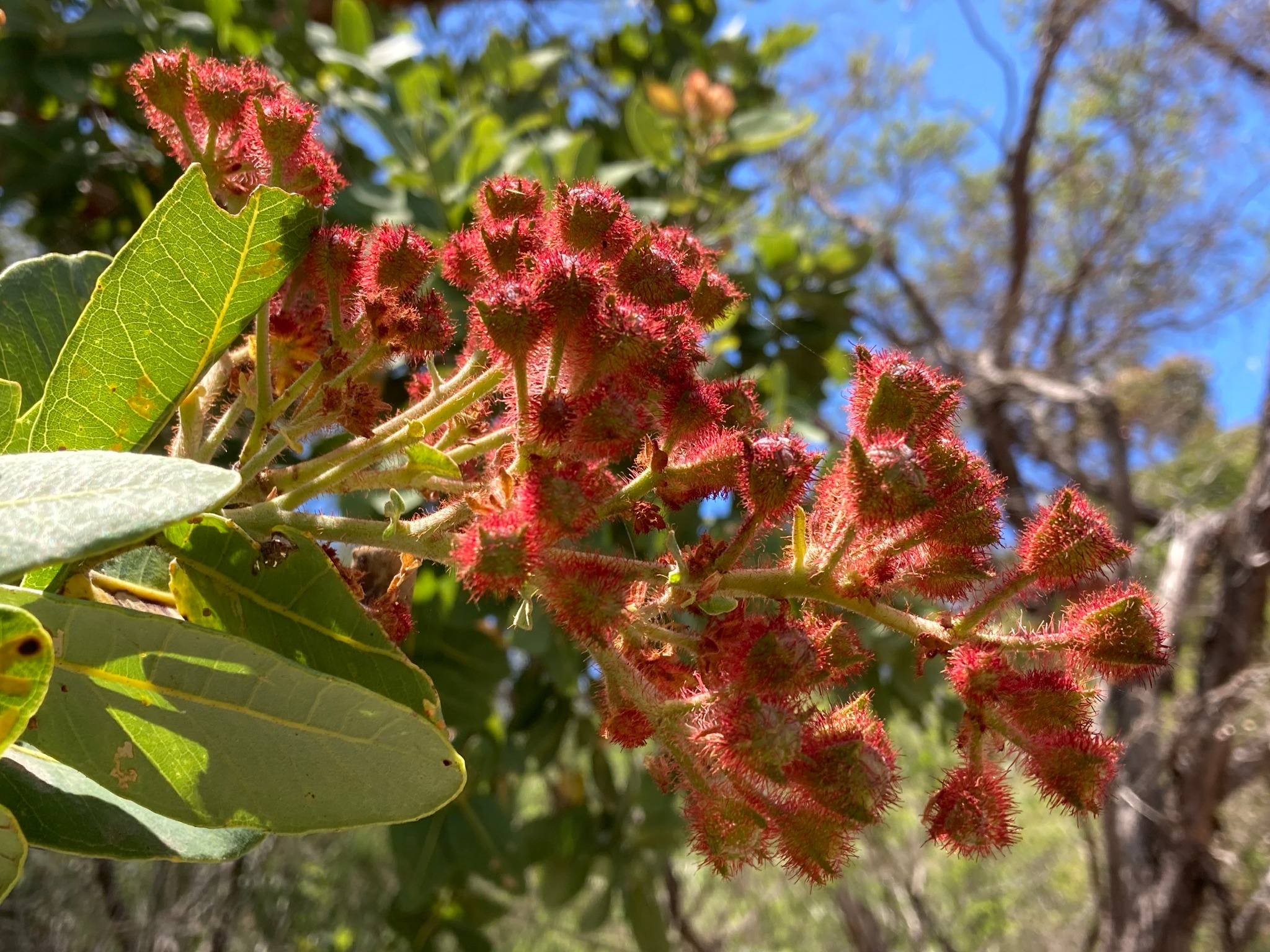
Dwarf Apple Gum, Angophora hispida. Hispida means 'hairy' - you can see why on these buds. Lots of these now in November on our favourite Chiltern Trail in Ku-ring-gai Chase NP at Ingleside. Insects love the flowers, specially beetles.
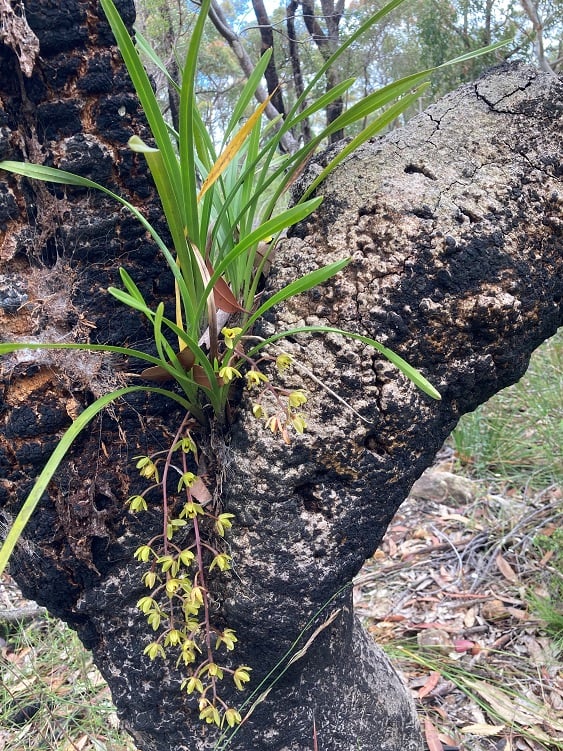
Our local native orchid Cymbidium suave is flowering now on land in Ingleside that was proposed to be cleared for housing. Just one of Ingleside's many bush treasures. The flowers are tiny, about violet-size, and on many spikes with lots of flowers. It's an epiphyte, growing on trees with deep hollows down which grow the roots.
White's Seahorse Signage At Palm Beach
White’s Seahorse, also known as the Sydney Seahorse, is a medium-sized seahorse that is endemic to the east coast of Australia. The species is named after John White, Surgeon General to the First Fleet, and is one of four species of seahorses known to occur in NSW waters. Favouring shallow-water estuarine habitats, it is currently known to occur in eight estuaries on the NSW Coast, but is most abundant in Port Stephens, Sydney Harbour and Port Hacking. Its northern limit is Hervey Bay in Queensland and it has been historically recorded as far south as St Georges Basin in NSW.
Some of the characteristics of the White’s Seahorse are:
- 17-18 dorsal-fin rays,
- 16 pectoral-fin rays
- 34-35 tail-rings
- coronet is tall arranged in five pointed star at apex
- spines are variable ranging from low to moderately developed and from round to quite sharp
- a long snout
They have a very small anal fin which is used for propulsion, however, they are known to be one of the slowest swimming fishes in the ocean.
The White’s Seahorse is considered to be endemic to the waters of southern Queensland (Hervey Bay) to Sussex Inlet NSW where it can be found occurring in coastal embayments and estuaries. It is known to occur from depths of 1 m to 18 m. Habitats that are considered important habitat for the White’s Seahorse include natural habitats such as sponge gardens, seagrass meadows and soft corals. It is also known to use artificial habitats such as protective swimming net enclosures and jetty pylons.
The primary cause for the decline in abundance of White’s Seahorse is the loss of natural habitats across their range in eastern Australia. The seahorses occur within coastal estuaries and embayments which are areas subject to population pressure.
Below: the signage at Palm Beach
Powerful Owl Project Season Update
Wednesday December 1st: 7-8pm
Hosted by Lane Cove Council
Join us for an owly update and see what our Sydney Basin Powerful Owls have been up to throughout 2021.
Birdlife Australia will share the results of this latest breeding season and discuss the ongoing work on genetics and rodenticides as well as other challenges our urban owls are facing.
Tune in for a great overview and discussion on our owls.
FREE: Bookings essential - HERE
PO at Bayview: photo supplied
Our Coastal Lagoons In Focus Next On Wendy Frews' The Coast On Radio Northern Beaches
The four coastal lagoons that grace the Northern Beaches – Narrabeen, Manly, Dee Why and Curl Curl – are fragile ecosystems that have taken a battering over the years. Their wetlands have been used as rubbish dumps, their riparian zones cleared of native vegetation and suffocated by invasive species, and their waters polluted.
Some of the damage is historical. Lagoon wetlands in particular have traditionally been viewed as useless areas and sources of disease, and in many cases have been filled in and used as sports grounds and parks.
But a group of hard-working residents on the beaches is determined to bring its lagoon back to life, and instil local pride in the creek that feeds it and the native vegetation that protects its banks.
Alongside Northern Beaches Council, local group Curl Curl Lagoon Friends has been looking after the eponymous lagoon and Greendale Creek since 1980. It’s latest initiative – creating a floating wetland – could raise the health of this waterway to a new level.
In the next episode of Radio Northern Beaches environment show, The Coast, Friends member Paula Cowan explains how the pilot project has worked. An above-ground 5000 litre poly water tank was installed at the back of the North Curl Curl Community Centre. The tank was filled with lagoon water and a large pad holding a growing medium was installed in the tank.
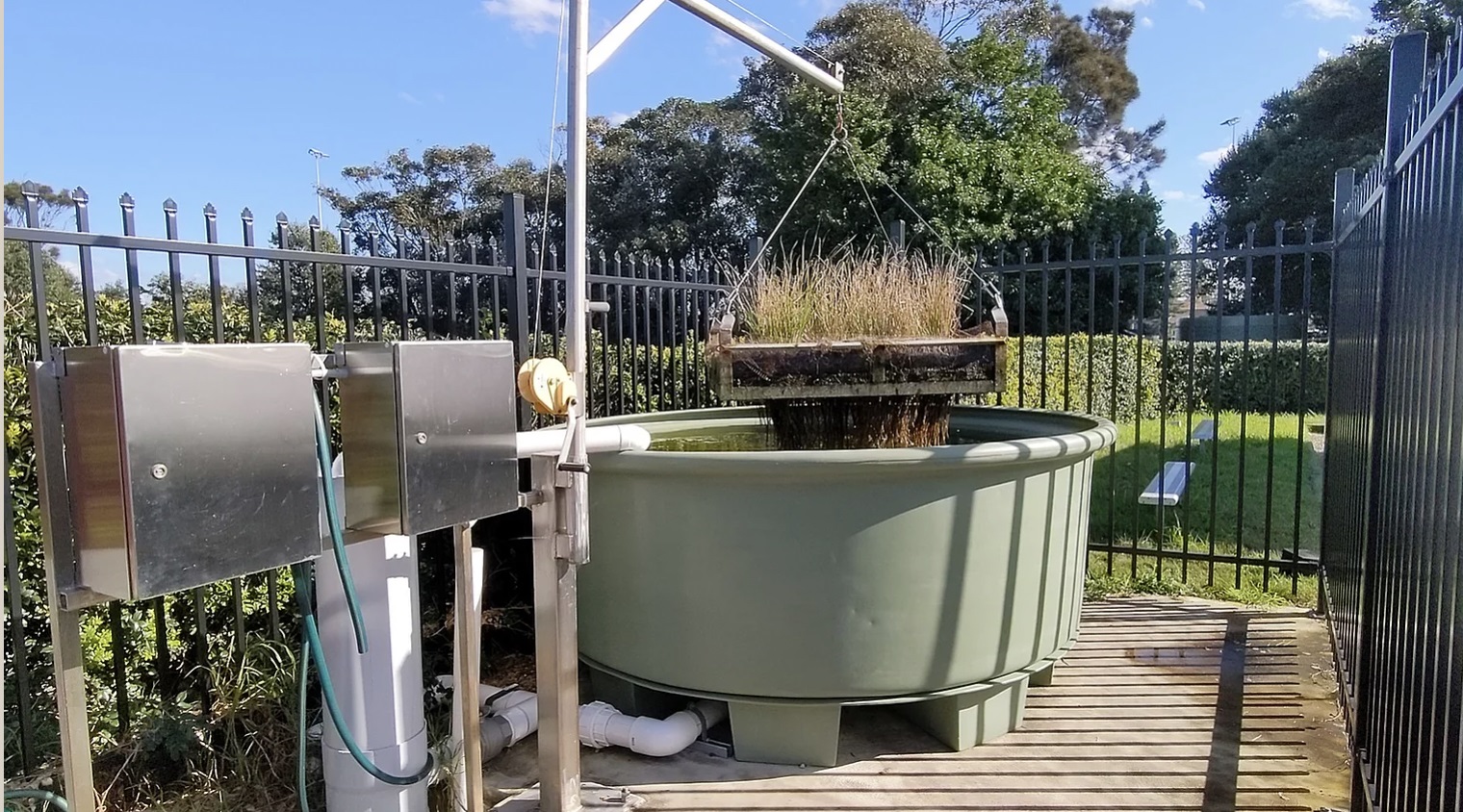
"Floating wetland" tank - photo courtesy of Curl Curl Lagoon Friends.
The idea, says Paula, is to see which native plant species can both survive in the lagoon and help clean the lagoon water. By May, this year, it was demonstrated that tall sedge species Carex appressa could survive on nothing more than sunlight, air and the nutrients present in the water sourced from the lagoon. Scientific testing showed also an encouraging general net decrease in nutrient concentration.
“We found that over time [the installation] reduced some of the phosphorous and nitrogen in the water and it has increased the oxygen in the water,” says Paula.
“We have a pump that draws water from the lagoon ensuring it circulates and we have a winch that pulls up the floating pad and we can check out what’s underneath it. We found dragon fly nymphs living under there so it is supporting life even under the water.”
Ultimately, Curl Curl Lagoon Friends want floating wetlands like the one used in the pilot project installed in the lagoon, above the weir, where there is enough water all the time to support them. That could happen early next year.
The group has also worked hard to remove non-native vegetation from the banks of the lagoon, replacing it with endemic native species that provide food and protection to small mammals and birds.
At certain times of the year, the lagoon is a haven for waterbirds, including breeding black swans. The bush also acts as a filter between the adjacent playing fields (built on an old municipal tip that still leaches into the environment) and the lagoon, slowing down storm run-off and capturing litter that would otherwise end up in the water.
“We would like to see some more filtering in the creek,” says Paula. “The more you slow the water, the more you filter it.
“I would love to see people engage with the lagoon, understand what they are looking at. When you understand something you value it.”
In this episode of The Coast, which goes to air on Friday 3 December at 11am, presenter Wendy Frew also speaks to coastal engineer and former Pittwater General Manager, Angus Gordon, about dredging operations at Narrabeen Lagoon, and chats with Surfrider Foundation Northern Beaches President Brendan Donohoe about what that dredging means for surf breaks.
The Coast is broadcast at 11am on Fridays on Radio Northern Beaches (88.7/90.3 FM). You can listen to all episodes of the show, for free and on demand, at https://www.mixcloud.com/TheCoastRNB/.
Careel Creek: Dusky Moorhen + Chicks In Residence - Please Keep Your Dogs On Their Leads
Dusky Moorhen in Careel Creek, Saturday October 30, 2021 - photos by A J Guesdon
Dusky Moorhen in Careel Creek, Thursday November 30, 2021 - photos by A J Guesdon
Dogs Attacking Wildlife
On Sunday November 21st 2021 Jaz was walking her dog at Suffolk Park allocated dog beach when she noticed two dogs chasing a very small wallaby joey. The tiny joey was jumping in and out of the water, the dogs nipping at its heels.Jaz called out to the dog’s owner to stop them, he responded by calling his dogs, but made no attempt to restrain them.
Jaz was carrying a towel which she managed to throw over the joey and the dogs retreated.
As Jaz carefully picked up the tiny animal, Leon who is Animal Enforcement Officer with Byron Bay Council arrived at the beach and Jaz was able to hand him the little joey. Leon delivered it to nearby WIRES volunteers Annie and Dave at Suffolk Park where the joey was treated for severe shock.
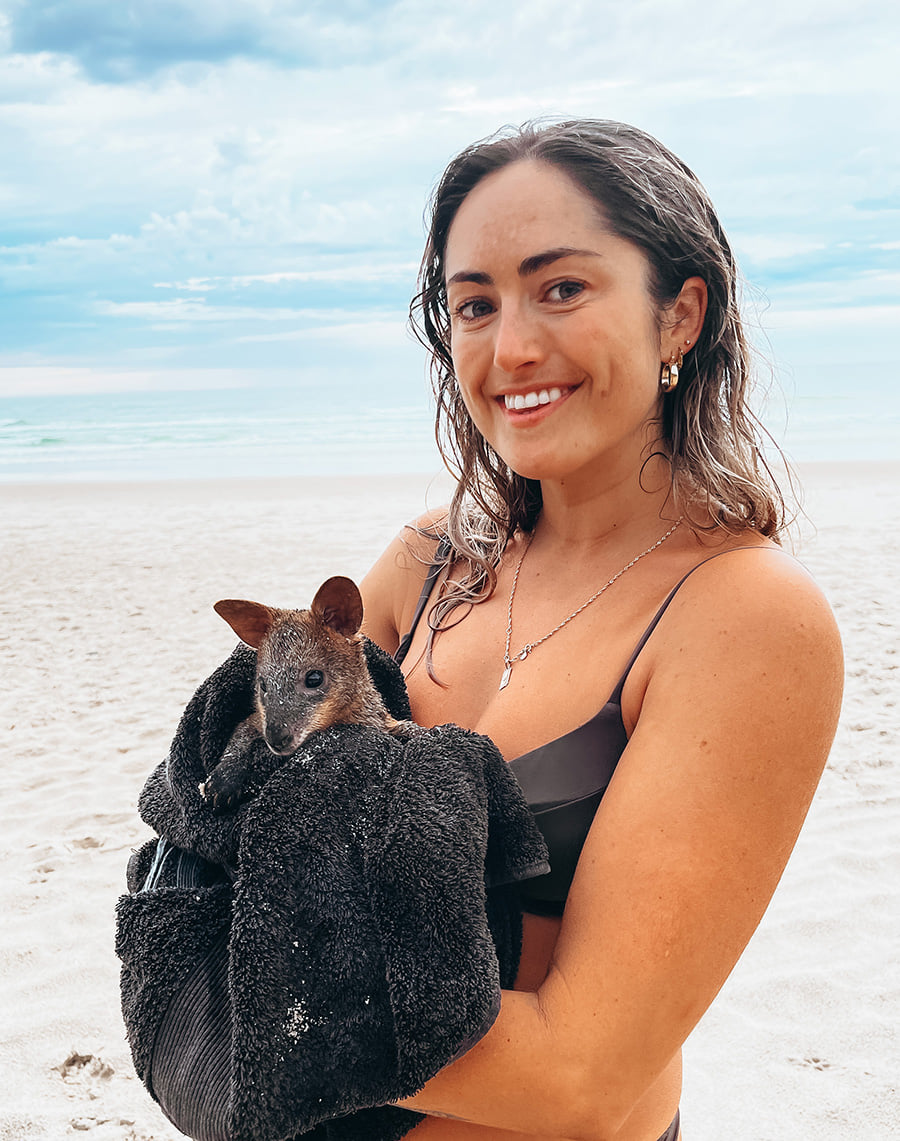
The joey is a Swamp wallaby, and it is just 7 months old, it is at a stage of development where it would spend considerable time in mums pouch and just starting to hop out to follow her at foot as they forage for food. But Mum had not been with the joey and she was nowhere to be found.
Earlier that same morning a call to WIRES emergency hotline had been received, this call was for an adult Swamp wallaby seen at the picnic area nearby. The wallaby was observed trying to hop away, but injuries to its back legs were severe and it was falling over as it tried to move.
WIRES volunteers Annie and Dave had responded to the call straight away, but were not able to locate the animal. Putting two and two together, this wallaby was likely the little joeys mum, injured by dogs earlier that the morning, the joey managing to get away whilst mum was being chased.
Repeated visits to the site during that day were fruitless, thick bush nearby is likely where the injured wallaby had found a place to hide. When a native animal is injured it will do its best to hide, it will be silent no matter how much pain it is enduring, and sadly can be impossible to locate.
Byron Bay and surrounding area has wonderful diversity of native wildlife, it is a sensitive environment and it is up to residents and visitors alike to ensure that native wildlife survive into the future. Please be responsible, always ensure your dog is under control including when in an allocated dog exercise area, and remember that native wildlife within these allocated areas have lived there for a very long time and have nowhere else to go.
This little joey has now joined two other Swamp wallaby joeys of similar ages, all are from Byron Shire and in care with Annie and Dave at Suffolk Park. They will be released back to the wild in Suffolk Park in May next year, we hope that they will have the opportunity to help their species survive into the future, but in order for that to happen we need everyone living and visiting Byron Bay to be responsible pet owners, as well as drive with caution from dusk till dawn when these animals are most active.
______________________________________________________________
An encounter between a female Mountain brushtail possum and the family dog had fatal consequences for the little joey found on the ground after he fell from mum's back as she moved very fast to get away from the dog.
The joey would have spent the first four months of life securely inside mum's pouch, and only recently ventured out to travel on her back as she foraged for food at night.
He was put back up on a branch high in the tree, hoping for mum to return for him overnight, but the following morning he was found on the ground again, he was put back up, but again he fell to the ground.
He was then brought to a local vet clinic and WIRES was contacted.
Sadly the joey died not long after coming into care, an autopsy revealed that he had sustained severe head trauma and neurological damage due to the falls from the tree.
This is a great reminder to please call WIRES for advice should you come across a native animal in trouble. We appreciate and realise that the member of the public did what they thought best at the time, reuniting a joey with its mum is certainly what we try to do if it is possible, but there many factors that need to be considered before reuniting a little native critter such as this.
Please enter WIRES phone number 1300 094 737 into your phone, or keep it in a handy spot, and call WIRES for advice for all native animals in trouble.
Photo of Jaz with the joey she saved from the dogs courtesy WIRES Northern Rivers
Canopy Keepers Offer 100 Trees For Avalon Beach 100 Celebration
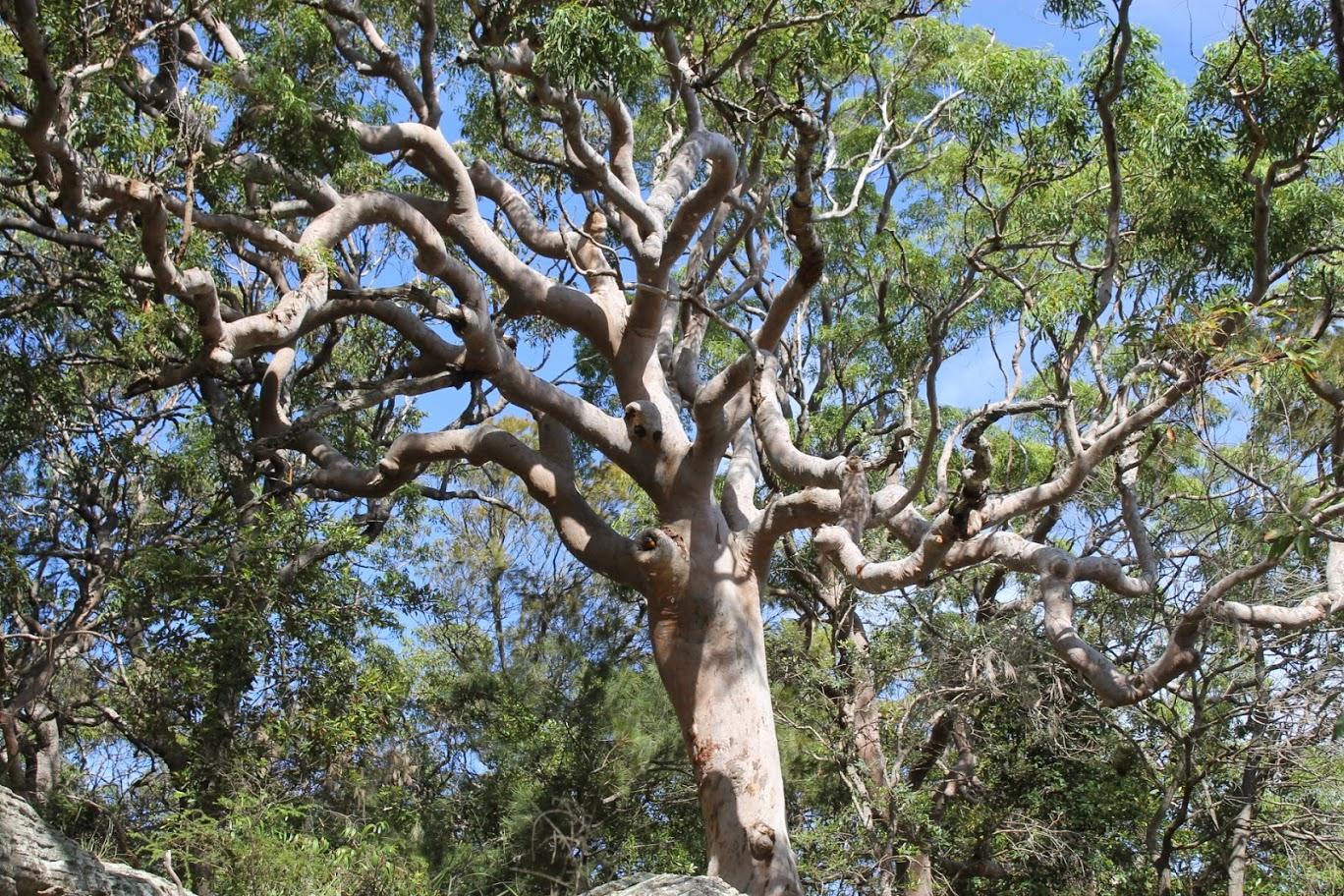
A group of local tree enthusiasts is inviting Avalon Beach residents to celebrate the suburb’s 100th anniversary by planting a tree.
Canopy Keepers convenor Deb Collins said Pittwater residents are surrounded by a unique urban tree canopy covering nearly 60 per cent of the area.
However, between 2009 and 2016 the Pittwater Local Government Area lost more canopy than any other in NSW - due to development and the removal of trees from residential land.
So to celebrate the naming of Avalon Beach 100 years ago, Canopy Keepers will plant at least 100 trees in the 2107 postcode in coming months, Ms Collins said.
Avalon Beach residents and others in the postcode area are therefore invited to apply for one of these trees at no cost, to plant and care for the next generation of canopy, she said.
“We are looking for 100 recipients - 100 new Canopy Keepers,” Ms Collins said.
“Will you help us grow the future and become a canopy keeper, so that we can ensure our children and grandchildren enjoy the benefits of our wonderful urban forest?” Ms Collins said.
“The radical changes to our environment are not just upsetting residents.
“Forty per cent of all wildlife relies on a connected canopy to nest, raise their young and travel between food and water sources.
“The simple removal of ‘just one tree’ can break a critical link in a canopy pathway and threaten the habitat of wildlife such as Squirrel gliders, Powerful owls, and of course the much loved Koala, now extinct from our area but remembered here by so many of us from our childhood.
“We can do much to prevent our wildlife and trees from suffering the same fate as the Koala.
“But it will take a noisy village to achieve this.
“Please join our growing community and ensure Avalon and Pittwater in 100 years are as beautiful as they are today.”
Residents are asked to fill in the following form before December 10 and Canopy Keepers will offer you a tree that is best suited to where you live.
https://forms.gle/hPAVdU5qYT4YzgAc6
Otherwise please email Canopy Keepers at 100trees@canopykeepers.org.au
Find Canopy Keepers at the Avalon car boot sale, on Sunday December 19, where registered tree recipients will be able to pick up their trees for planting.
Canopy keepers is a local group dedicated to the preservation and regeneration of tree canopy in our local area. We want to link arms with all our neighbours and bring to life the vision of homes amongst the trees not shrubs along the edge.
Find out more at: www.canopykeepers.org.au
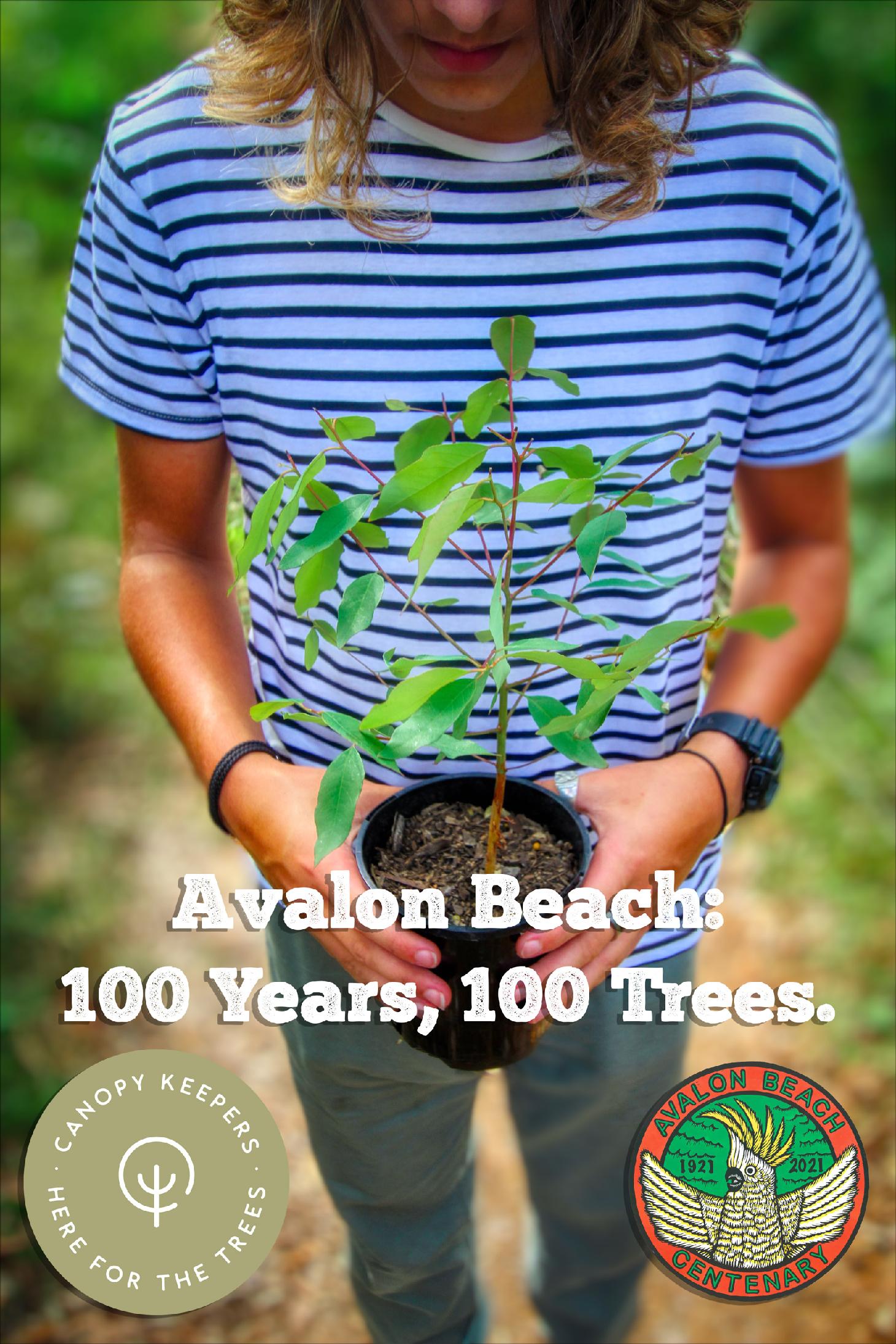
November 2021 Forum For Friends Of Narrabeen Lagoon Catchment: Fishing Bats And Water Rats (Rakali)
.jpg?timestamp=1631741816240)
.jpg?timestamp=1631741908384)
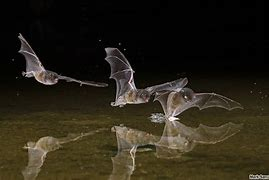
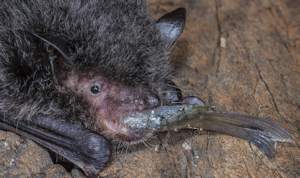
More Good News For The Critically Endangered Orange-Bellied Parrot!
BirdLife Australia: November 23, 2021
This breeding season is one of their most successful in recent years – so far, we’ve seen 52 Orange-bellied Parrots return from the Australian mainland (where they spend the winter) to their only known breeding site in Melaleuca, Tasmania.
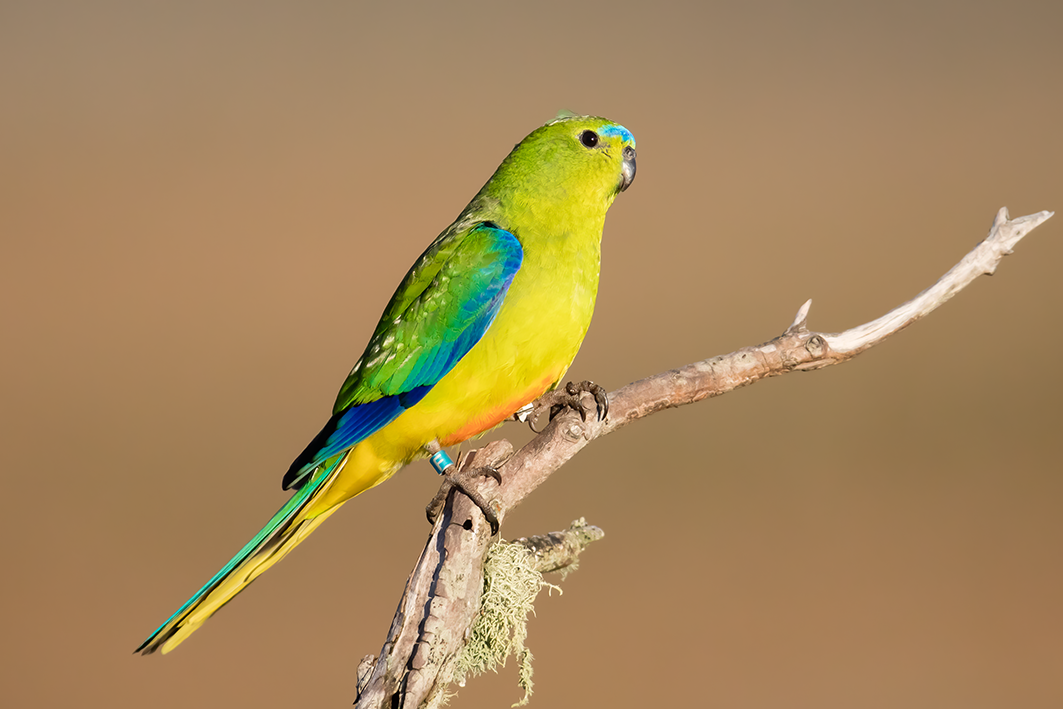
These very promising numbers include 34 wild-bred parrots and 18 captive releases that were released earlier in the year. Last year, 51 birds made the journey.
Just 5 years ago, their population had plummeted to only 17 birds – but now, things are finally looking up for these very special parrots.
This is the hard-won result of careful management and several successful captive releases. In recent years, dozens of captive-bred Orange-bellied Parrots have been released into the wild at sites across Victoria as part of the Mainland Release Trial ‒ a project to boost the small population of this species.
This is part of the Orange-bellied Parrot Mainland Recovery Program ‒ a collaboration between government and non-government organisations, community groups and zoos.
To learn more about our work with these rare parrots, visit: birdlife.org.au/orange-bellied-parrot-recovery
Photo: Orange-bellied Parrot by John Barkla
Migratory Bird Season
Boobook Owl And Baby Possum Rescue; Sydney Wildlife Rescue Volunteer - Nesting Boxes Available - All Sales To Sydney Wildlife
Helen Pearce is one of our local Sydney Wildlife volunteers - last week she got a call for a raptor rescue.
Helen says; ''As a licensed wildlife rescuer, I get to deal with some pretty cool animals, but today was a beautiful privilege.
Sydney Wildlife Rescue had a call at about 8:30 this morning for an owl on the ground. Thinking it’d be a Tawny chick (who is not an owl, not even a nightjar, but has very recently been reclassified in its own classification order), but preparing for a Powerful Owl, I set out with all necessary equipment. When I arrived, I found the most gorgeous fledgling Boobook owl. What a cutey!
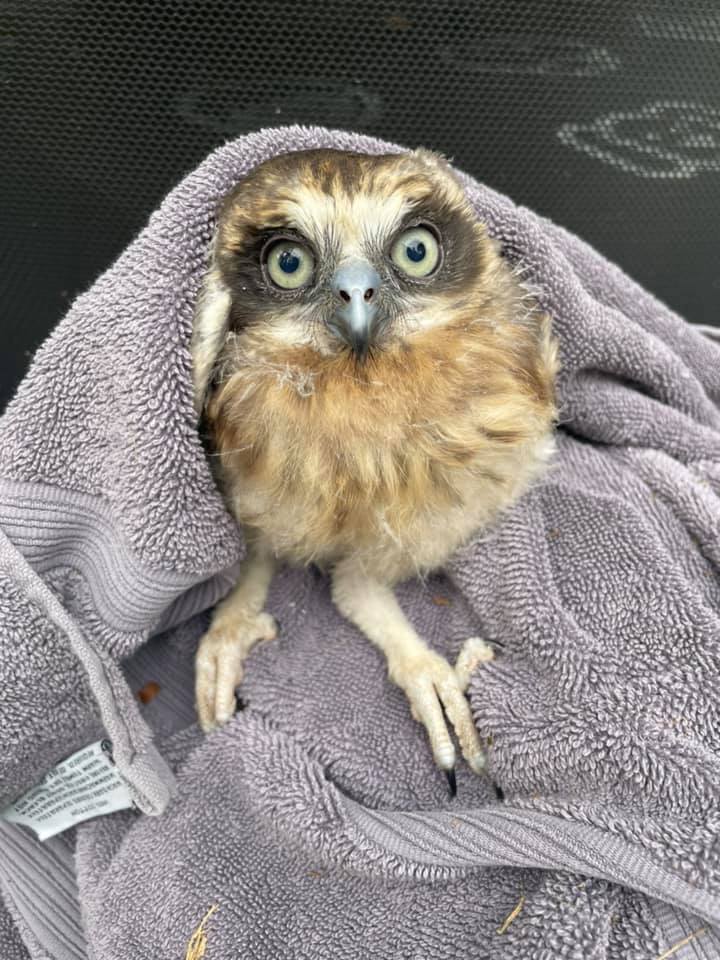
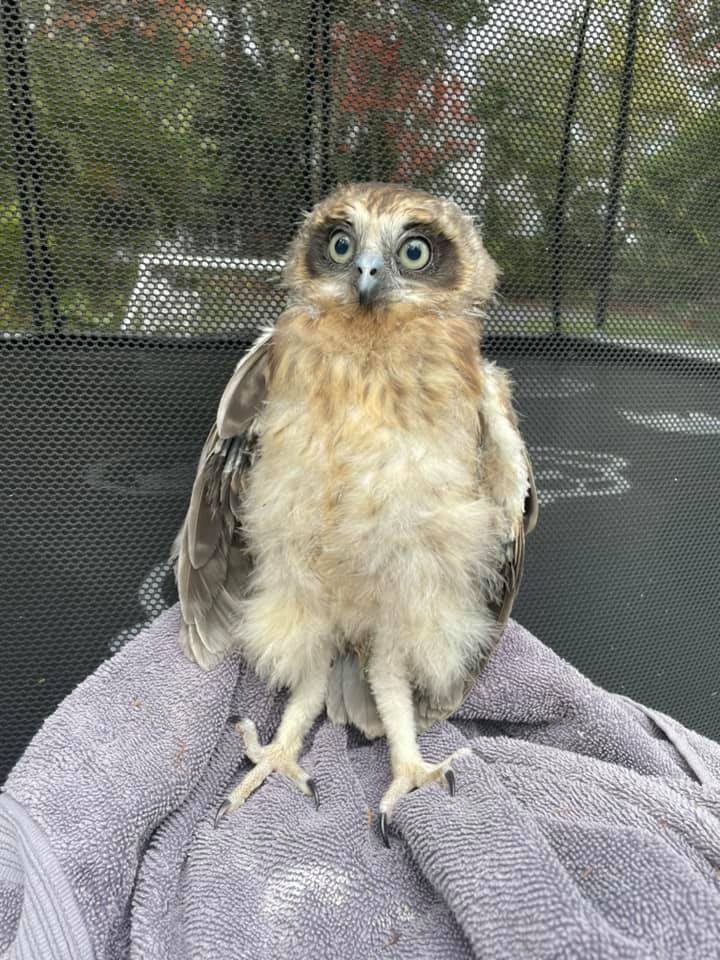
The parents were around and watching and rather concerned as to what we were going to do with their precious baby. Fluttering between Jo’s and Lisa Yost Palmer ‘s garden, I caught the petrified little fluffball of claws and sharp beak and we formulated a plan.
Having consulted with SWR’s experienced raptor coordinator, we made a make-shift nest and Jo and Lisa’s amazing husbands scaled a tree and started fixing the new ‘nest’ as high as we practically could and placed ‘Fluffy’ in.
This evening, mum and dad have tended to the chick and there’s a second chick still in the original nest!
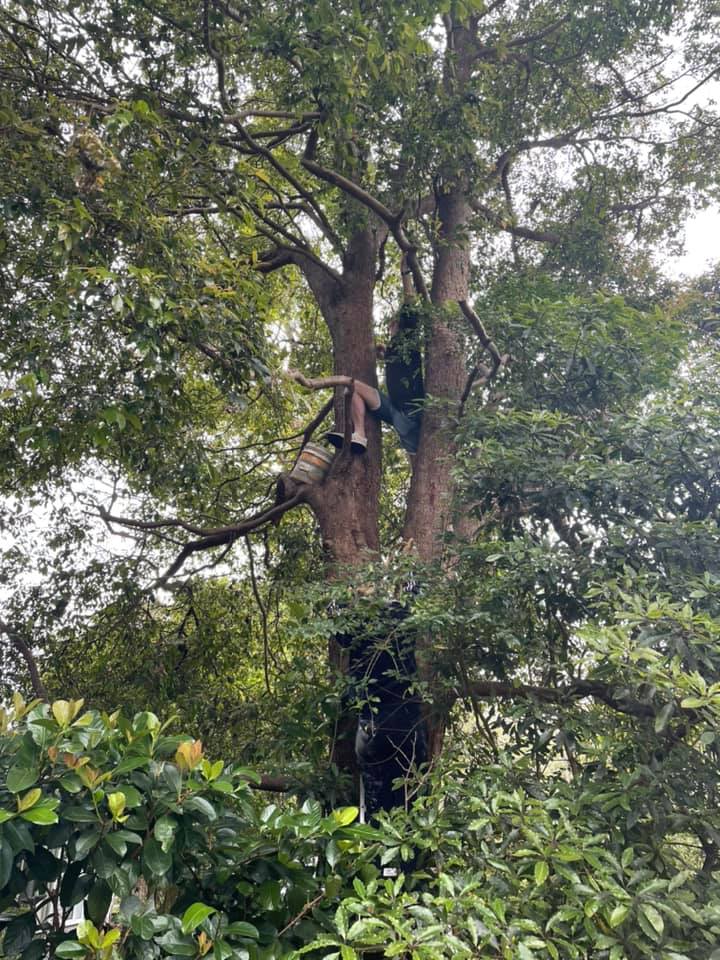
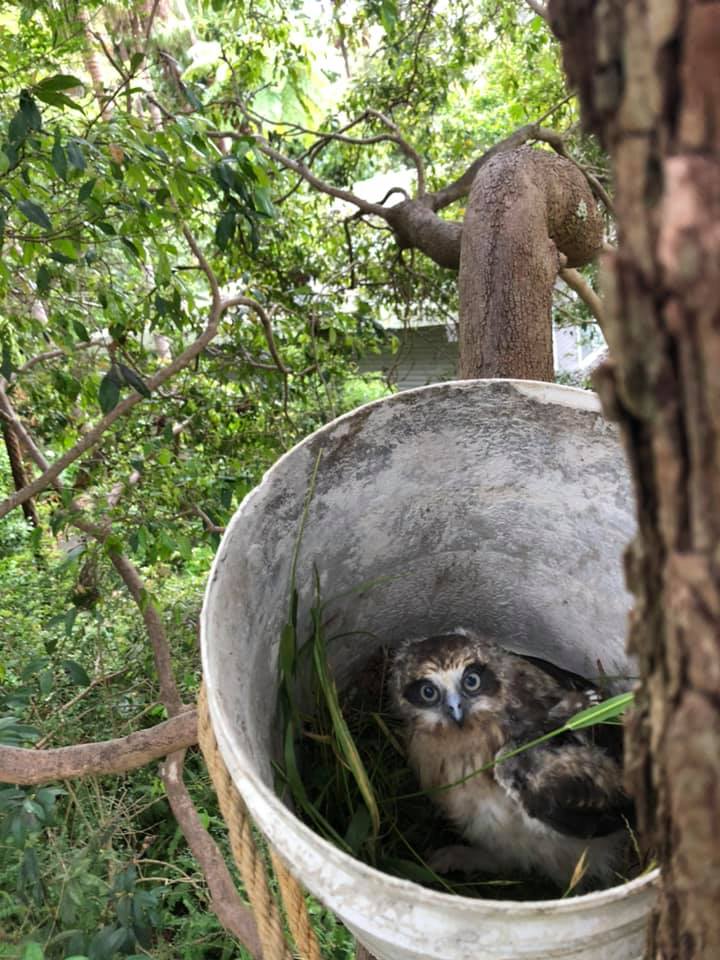
I’d like to extend my massive thanks to all involved for the effort made to help these birds. It’s great to know there’s people like these guys who care so deeply about our wildlife. Chicks of all species are fledging at the moment and may need a little extra help from us humans.''
The other recent rescue Helen has attended is a baby possum. More and more of these are coming into care as their tree homes are cut down without any checking to see if they are already inhabited by our wildlife.
Helen says;
''It’s baby season! And I have a huge soft spot for brushtail possums.
The little guy in this photo is a 300g brushtail Joey. He was found all alone, in the middle of the day on a concrete slab by the side of a building. How he wasn’t already dead, I don’t know. Cats, dogs, birds, snakes, humans……hunger, dehydration, exposure to the sun, wind, cold……either way, he’s a very lucky boy. What happened to his mum is unknown.
He’s very scared. He doesn’t know what’s happened to him, who this strange thing is who’s trying to feed a funny-tasting milk to him, where his mum is. He cries at night, calling for his mum, but she doesn’t come.
He will settle in a day or two and get used to the new milk (which is a specialised marsupial milk, purely for his stage of development. Other various types of milks can kill him) and he’ll begin to trust me, but I can’t replace his mum.
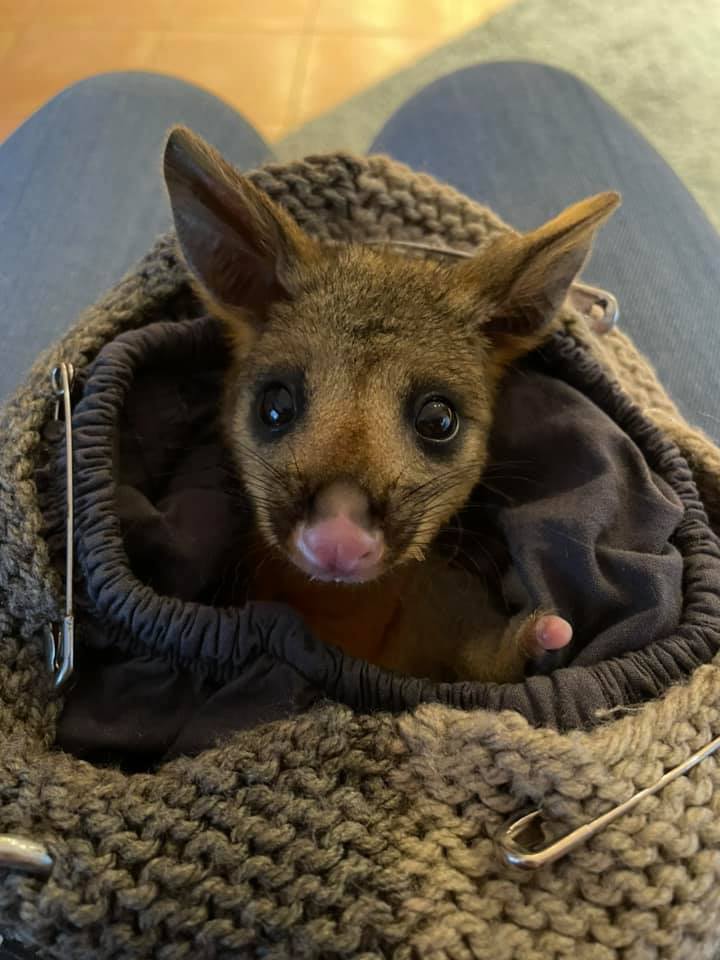
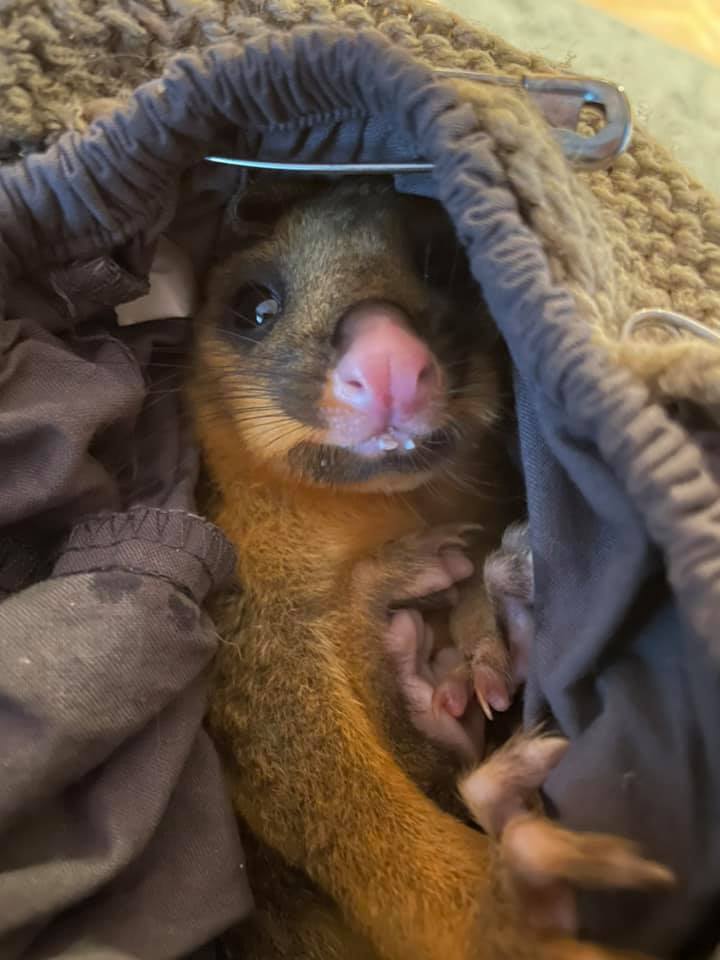
If you find a Joey on its own, it needs help. If you find one, please try to contain it and keep it safe from predators and exposure and call either Sydney Wildlife (Sydney Metropolitan Wildlife Services) or WIRES. If you find a dead possum (ringtail or brushtail), please check the pouch for a Joey. Brushies generally have one but ringtails will have 2, sometimes three. If you are unable to, that’s ok, but please call it in to a wildlife organisation so someone can attend to it.
If you find a native animal in need, or if you have concerns, please call either
Sydney Wildlife Rescue - 02 9413 4300
Or WIRES - 1300 094 737
NB: Please do not attempt to handle a raptor, snake or other wild animals unless you are trained as you may cause injury to them or yourself.
Nesting Boxes Available
We are licensed wildlife rescuers with Sydney Wildlife Rescue and have been making more and more wildlife boxes, both for our releases and for members of the public.
As fewer nesting areas are available and tree hollows are becoming rarer, as development takes over, our native wildlife are struggling. We have decided to make more boxes and sell them to the community with all profits going back to Sydney Wildlife.
They can either be painted and sealed to make them weatherproof or unsealed for you to paint yourself as a fun activity for the family to add your own personal touch.
The possum boxes will all have an access branch on the front. The Kookaburra boxes have an access tunnel to mimic a tree hollow.
Please email me if you’d like to purchase one at helenjanepearce@yahoo.com

Photos: Helen Pearce
Draft Cycling Strategy For NSW's National Parks
The Draft Cycling Policy, Draft Cycling Strategy and Draft Cycling Strategy: Guidelines for Implementation is on public exhibition until 30 January 2022.
The scope of this new strategy is broad. It includes all types of cycling experiences in our parks. It is complemented with a more detailed set of guidelines for implementation and updates to our Cycling policy.
- The Draft Cycling policy builds upon our experience from previous versions and has been updated in parallel to the draft strategy. It identifies in a legislative framework where cycling is permissible in parks.
- The Draft Cycling Strategy outlines our vision, objectives and priorities for the provision of cycling experiences.
- The Draft Cycling Strategy: Guidelines for Implementation provides further details on the processes and procedures that National Parks and Wildlife Service (NPWS) will apply to assess, approve, manage and monitor cycling opportunities within NPWS estate as detailed in the Cycling Strategy.
- The draft Cycling Strategy sets a precedent for managing the conservation of natural and cultural heritage values in our parks as a priority and then allows for the development of compatible cycling opportunities. Not all cycling activities will be suitable in all parts of parks.
- The draft Cycling Strategy details a clear framework for how we seek to provide for, and manage, cycling opportunities within parks. The processes for cyclists to work with National Parks and Wildlife Service are made clear. We intend to work collaboratively with stakeholders and other land managers to tackle key challenges including, unauthorised tracks, the safety and enjoyment of visitors on multi-use trails and the provision of park visitor facilities.
- The draft Guidelines for Implementation address the way we will deliver the Cycling Strategy, including the approval process for new tracks and networks, the rehabilitation of unauthorised tracks, how we will work with external parties (including volunteer groups) and our management of cycling experiences. These documents will replace the Sustainable Mountain Biking Strategy 2011.
Public online presentation
You are invited to an online public presentation on Wednesday, 1 December, 12:00 – 1:00pm. Please register to attend this presentation.
Your feedback on the draft Cycling Policy, strategy and implementation guideline documents is valued. Our response to your submission will be based on the merits of the ideas and issues you raise rather than just the quantity of submissions making similar points. For this reason, a submission that clearly explains the matters it raises will be the most effective way to influence the finalisation of the plan.
Submissions are most effective when we understand your ideas and the outcomes you want for park management. Some suggestions to help you write your submissions are:
- write clearly and be specific about the issues that are of concern to you
- note which part or section of the document your comments relate to
- give reasoning in support of your points - this makes it easier for us to consider your ideas and will help avoid misinterpretation
- tell us precisely what you agree/disagree with and why you agree or disagree
- suggest solutions or alternatives to managing the issue if you can.
Have your say by Thursday 30 January 2022.
There are three ways to provide feedback:
Formal submission: Address: Manager, NPWS Planning Evaluation and Assessment Locked Bag 5022 Parramatta NSW 2124
IPART: Climate Change Prioritised
- Climate change is one of the most significant issues that will impact the lives of people in NSW now and into the future.
- Climate change presents far-reaching economic, social, ecological, health and safety risks. These include direct physical risks, such as extreme weather events, and transitional risks from adjusting to a net zero economy.
- These risks present challenges in the sectors we regulate including water, energy, transport and local government. In this context, we aim to make decisions that mean the people of NSW and future generations will continue to benefit from safe, reliable and affordable services that meet their needs over the long term.
- We consider climate change risks when undertaking our regulatory functions or reviews. We encourage solutions that mitigate or adapt to climate change by our regulated entities or industries based on science, innovation and economics.
- emissions reductions
- standards for safe and reliable services
- protecting the environment
- acting in the long-term interests of consumers.
- managing the physical, transitional and liability risks of climate change to meet its obligations
- acting consistently with the NSW Government policy on climate change.
- communicating our expectation that regulated entities and industries meet their obligations to address the risks of climate change
- considering information provided by the regulated entity or stakeholders that responds to climate change risks. This could include pricing proposals, compliance reports, energy savings proposals, risk assessments, asset management, safety management systems, and submissions from stakeholders
- asking for further or specific information from the regulated entity if we do not have sufficient information to satisfy our consideration of a statutory obligation.
La Niña Established In The Tropical Pacific
La Niña Established In The Tropical Pacific- November 23, 2021: BoM
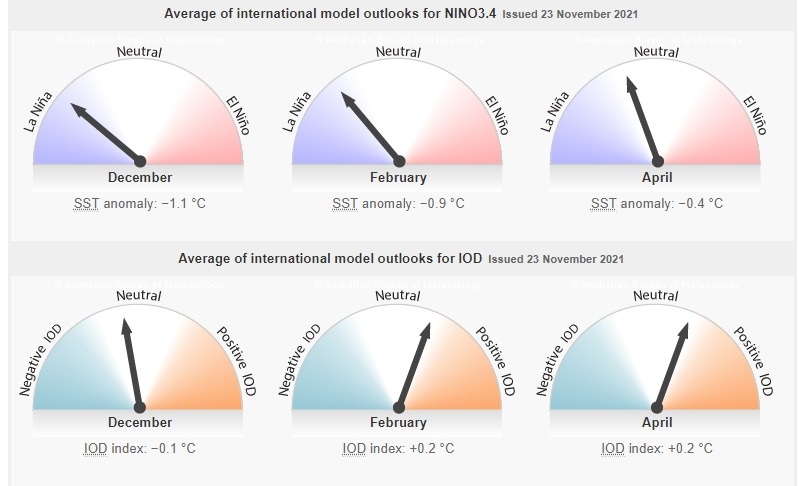
Seasonal Bushfire Outlook
November 25, 2021
Today AFAC News the National Council for Fire and Emergency Services has released the summer bush fire outlook. High grass and crop fuel loads have been reported for many areas, particularly west of the great divide. Recent rain could lead to continued growth and above normal fire potential if these fuels dry out during summer. A wetter forecast and lower fuel loads could see below normal fire potential for forested areas affected by the 2019/20 fire season. Areas east of the divide not affected in that fire season will see normal fire potential.
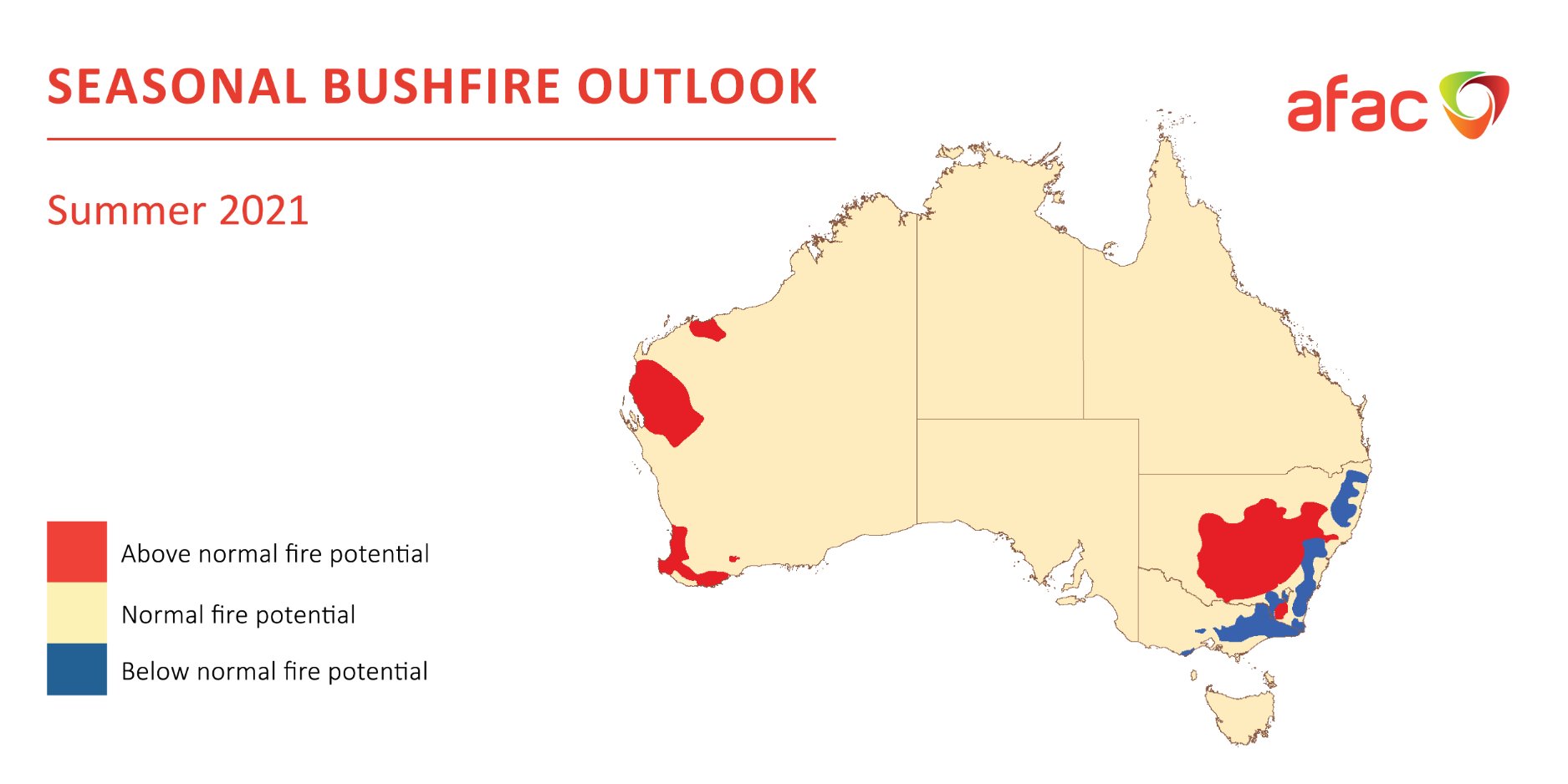
Now is the time to update and discuss your bush fire survival plan and know what you and your family will do if fire threatens. www.myfireplan.com.au
Full outlook here: https://www.afac.com.au/docs/default-source/bushfire-seasonal-outlook/seasonaloutlook_summer_2021_v1-0.pdf
Final Kosciuszko Wild Horse Plan Released
November 24, 2021
The final plan for the management of wild horses in Kosciuszko National Park has been released providing certainty for local communities and for all who value the park's unique environment. Environment Minister Matt Kean said the final plan strikes the right balance between protecting the heritage value of the wild horses and maintaining the exceptional conservation values of our state's largest national park.
"Kosciusko National Park is a very special place that needs to be protected for future generations," Mr Kean said.
"Today we release a plan that will finally provide protection for the numerous threatened species and the suite of important alpine and sub-alpine ecosystems that call Kosciuszko National Park home."
"Based on consultation with scientific and community representatives, Aboriginal stakeholders and over 4000 public submissions, we can finally deliver a clear direction for one of the most special environment's anywhere in the country."
The plan provides for a staged reduction in the overall wild horse population from an estimated 14,380 horses in the 2020 survey to 3000 horses by 30 June 2027.
Across the park, the plan provides for three broad management areas:
- areas in which wild horses will continue to occupy – 32% of the park
- areas from which wild horses will be removed – 21% of the park
- areas which are currently free of horses and which will be kept free – 47% of the park.
The removal of wild horses will occur in accordance with best practice animal welfare requirements.
Member for Monaro John Barilaro said the plan was the culmination of years of work from a number of very passionate people who care deeply about the issue.
"I am so proud that we have been able to deliver certainty within my local electorate on this important issue, it has been years in the making" Mr Barilaro said.
"This final plan gives everybody certainty by delivering a way to manage a sustainable population of wild horses in only very select areas of the park, but more importantly it recognises their important heritage value for future generations."
The areas in which horses may continue to occur are those areas with the strongest links to wild horse heritage values and are areas with connections to historic pastoralism, brumby running and include wild horses derived from historic pastoral populations (e.g., the Kiandra greys).
The removal and exclusion of wild horses from designated areas, and the reduction in the overall population, will provide effective protection from the impacts of wild horses for many threatened species.
These include the northern and southern corroboree frogs, the smoky mouse and the broad-toothed rat as well as a suite of important alpine and sub-alpine ecosystems.
Annual surveys of the wild horse population will help monitor progress toward the targets in the plan.
The implementation of the plan is expected to begin immediately with the reintroduction of passive trapping and re-homing.
More information can be found at Kosciuszko National Park wild horse management.
Clean Up To Protect North Stockton Beach
November 22, 2021
Work crews will descend on North Stockton beach this week to remove buried waste that threatened to create a pollution hazard due to coastal erosion.
Minister for Water, Property and Housing Melinda Pavey said about 3,500 cubic meters of waste will be removed near Corroba Oval across an area of about 30 meters by 15 meters.
“This work will protect North Stockton’s coastline after erosion threatened to expose buried waste from a former City of Newcastle landfill site,” Mrs Pavey said.
“Our priority is to ensure the environment and sea life are protected and that the area can be safely rehabilitated for future community use.”
The excavation work follows installation of a temporary sandbag seawall in September to secure the site while planning got underway to remove the waste.
Barrier fencing has been erected and members of the public advised not to enter the area while work is underway.
“Excavators will dig out the waste which will be tested and then taken away to Summerhill Waste Management Centre,” Mrs Pavey said.
“Once the site is assessed as cleared it will be backfilled with sand and restored to its natural state.”
The work is being undertaken by the Department of Planning, Industry and Environment – Crown Lands and the Soil Conservation Service with support from Hunter Water and the Environment Protection Authority (EPA).
Consultations have occurred with City of Newcastle and the Worimi and Karuah Local Aboriginal Land Councils.
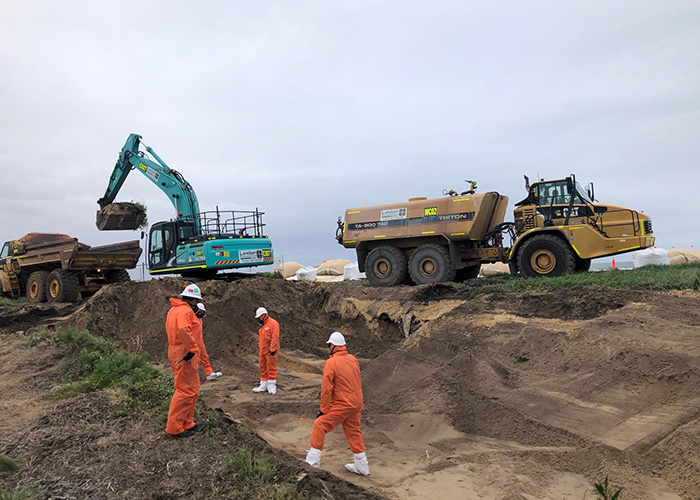
Work crews removing buried waste on North Stockton Beach.
BASIX Higher Standards: Feedback Open
The NSW Government are improving BASIX standards to build more comfortable homes, cut energy costs and contribute to our target of net zero homes by 2050.
This is part of the Trajectory for Low Energy Buildings, a national plan that aims to achieve zero energy and carbon-ready buildings. The plan proposes increases to the energy efficiency provisions in the National Construction Code (NCC) for residential buildings from 2022.
What do the proposed new standards mean:
- Cheaper energy bills. You’ll use less electricity so your bills will be cheaper – saving as much as $980 a year on energy bills.
- More comfortable homes. Your home will be naturally cooler in summer, warmer in winter, which means you won’t be turning the heater or air conditioner on as often
- Fewer carbon emissions. This contributes towards our goal of net zero homes by 2050
The proposed higher standards
Te NSW Department of Planning welcome feedback on the proposed increases to BASIX standards. The proposed changes can be found in the Proposed BASIX Higher Standards document. This document shows a map of the climate zones in NSW.
The proposed thermal performance and energy standards vary according to climate zones.
The tables show the proposed maximum allowable thermal loads and the energy standards for the climate zones.
Technical information about the changes
The proposed BASIX thermal performance and energy standards vary depending on;
- location based on climate
- building type for apartment buildings
Standards for most new residential buildings are proposed to increase across NSW from late 2022. Exceptions include apartment buildings up to 5 storeys and properties in the NSW North Coast climate zone.
The North Coast climate zones where standards won’t be changed are climate zones 9, 10 and 11 defined by the Nationwide House Energy Rating Scheme (NatHERS). They are predominantly on the NSW North Coast but also include Port Stephens and Maitland.
Other documents
Proposed BASIX Higher Standards
Cost Benefit Analysis report
BASIX Higher standards FAQ
Have your say
The government welcome your feedback on the proposed BASIX higher standards from Wednesday, 17 November until January 17 2022. The BASIX higher standards exhibition aligns with the Design and Place SEPP exhibition.
The exhibitions will close on the same day, currently expected in January 2022.
Visit: www.planningportal.nsw.gov.au/draftplans/exhibition/basix-higher-standards
Home Design To Drive Energy Bills Down
November 22, 2021
New sustainability standards for homes will save residents up to $980 a year on energy bills and reduce the State’s carbon footprint as we move to net-zero emissions by 2050.
The Building Sustainability Index (BASIX) is a key assessment tool that ensures new homes are comfortable to live in regardless of the temperature, are more energy efficient and save water.
Minister for Planning and Public Spaces Rob Stokes said BASIX had prevented 12.3 million tonnes of greenhouse gas over the past 17 years – equivalent to taking 2.5 million cars off the road.
“These proposed increases in standards will see more energy-efficient homes from Double Bay to Dubbo and beyond, with better design, better insulation, more sunlight and more solar panels,” Mr Stokes said.
“We want to lift BASIX standards even higher to drive down emissions further, saving another 150,000 tonnes a year and helping to achieve net-zero emissions by 2050.
“Better design will keep your home naturally cooler in summer and warmer in winter, so you won’t be turning the heater or air conditioner on as often.
Energy bills are expected to reduce significantly as a result of the new BASIX standards:
- Savings of up to $190 each year for people living in high-rise apartments;
- Savings of up to $850 each year for people living in new Western Sydney houses; and
- Savings of up to $980 a year for people living in new houses in the regions.
“To showcase the benefits of these new measures, we’re inviting up to 10 builders to test the proposed BASIX requirements ahead of its official roll out next year,” Mr Stokes said.
These new targets complement work underway, such as planting one million trees and investing $4.8 million to make building materials more environmentally friendly.
The community is encouraged to provide feedback on the proposed BASIX changes by Monday 31 January, 2022 at planningportal.nsw.gov.au/BAS IX- standards
Draft Marine Park Management Plan Released
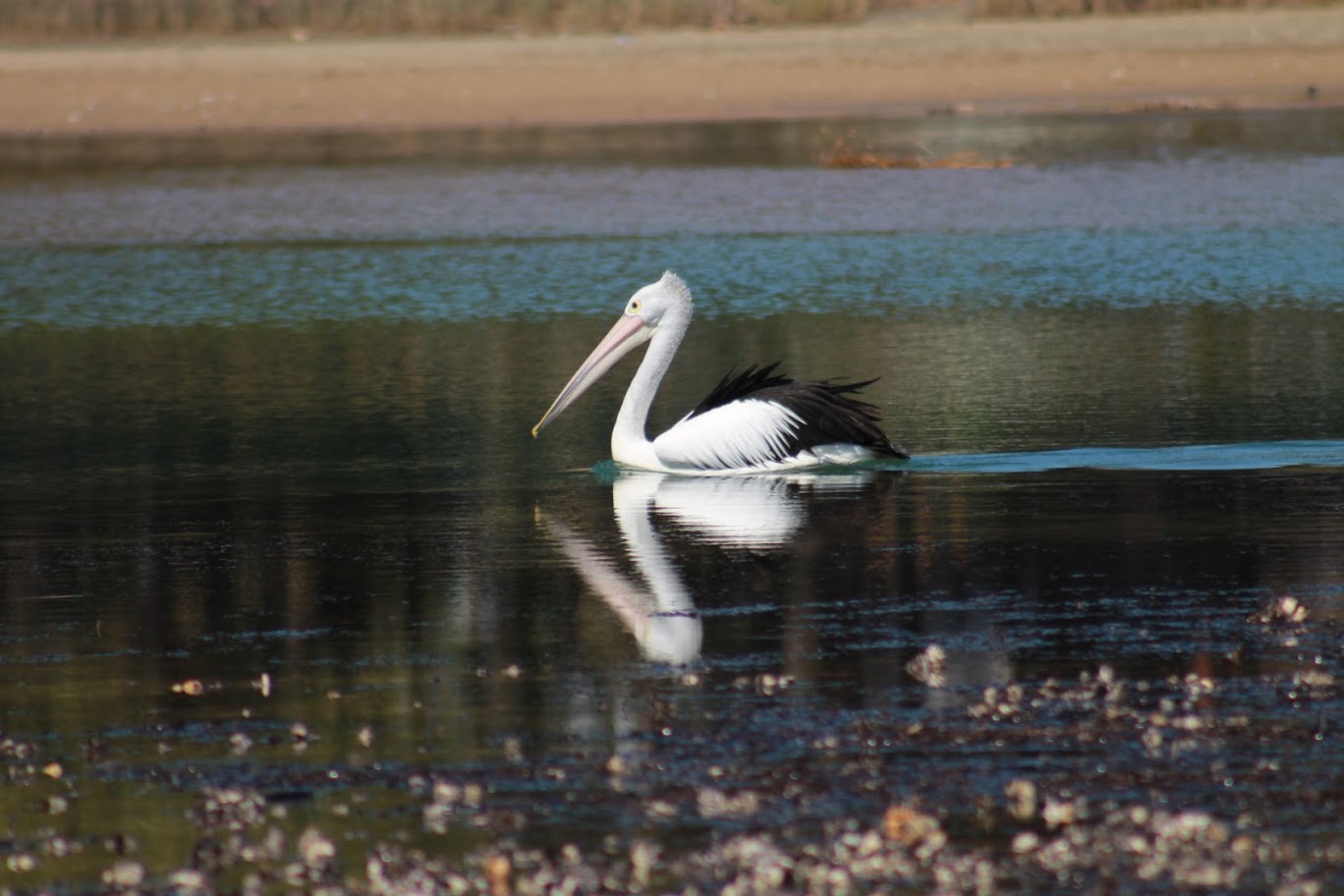
Antarctic Ice-Sheet Destabilized Within A Decade
After the natural warming that followed the last Ice Age, there were repeated periods when masses of icebergs broke off from Antarctica into the Southern Ocean. A new data-model study led by the University of Bonn (Germany) now shows that it took only a decade to initiate this tipping point in the climate system, and that ice mass loss then continued for many centuries. Accompanying modelling studies suggest that today's accelerating Antarctic ice mass loss also represents such a tipping point, which could lead to irreversible and long-lasting ice retreat and global sea level rise. The study has now been published in the journal Nature Communications.
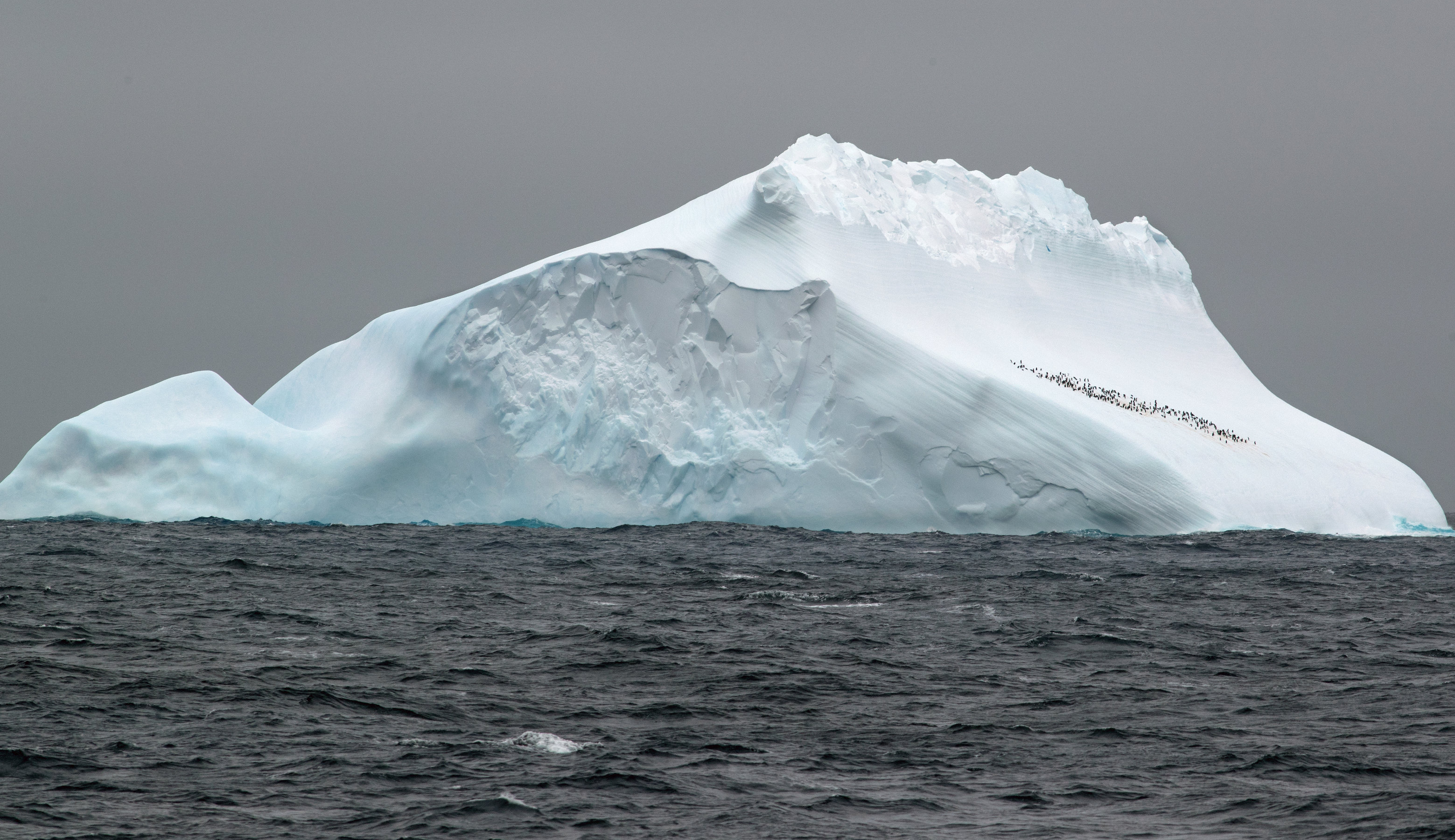
Iceberg in Antarctica © Uni Bonn/ Michael Weber.
To understand what the consequences of current and future human-induced climate warming may be, it helps to take a look at the past: how did sea-level changes look like during times of natural climate warming? In a recent study, an international research team led by Dr. Michael Weber from the Institute of Geosciences at the University of Bonn investigated this question. In doing so, they focused on the Antarctic Ice Sheet as the largest remaining ice sheet on Earth.
There, they searched for evidence of icebergs that broke off the Antarctic continent, floated in the surrounding ocean and melted down in the major gateway to lower latitudes called "Iceberg Alley." In the process, the icebergs released encapsulated debris that accumulated on the ocean floor. The team took sediment cores from the deep ocean in 3.5 km water depth from the area, dated the natural climate archive and counted the ice-rafted debris.
The scientists identified eight phased with high amounts of debris which they interpret as retreat phases of the Antarctic Ice Sheet after the Last Glacial Maximum about 19,000 to 9,000 years ago, when climate warmed and Antarctica shed masses of icebergs repeatedly into the ocean. The result of the new data-model study: each such phase destabilized the ice sheet within a decade and contributed to global sea-level rise for centuries to a millennium. The subsequent re-stabilization was equally rapidly within a decade.
The research team found three other independent pieces of evidence for such post-glacial tipping points: Model experiments showing the melting of the entire Antarctic ice sheet, a West Antarctic ice core documenting ice-sheet elevation draw-down and drill cores revealing a step-wise ice-sheet retreat across the Ross Sea shelf.
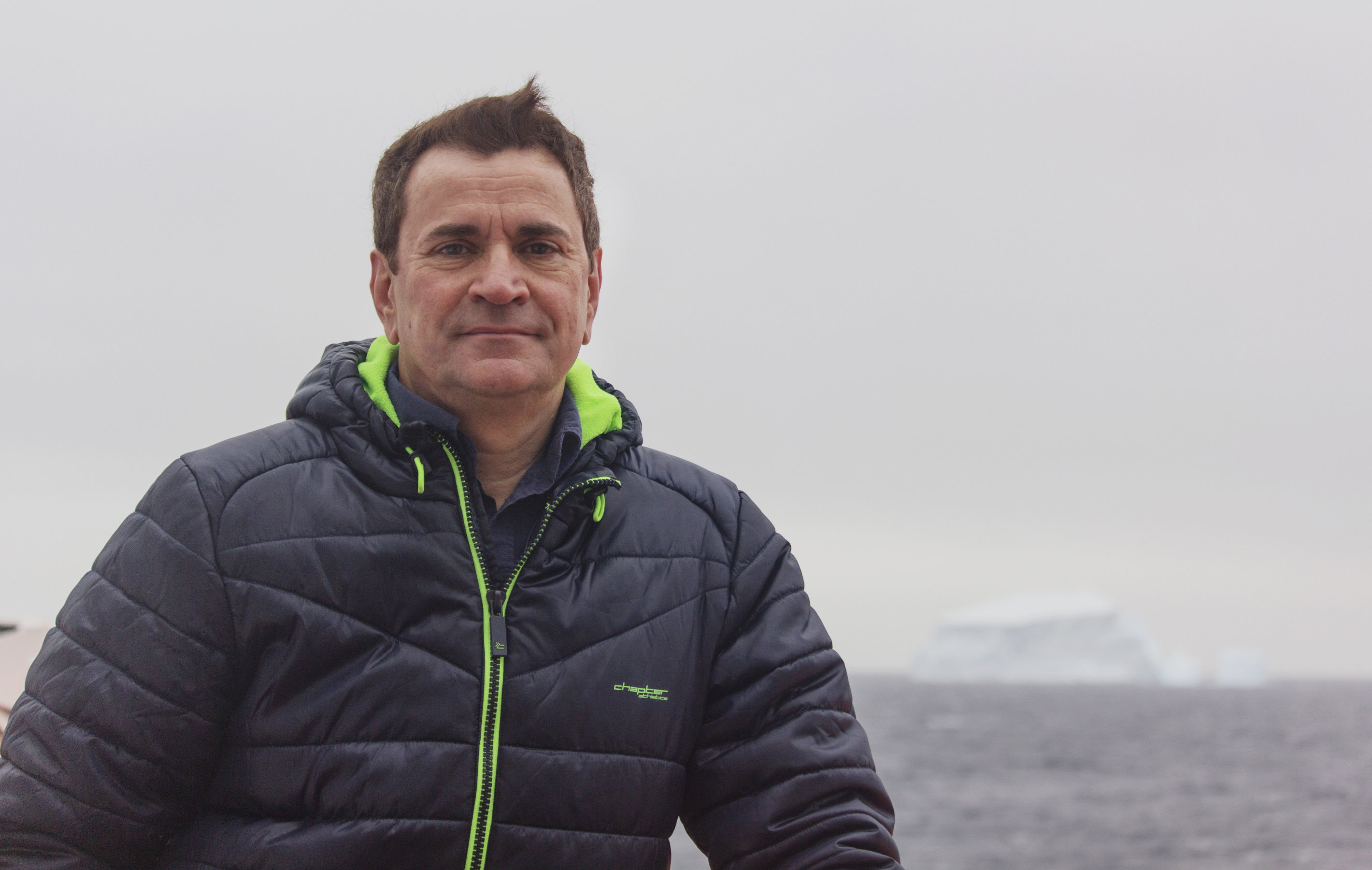
Study leader - Dr. Michael Weber from the Institute of Geosciences at the University of Bonn© Uni Bonn/ Michael Weber
Today's ice mass loss could be start of long-lasting period
The results are also relevant for ice retreat observed today: "Our findings are consistent with a growing body of evidence suggesting the acceleration of Antarctic ice-mass loss in recent decades may mark the begin of a self-sustaining and irreversible period of ice sheet retreat and substantial global sea level rise," says study leader Dr. Michael Weber from the University of Bonn.
Combining the sediment record with computer models of ice sheet behaviour the team showed that each episode of increased iceberg calving reflected increased loss of ice from the interior of the ice sheet, not just changes in the already-floating ice shelves. "We found that iceberg calving events on multi-year time scales were synchronous with discharge of grounded ice from the Antarctic Ice Sheet," said Prof. Nick Golledge from the University of Wellington (New Zealand), who led the ice-sheet modelling.
Dr. Zoë Thomas, a co-author of the study from the University of New South Wales in Sydney, Australia, then applied statistical methods to the model outputs to see if early warning signs could be detected for tipping points in the ice sheet system. Her analyses confirmed that tipping points did indeed exist. "If it just takes one decade to tip a system like this, that's actually quite scary because if the Antarctic Ice Sheet behaves in future like it did in the past, we must be experiencing the tipping right now," Thomas said.
According to Weber, "Our findings are consistent with a growing body of evidence suggesting the acceleration of Antarctic ice-mass loss in recent decades may mark the begin of a self-sustaining and irreversible period of ice sheet retreat and substantial global sea level rise." When we might see the eventual stabilization of the ice sheet is unknown, because it will depend significantly on how much future climate warming occurs.
Michael E. Weber, Nicholas R. Golledge, Chris J. Fogwill, Chris S. M. Turney, Zoë A. Thomas. Decadal-scale onset and termination of Antarctic ice-mass loss during the last deglaciation. Nature Communications, 2021; 12 (1) DOI: 10.1038/s41467-021-27053-6
Climate change is likely driving a drier southern Australia – so why are we having such a wet year?
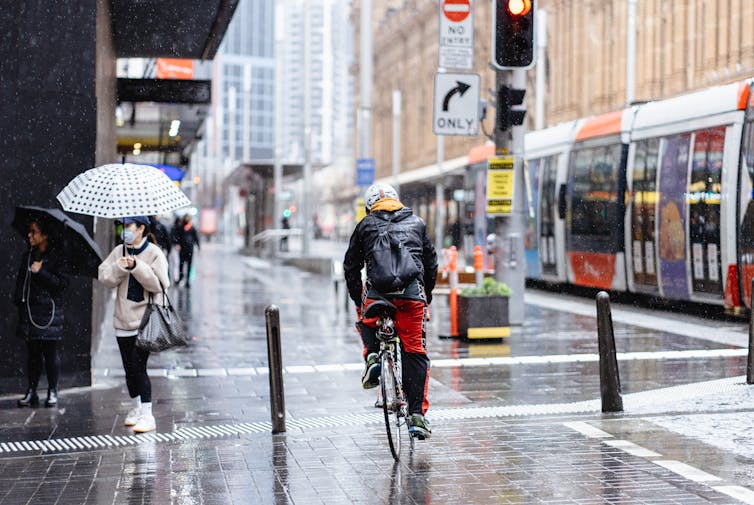
As the climate changes, southern Australia is likely to keep getting drier on average, particularly in the southwest.
However, this year has been wet. And yesterday the Bureau of Meteorology announced we are now in another La Niña event. This common large-scale climate pattern lasts for months, and will increase the odds of further wet weather across the country.
So despite the long-term trend towards drier conditions, we find ourselves in a wetter-than-usual period. What gives?
Current Climate Change Assessments
Rainfall has been declining in much of southern Australia in recent decades (see below). The Intergovernmental Panel on Climate Change’s Sixth Assessment report – which draws on the latest climate research – found the recent drying trend in southern Australia is likely to continue, particularly during the cool season.
Cool-season rainfall in southwest Western Australia has already decreased, and ongoing drying in this area is assessed to be very likely. There’s strong evidence this trend contains a “signal” of climate change, otherwise known as a climate change “fingerprint”.
We understand the drying has been driven by changes in dominant weather patterns. And future projections of drying in the southwest are among the strongest in the world.
The situation in the southeast of Australia is not as clear, but there’s strong evidence for an ongoing decrease in rainfall here, too.
Yet, we find it has been wet in many southwest and southeast regions this year – including in the cool season. In fact, some areas received “very much above average” rainfall in the ten months to the end of October, seemingly defying the drying trend.
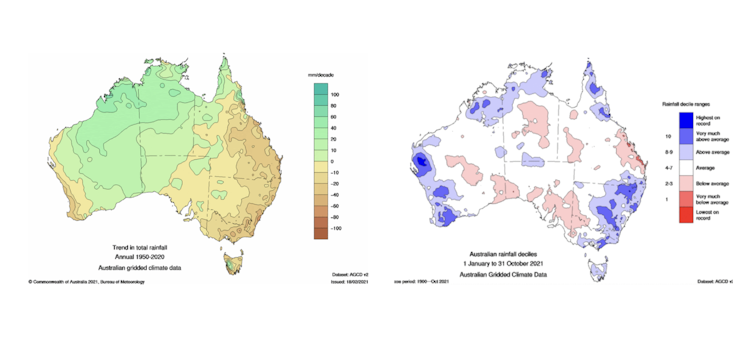
Variability Is King In Australia
Australia has always been the land of droughts and flooding rains. It’s normal to be beset by a multi-year drought, before experiencing major floods. Year-to-year variability here is large compared with most of the world’s other land regions.
In 2021, we’ve seen a wet swing of the climate needle due to several global climate drivers. Alongside the Pacific now being in the La Niña phase, the Indian Ocean Dipole is in a negative phase.
When we see these drivers line up, we know the deck is stacked for a wetter season. This is what we’ve always found, and we can count on Australia’s climate variability to remain, through this century and beyond.
So does a wet year cast doubt on our assessment of climate change? No.
In the 2020 State of the Climate report, released by the CSIRO and the Bureau of Meteorology, we noted recent rainfall trends are tracking within projections.
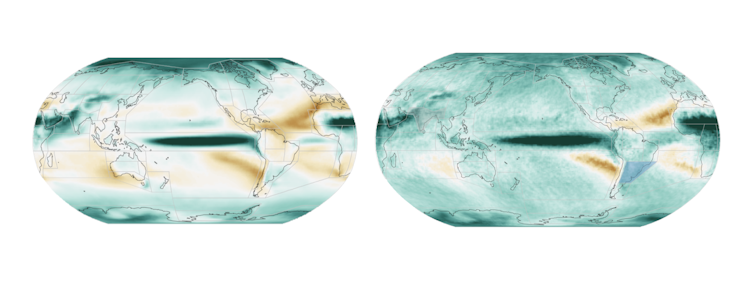
In fact, we showed rainfall trends since the baseline of 1986-2005 to 2020 are tracking in the dry end of projections for the southwest and Victoria. This suggests that if anything, the projections are likely conservative.
Of course there are wet years, such as this year and also Victoria in 2010. But the longer-term trend has been downward. This is consistent with what we expect from climate change, after drawing on multiple lines of evidence and climate modelling.
2021 is not extraordinary in the long-term context. Even if the whole of 2021 ends up being very wet, it won’t shift the long-term trend by much. Only a persistent wet trend over decades or longer would raise questions about our assessment of climate change and current projections.
What Does A ‘Drier’ Climate Look Like?
As the global climate warms, global average rainfall is increasing – and we expect most regions of the world will actually become wetter.
But there are some regions which will get drier, including southern Australia, the Mediterranean and southern Africa. So what will this look like?
A trend towards a drier climate will come with a lot of ups and downs. For example, between 1900 and 2020 southwest Western Australia’s annual rainfall varied between about 393mm and 1035mm (-40% and +55% from the average). This is a huge range.
Climate projections suggest a persistent rainfall reduction of up to 15% in the southwest of Australia is plausible over the first part of this century. Change later in the century will depend on whether we limit further climate warming.
If we do limit it, we can expect the rainfall to decrease by up to 20%. If we don’t, it will decrease by up to 35% – with larger reductions very plausible in the cool season. In either case, these projected average changes are still smaller than the year-to-year variability recorded in Australia over many decades.
But this doesn’t mean the trends and projections aren’t important. A persistent and ongoing shifting towards drier conditions, with drier (and hotter) dry spells is a huge challenge for Australia’s water managers and primary producers. And with a lower rainfall average, the chances of unprecedented dry periods are higher.
Wet Extremes Expected
But not every year will be a drought. There will still be wet days, months and years.
In fact, wet extremes are likely to increase despite the drying trend. Even in regions where the average rainfall is expected to decrease, there is a projected increase in intense rainfall bursts and rainfall extremes.
This includes intense hourly rainfalls that can lead to flash floods, as well as major rainfalls from “atmospheric rivers”, which are strong channels of concentrated moisture that stream through the atmosphere above us, delivering water for extreme rainfalls.
So for parts of southern Australia, a likely outcome is lower rainfall on average, but an increase in extreme rainfall events. With lower water availability overall, punctuated by intense flood risk, we can anticipate significant challenges ahead.![]()
Michael Grose, Climate projections scientist, CSIRO
This article is republished from The Conversation under a Creative Commons license. Read the original article.
Coal plants are closing faster than expected. Governments can keep the exit orderly
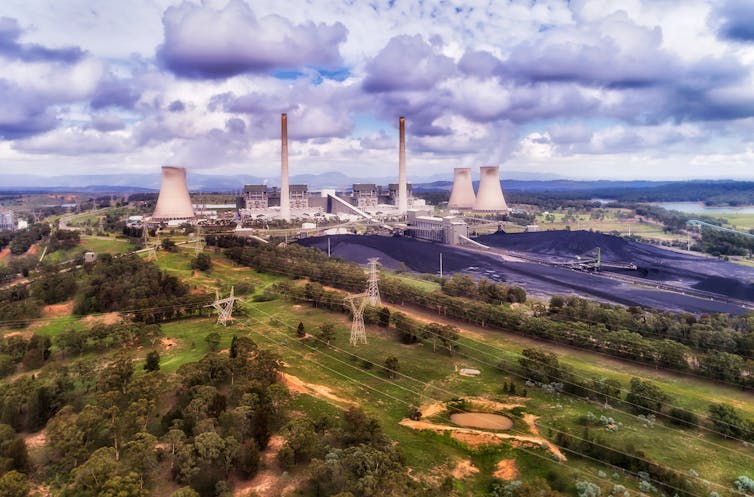
The international climate summit in Glasgow aimed to “consign coal power to history”. But while some major coal-consuming countries have agreed to phase out the fossil fuel in the 2030s, Australia is not one of them.
Under its recently released plan to reach net-zero emissions by 2050, the federal government modelled a scenario where the electricity sector still burns coal in 2050 – but only a very small amount.
Despite the federal government’s insistence on keeping coal alive, the states are making progress phasing it out. But a messy, state-by-state approach is almost certainly a higher-cost outcome for consumers than if Australia had a credible, enduring climate and energy policy at the national level.
As recent Grattan Institute analysis finds, if the phase out of coal is managed well, we can keep the lights on and slash emissions at low cost.
Coal Economics Don’t Suit Today’s Grid
Australia exports far more coal than we consume. But we still have 25 gigawatts of coal-fired power stations, 23 of which produce power for the National Electricity Market (the NEM). These coal-fired power stations are ageing – two-thirds of this capacity is scheduled to close by 2040.
Market conditions are making it hard for these plants to stay profitable, as renewable energy has flooded into the NEM in recent years. Rooftop solar has dramatically cut demand for grid-electricity in the middle of the day, effectively eating coal’s lunch.
On days with abundant wind and sunshine, wholesale electricity prices routinely drop so low they become negative, financially penalising any generators making power at those times.
What’s more, coal-fired power stations are less flexible than batteries, hydroelectric dams, and responsive gas-fired generators. This makes it hard for coal plants to ramp up output when electricity prices are high, or ramp down when prices are low or negative.
The economics of coal-fired generators are simply not well-suited to a system with lots of solar and wind-powered electricity.
Coal Stations Shutting Earlier Than Expected
Poor economics - combined with higher maintenance costs and increased risk of technical failure - make it difficult to justify keeping ageing coal plants open.
So far this year, three coal-fired power stations have had their closure dates brought forwards: Yallourn in Victoria, and Eraring and Mt Piper in NSW.
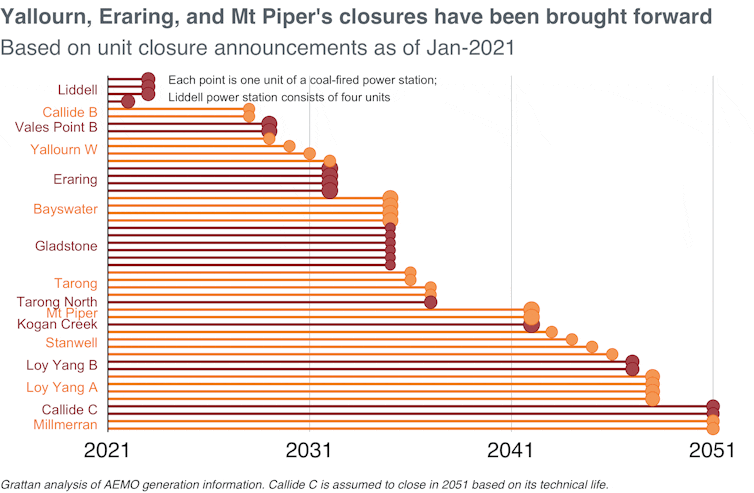
Faster closure means less coal generation capacity in future years. For example, the early closures of Yallourn and Eraring will reduce the expected coal generation capacity in 2030 by 1.5 gigawatts.
But the current closure schedule would still leave at least six coal-fired power stations operating in Australia after 2040.
As noted by the CSIRO in July, this is incompatible with Australia pursuing the Paris Agreement goal to limit global warming to 1.5℃ this century.
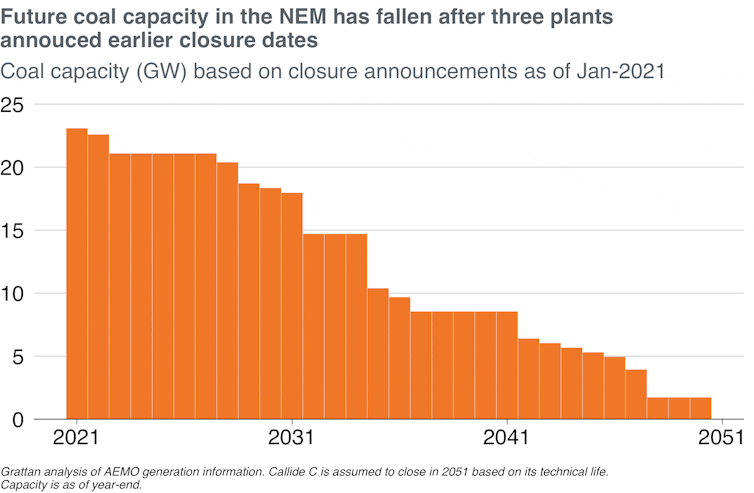
So What Are The States Doing?
South Australia closed its last coal-fired power station in 2016, and NSW is set to be next with the Mt Piper station due to close in 2040. That leaves Victoria and Queensland.
Victoria’s Loy Yang A and B power stations use brown coal, making them some of the cheapest but most polluting plants to operate. Victoria has also legislated its commitment to net-zero emissions by 2050 and, by 2030, Victoria plans to use 50% renewable energy.
Pushing even more renewable energy into the state boosts the odds of the remaining coal-fired power stations leaving. In fact, the owners of each of the Loy Yang plants have hinted that their closure dates will come forward.
Queensland is more complicated, as it has Australia’s youngest fleet of coal-fired power stations. Five of them are due to close after 2040.
But of those five, four are partly or fully owned by the Queensland government. That means the timing of their closures is as much a political as an economic question.
Queensland also boasts some of the best renewable resources in the country, including vast tracts of land suitable for renewable energy projects. Combined with its 50% renewable energy target by 2030, the state government has the levers it needs to pull coal-fired generation out of the system by 2040 or earlier.
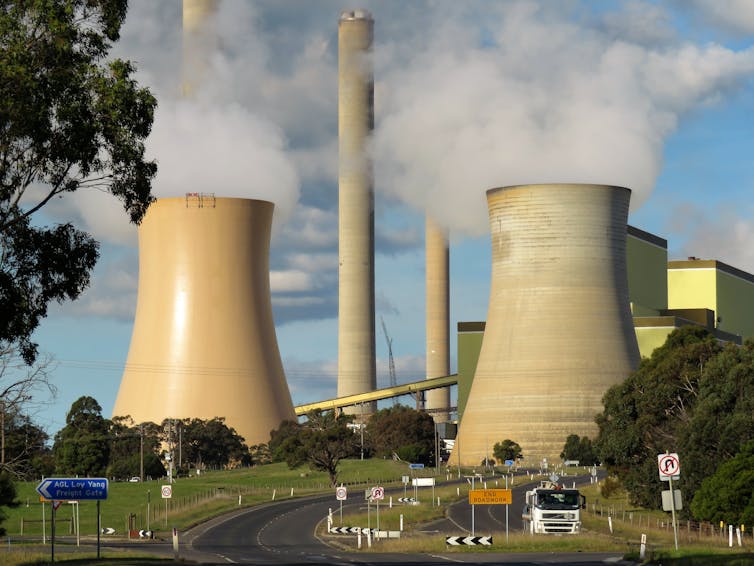
We Need Strong, National Policy
Grattan Institute analysis finds that a mostly renewable system with no coal – and only a limited role for gas – can maintain a reliable electricity supply while slashing emissions cheaply.
This is because the cost of wind and solar have plummeted, and energy storage such as batteries can help to smooth out daily fluctuations in demand and supply. For rare, sustained periods of high demand, low solar and low wind (which occur every few winters), gas is the lowest-cost backstop solution, at least until the economics of hydrogen become much better.
Achieving this outcome by 2040 or earlier will require significant, timely investment in the transmission network within and between states, allowing states to share their supplies and reducing the overall cost to consumers. Keeping a lid on the costs of transmission projects is also crucial – the risk of cost overruns is higher the more complex the project.
There will, of course, be challenges to ensure an orderly coal exit. For example, unexpected closures or breakdowns of coal plants can lead to shortages in electricity supply because investors in the electricity market don’t have enough time to build new capacity.
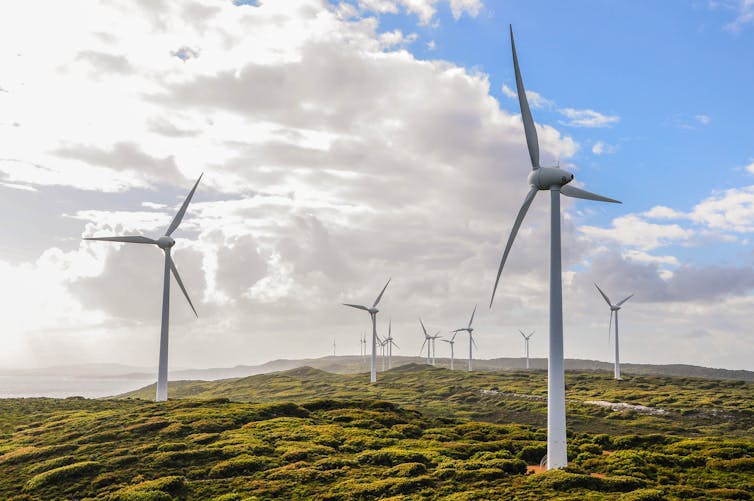
A national policy to coordinate coal exit would reduce uncertainty for the electricity system.
Grattan has previously recommended coal plant operators nominate a window of time within which their plant will close, combined with a payment of at least $100 million into an escrow fund. The operators’ money would be released only if the plant closes within its nominated window – if it exits unexpectedly, the money would be kept by the market operator to deal with any reliability problems.
Governments could also require that nominated closure windows occur before 2040, not after, if they want to achieve a coal-free NEM by that date. Alternatively – and more efficiently – they could establish an emissions standard for the NEM with tradeable certificates, allowing market participants to meet the emissions standard in the lowest cost way.
Unfortunately, current political reality indicates neither side of politics wants to be seen to support any policy resembling a carbon price, even though carbon pricing has the overwhelming support of Australian economists and the business community.
So, the renewable energy targets of the states are most likely to determine how quickly the NEM becomes coal-free. But if governments can muster the courage, our work shows that it’s possible to achieve a vastly lower-emissions electricity system in less than two decades.![]()
James Ha, Associate, Grattan Institute and Alison Reeve, Deputy Program Director, Energy and Climate Change, Grattan Institute
This article is republished from The Conversation under a Creative Commons license. Read the original article.
Snow Cover Critical For Revegetation Following Forest Fires
November 22, 2021
With wildfires devastating mountain ecosystems across the western United States, their successful forest revegetation recovery hinges on, among other factors, an adequate lasting snowpack, according to research by the University of Nevada, Reno and Oregon State University.
"Our study illustrated that summer precipitation, snow cover and elevation were all important drivers of revegetation success," said Anne Nolin, a hydrologist and geography professor at the University of Nevada, Reno and formerly at Oregon State University. "In particular, we found that snow cover was a critical explanatory variable for revegetation in the Oregon and Washington Cascades. This could help inform revegetation management practices following severe wildfires."
Climate change has already increased the fraction of winter precipitation that falls as rain rather than snow, reduced the spring snow water equivalent -- a metric for how much water snow contains -- and caused snowmelt to begin earlier in the spring than it used to, Nolin explained. Pacific Northwest snowpacks have seen the greatest declines of any seasonal snow region in the West.
The research, led by Nolin, examined the 260,000-square-mile Columbia River Basin in the Pacific Northwest. She teamed with co-author Andrew Wilson, a graduate research assistant in OSU's College of Earth, Ocean, and Atmospheric Science, and co-author Kevin Bladon of OSU's College of Forestry for the study.
The NASA-supported study featured before-and-after vegetation analyses for two dozen high-severity wildfires. The fires occurred over a 10-year period among the four distinct subregions of the Columbia River Basin. There are many short- and long-term effects from these fires, including erosion, debris flows and water quality issues, which can affect the health of aquatic ecosystems and downstream community water supply, highlighting the importance of understanding post-fire forest rehabilitation.
In their paper published in the Journal of Geophysical Research -- Biogeosciences, "Assessing the Role of Snow Cover for Post-Wildfire Revegetation Across the Pacific Northwest," the findings show that given the trends of increasing wildfire activity, lower snowpacks, and earlier snow disappearance dates across the Pacific Northwest, forests will likely experience more frequent drought conditions, which will negatively impact the success of post-wildfire vegetation recovery with a number of impacts to the ecosystem.
"This knowledge may be used to facilitate adaptive post-fire management policies and decisions to ensure long-term forest health," Nolin, who is also director of the University of Nevada, Reno's Graduate Program of Hydrological Sciences, said. "For example, depending on the sub-region and species composition, reseeding efforts following low snow winters might employ more drought tolerant species or, replanting could be delayed one to two years until snowmelt and soil moisture conditions are more favourable for seedling propagation.
"However, climate change projections and shifting wildfire regimes have increased concerns about post-fire regeneration and, as such it is imperative that we broaden our understanding of the role of snowpacks in post-wildfire forest regeneration. The snowpacks' role in aiding revegetation will become increasingly important across the West. And where snowpacks have declined, there likely will be ecosystem transitions that look like a shift from forest to non-forest and from evergreen to deciduous vegetation."
Wildfires continue to burn more area each year across many regions of the planet, including the Pacific Northwest. The Pacific Northwest's largest watershed, the Columbia River Basin contains a variety of fire-prone landscapes that have seen almost 900 fires since 2010, serves as critical habitat for more than 700 species and is a water source for seven states.
"As wildfire activity continues to increase and intensify in the Northwest, understanding what shapes revegetation on severely burned forested landscapes is vital for guiding management decisions," co-author Bladon said.
After the occurrence of a wildfire, revegetation over the burned area is critical to maintain or re-establish ecosystem functions from forests such as biodiversity, erosion control, water purification and habitat provision.
"Snow matters to regrowing vegetation following fire, and with double impacts of declining snowpacks and increasing wildfires it is critical that we understand how these changes are affecting Pacific Northwest forests," Nolin said. "Positive relationships between snow cover and summer precipitation with post-fire greening suggest that active post-fire revegetation efforts will help facilitate recovery, especially during years when severe wildfires are followed by early snowmelt years or below average summer precipitation."
In the study, summer precipitation consistently appeared as the most important variable driving post-fire revegetation across all four subregions. Snow cover frequency, along with elevation, were shown to be secondary but significantly influential explanatory variables for revegetation in the Oregon and Washington Cascades.
More than 80% of wildfires in the western United States from 2000 to 2012 burned within a seasonal snow zone, a time period that overlaps with the years studied by the scientists.
"As wildfire activity continues to increase and intensify in the Northwest, understanding what shapes revegetation on severely burned forested landscapes is vital for guiding management decisions," Bladon said. "But variables such as snow cover frequency, pre-fire forest composition, and elevation, were also shown to be significantly influential for revegetation in the Oregon and Washington Cascades."
Wildfire season length in the western U.S. overall has increased by roughly 25 days in recent decades, including a massive increase in the Northwest from the mid-1970s, when it was 23 days, to 116 days in the early 2000s. That's attributable mainly to warmer temperatures and drier conditions in the spring and summer.
"Snow cover has a strong influence on postfire vegetation greening, but the influence varied depending on subregion and dominant prefire conifer species, with the biggest impacts at low to moderate elevations in the Washington Cascades, the Oregon Cascades and western Montana Rockies," Nolin said. "And with current climate change projections, snowpacks' role in aiding revegetation will become increasingly important across the West."
Bladon suggests fire can be looked at as an opportunity for forests to reassemble into ecosystems better suited to survive warmer winters, longer fire seasons and more drought stress.
"That's at the heart of the challenge of reconciling a changing climate's ecological forces with postfire forest management goals -- the goals are often oriented toward re-establishing forests as they existed before the fire," Bladon said. "But with shifting climate trends in the region, that might not be the most adaptive path forward for forested landscapes."
Andrew C. Wilson, Anne W. Nolin, Kevin D. Bladon. Assessing the Role of Snow Cover for Post‐Wildfire Revegetation Across the Pacific Northwest. Journal of Geophysical Research: Biogeosciences, 2021; 126 (11) DOI: 10.1029/2021JG006465
5 big ideas: how Australia can tackle climate change while restoring nature, culture and communities
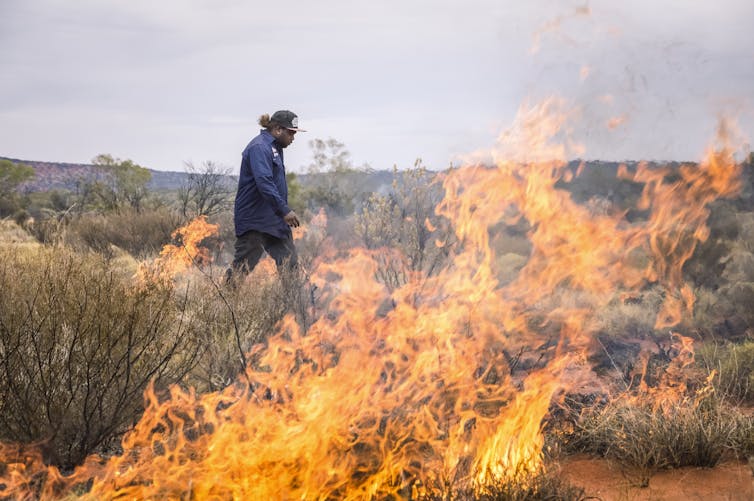
Australia’s plan to reach net zero emissions by 2050 relies heavily on unproven technologies to sequester carbon from the atmosphere, among other things.
But we already have solutions based in restoring nature and Country. In fact, nature-based solutions can deliver one third of promised global cuts in emissions.
Our new report, which brings together expertise from across Australia, reveals how we can make this happen using proven approaches including:
Indigenous-led work on Country
keeping our existing forests and woodlands safe from land clearing
restoring ailing ecosystems
simplifying access to carbon markets and
mapping ways of working with nature rather than technology to store emissions.
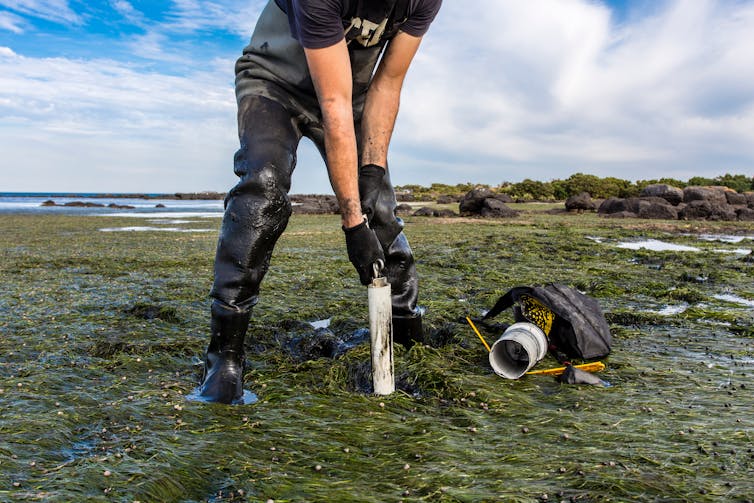
Here are five big ideas to store emissions while benefiting communities, our economy and our natural and cultural heritage.
1. Seek Indigenous Leadership To Heal Damaged Country
The catastrophic bushfires of the 2019-2020 summer have driven repeated calls to return to Indigenous leadership in managing Country to prevent similar disasters.
Indigenous-led cool burning practices and land management can make Country safer and keep carbon-storing forests and ecosystems intact. Indigenous management of Country could be integrated in national and state employment, industry and health policy.
This shift will mean a deeper respect for Indigenous leadership and a willingness to learn from Indigenous relationships with Country.
Indigenous ranger programs have been highly successful, helping both Country and its people. Expanding these programs into new places – including cities – would build on their success.
This will require re-framing our relationship and attitudes to Country, removing policy barriers, enabling access to Country, restoring water rights and increasing investment. If we can get this right, it would change the nature of our relationship with Country and provide tangible benefits toward national carbon, social and biodiversity goals.
For instance, the Yumbangku Aboriginal Cultural Heritage and Tourism Development Aboriginal Corporation uses Indigenous management to restore Turraburra, a large drought-affected degraded grazing property in Queensland.
Iningai custodians are reintroducing cultural burning and restoring artesian waterways and sacred rock waterholes as part of measured emissions-reduction projects on Turraburra.
In response, their Country is thriving, and life is returning to the land. These custodians have told us having Country back means healing for the whole community as well as for Country.

2. Look After What We Have
The easiest and cheapest way to both reduce and store emissions is by keeping the vegetation we still have. Australia’s plants – from deserts to forests to ocean – play a vital role.
Australia has committed to end deforestation within nine years, but this seems highly optimistic given Australia’s depressing record of land clearing.
Restoration helps pollinator-dependent farming industries and boosts the economy more than cutting down forest.
In our heating climate, trees keep local areas significantly cooler and wetter. Forested watersheds reduce the cost of providing clean water. And intact vegetation boosts resilience to floods and storms, and stops soil eroding into rivers.

To stop clearing, tighter environmental laws are key. The scathing 2021 independent review of Australia’s key environment protection law shows it fails to stop habitat loss and proposes a more strategic approach to sustainable development.
We could also extend stewardship and landcare programs, so they involve more landholders and regional communities. For instance, the Murray Wetland Carbon Storage Project has brought together scientists, landowners, natural resource managers, communities and government to restore wetlands across 41 sites, with replanting, fencing, environmental water, weed and pest control.
3. Map Pathways To Use Nature And Culture To Get To Net Zero
We need a clear collective vision for net zero which embeds Country, culture, community and nature as vital methods of cutting and storing emissions. This vision would support action where it’s most needed, and bring policy coherence.
Under this vision, we could work to restore habitat connections across catchments and landscapes. We could embed culture and nature-based emissions reduction in community development, urban infrastructure, adaptation and catchment management strategies.
What does this look like? Consider Sydney’s coastline, where researchers and community members plan to bring a vital seaweed species back to its original range.
This species, crayweed, supports abalone and rock lobster, two of Australia’s most valuable fisheries. The team is working to restore crayweed forests destroyed by urbanisation and sewage.
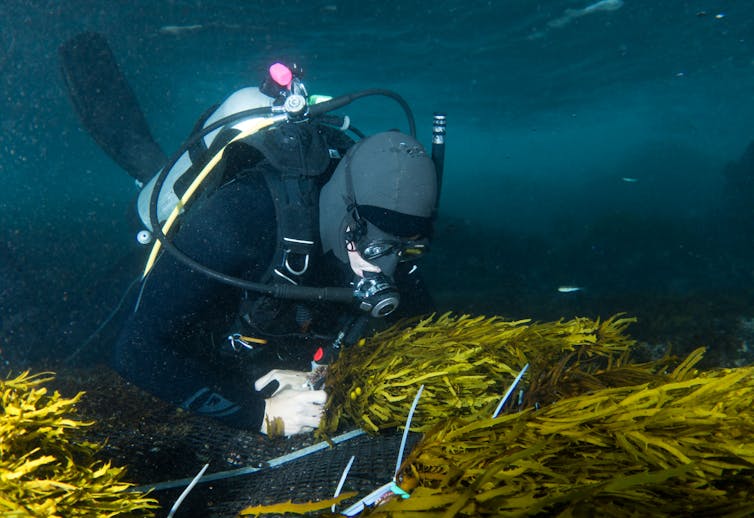
4. Measure The Things We Value To Demonstrate Success
We urgently need better accountability to ensure emissions reduction projects and programs deliver the benefits they claim. Robust monitoring also helps create premium carbon products.
Accountability must be culturally appropriate and measure the most important benefits for each project. Indigenous-led work demonstrates that cultural, social and biodiversity benefits must be central.
Requiring non-Indigenous projects to report robustly on cultural, social and biodiversity benefits would ensure projects deliver for Indigenous people, the wider community, and the ecosystems on which we all depend.
Savanna burning in Northern Australia has been a strong success story for renewing culture and Country. Indigenous-led approaches to assessing benefits have successfully attracted funding to sequester carbon through both government and voluntary markets.
Indigenous groups are now leading conversations on extending this success to other places and ecosystems, such as through an Indigenous-led southern forest fire credits scheme under development.
5. Simplify Access To Carbon Markets And Incentive Schemes
At present, the methods we use to produce high-quality carbon credits through government emissions reduction schemes are often costly, complex and time-consuming. In short, they require specialist expertise to navigate.
These challenges act as a barrier, particularly for small organisations, and are inequitable for less resourced communities.
If we reduce the administrative burden, more small projects could embark on emission reduction. That means offering accessible methods of assessing projects, streamlining permits, and investing in Indigenous and community-based agencies to provide support.
New incentive schemes to reduce emissions in cities could also be a game-changer, like green roof retrofitting or the City of Melbourne’s Urban Forest Fund which enables property owners to partner with the city to deliver vertical greening, convert carparks into gardens, and build food-producing rooftop parks.
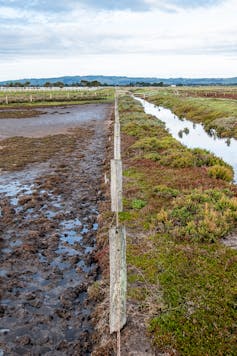
If we draw together methods of producing carbon credits across catchments, land and seascapes, we could provide pathways into a market likely to boom. In Victoria, a team of researchers, government, industry, landholders and Traditional Owners at #VicWetlandRehab are restoring degraded coastal wetlands by fencing and weeding.
To date, this program has restored 130 hectares of saltmarsh in Western Port Bay and Gippsland, home to some of Victoria’s most endangered birds, frogs and plants. The team is now planning to work with landholders and Traditional Owners to map priority areas for restoration along the entire Victorian coastline.![]()
Rachel Morgain, Senior research fellow, School of Ecosystem and Forest Sciences, The University of Melbourne; Brendan Wintle, Professor in Conservation Ecology, School of Ecosystem and Forest Science, The University of Melbourne; Judy Bush, Lecturer in Urban Planning, The University of Melbourne; Michael-Shawn Fletcher, Associate Professor in Biogeography, The University of Melbourne, and Thami Croeser, Research Officer, Centre for Urban Research, RMIT University
This article is republished from The Conversation under a Creative Commons license. Read the original article.
Australia’s marine industries deliver $80b a year. But without more scientists, the ‘blue economy’ is at risk
Toni Moate, CSIRO; Anthony Boxshall, The University of Melbourne; David Souter, Australian Institute of Marine Science, and Michelle Heupel, University of TasmaniaAustralia is a marine nation. First Nations people have deep and unbroken connections to sea, 85% of us live within 50km of the coast, and our ocean territory is twice that of our land mass.
A large part of our economy – the “blue economy” – depends on the sea: tourism, ports, energy, transport, fisheries and aquaculture, and emerging industries like renewable energy, offshore aquaculture, and biotechnology.
Together, these industries are worth more than A$80 billion a year. By 2025, this figure may be $100 billion.
To manage our oceans and coasts to support a growing blue economy means we need to understand them, and that means we need science. At the National Marine Science Committee (NMSC), we have surveyed how well Australia is delivering this science. As we show in a new report, the story is mixed.
The Plan
The NMSC is Australia’s peak body for marine research. Its members are almost 40 universities, research institutions and state and federal agencies.
In 2015, the Committee created a blueprint for growing Australia’s blue economy: the National Marine Science Plan: 2015-25.
This plan identified seven grand challenges facing our marine estate:
marine sovereignty and security
energy security
food security
biodiversity conservation
sustainable urban coastal development
climate change adaptation
equitable, balanced resource allocation.
The plan also made eight recommendations involving initiatives, investment, and priorities to address the challenges.
We are now halfway through the plan’s ten-year scope. While many of the recommendations are on track, others need some work.
The Report Card
Our oceans face unique challenges, from climate change to managing increasing resource use. Despite pandemic disruptions, scientific progress has continued.
Highlights from the past five years include increasing Australia’s marine research capacity with a new icebreaker for working in the Antarctic and operation of the research ship RV Investigator for 300 days at sea. Coastal research vessels have also continued operations, and the Integrated Marine Observing System has expanded.
The new report shows science has already helped deliver better outcomes for the blue economy, through things like strategies for fishery harvesting to balance consumer demands with economic and ecological sustainability.
The report also identifies further steps needed to ensure all recommendations are fulfilled. It offers three new recommendations, too.
First, integrate the knowledge, rights, capabilities, and aspirations of Traditional Owners into conventional marine science.
Second, establish national policy guidelines for open access to government-funded or regulatory data. This would include access to historical datasets and expand the Australian Ocean Data Network.
And third, develop an approach to increase the resilience of our coasts.
An Unprecedented Opportunity
After the economic shock of the pandemic, there is enormous interest in Australia’s blue economy and our ocean health. This can be realised via national and international initiatives and funding focused on sustainable growth.
The Australian government has joined 13 other nations in the High Level Panel for a Sustainable Ocean Economy committing to sustainably manage 100% of their marine estates by 2025.
This year also kicks off the UN Decade of Ocean Science for Sustainable Development. The world’s eyes will be on the oceans for the next ten years.
Since 2015, Australia has been building its national marine science capability. Recent initiatives include the Reef Trust Partnership, Blue Economy Cooperative Research Centre (CRC), Marine Bioproducts CRC, investments in marine and coastal science under the National Environmental Science Program, and the [Australian Ocean Leadership Package].
The foundations are there, and the task now is to strengthen and embed our marine science sovereign capability.
A Call To Action
The report calls on actions from broad sectors of society to ensure Australia’s blue economy continues to grow. It asks:
the research community to build on and amplify existing resources to establish truly national research programs that incorporate all stakeholder needs
industry to work with marine scientists and governments to ensure science underpins operational decision-making, risk assessments and future planning, and to create efficient, sustainable businesses
government to focus on and invest in the blue economy as an important plank in post-COVID economic recovery and a way to create long-term social, cultural and environmental benefits
the community to recognise the responsibility we all share as a marine nation, and to play an active role in ensuring the long-term health of our oceans and coasts for all Australians.
With a strong blue economy, we can chart a course through the uncertainties of the future and create long-term prosperity for all Australians.
This article was written in conjunction with Dr David Smith, Chair of the National Research Providers Network for Fisheries and Aquaculture.![]()
Toni Moate, Chair, National Marine Science Committee and Director, CSIRO National Collections and Marine Infrastructure, CSIRO; Anthony Boxshall, Chair – Marine and Coastal Council, Victoria, and Associate Professor, The University of Melbourne; David Souter, Chief Research Officer, Australian Institute of Marine Science, and Michelle Heupel, Director, Integrated Marine Observing System, and Adjunct Professor, University of Tasmania
This article is republished from The Conversation under a Creative Commons license. Read the original article.
Just like how humans recognise faces, bees are born with an innate ability to find and remember flowers
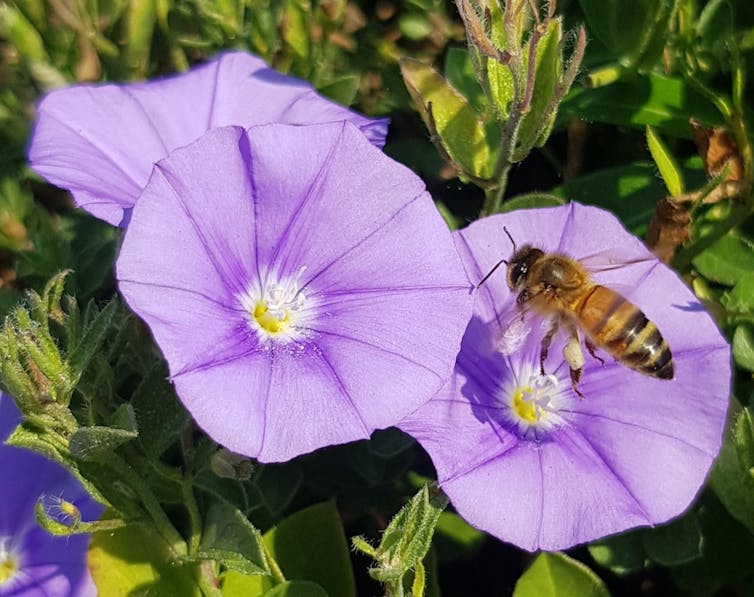
We’ve all watched a honeybee fly past us and land on a nearby flower. But how does she know what she’s looking for?
And when she leaves the hive for the first time, how does she even know what a flower looks like?
Our paper, published in Frontiers in Ecology and Evolution, set out to discover whether bees have an innate “flower template” in their minds, which allows them to know exactly what they are looking for even if they’ve never seen a flower before.
A Story Of Partnership
Plants and pollinators need each other to survive and prosper. Many plants require animals to transport pollen between flowers so the plants can reproduce. Meanwhile, pollinators rely on plants for nutrition (such as pollen and nectar) and nesting resources (such as leaves and resin).
As such, flowering plants and pollinators have been in partnership for millions of years. This relationship often results in flowers having evolved certain signals such as colours, shapes and patterns that are more attractive to bees.
At the same time, bees’ reliance on flower resources such as nectar and pollen has led them to be effective learners of flower signals. They must be able to tell which flowers in their environment will provide a reward and which will not. If they didn’t know the difference, they would waste time searching for nectar in the wrong flowers.
Our findings show bees can quickly and effectively learn to discriminate between flowers of slightly different shapes – a bit like how humans can expertly tell faces apart.
The Amazing Brains Of Honeybees
Honeybee brains are tiny. They weigh less than a milligram and contain just 960,000 neurons (compared to 86 billion in human brains). But despite this, they demonstrate exceptional learning abilities.
Their learning extends to many cognitively challenging tasks, including maze navigation, size discrimination, counting, quantity discrimination and even simple math!
So we know bees can learn all sorts of flower-related information, but we wanted to discover how they find flowers on their first foraging trip outside the hive. We also investigated whether experienced foragers developed a bias in their foraging strategies and flower preferences.
To test this, we prompted two groups of bees to discriminate between sets of flower images. One group was raised in a hive inside a greenhouse with no flowers, and had therefore never been exposed to flowers. We put a colour mark on these bees at birth, so we could track them once they emerged from the hive to forage two weeks later.
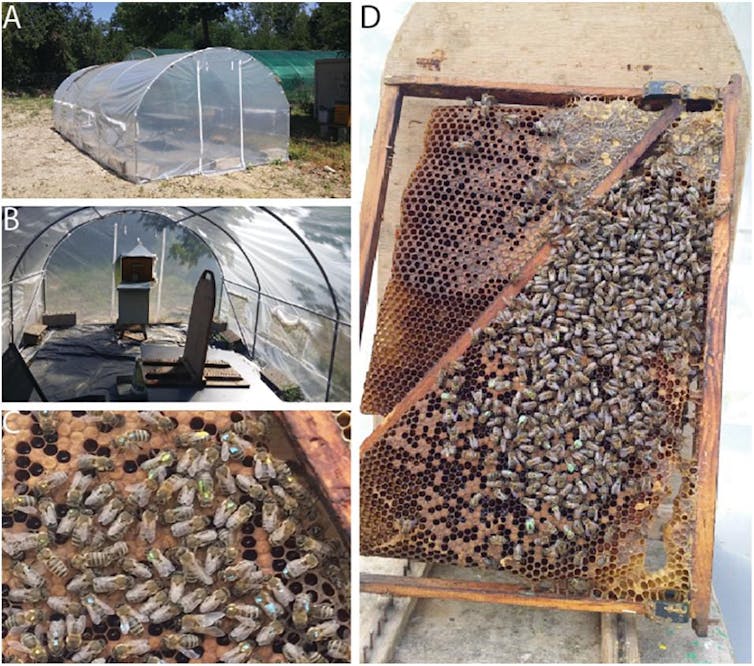
The second group consisted of experienced foragers which had encountered many flowers in their lives.
We trained both groups to discriminate between images of two flowers found in nature, using a reward of sugar water for choosing the correct option when directed. We also trained both groups to discriminate between the same flowers with the petals separated and randomly scrambled.
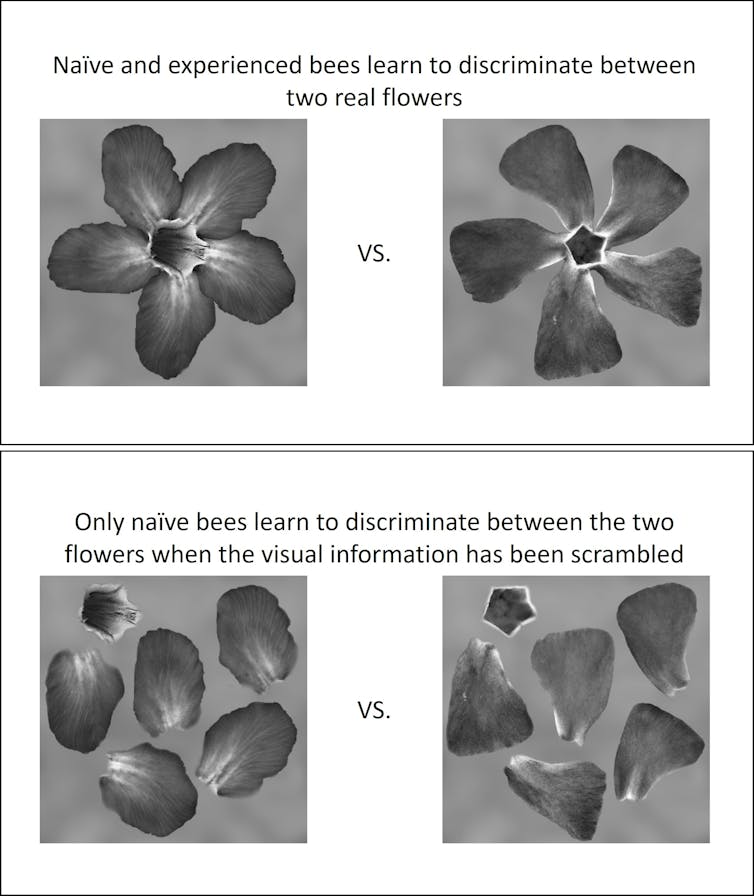
How well and how quickly the bees learnt to discriminate between the images of whole flowers, versus how long they took to discriminate between the scrambled petals, would tell us which information they preferred to learn.
Both the flower-naïve and experienced foragers learnt to discriminate between the images of whole flowers better, and more quickly, than the scrambled petals. However, the flower-naïve honeybees appeared to have less bias as they also learnt to discriminate between the scrambled information, while the experienced foragers could not.
The results reveal flower-naïve bees have an innate flower template that aids them with learning new flowers and discriminating between them. At the same time, experienced foragers become biased towards certain flower shapes as they gain foraging experience.
Overall, bees use an innate flower template to first find flowers, and also draw on their past knowledge as they become more experienced.
Innate Recognition In Other Animals
While our findings on honeybees are remarkable, they do tie into similar capabilities in other species.
Different species have evolved brains which tune into important stimuli. For example, humans and other primates can detect, process, recognise and discriminate between the faces of other members of their species. Research has shown even human infants can detect and recognise other people’s faces very well.
Our preference for faces, and ability to recognise them, has probably evolved due to the importance of needing to discriminate between friends, enemies and strangers. This is akin to the bees needing to process images of whole flower shapes better than scrambled petal images – due to the importance of recognising flower shape for survival.
Similarly, social paper wasps evaluate their relationship with hive-mates based on the different facial markings of friends and foes. Just like bees, they do this using a combination of innate mechanisms and lived experience.![]()
Scarlett Howard, Postdoctoral research fellow, Deakin University and Adrian Dyer, Associate Professor, RMIT University
This article is republished from The Conversation under a Creative Commons license. Read the original article.
Harder foods make for stronger skulls, giving hand-reared animals the best chance of survival in the wild
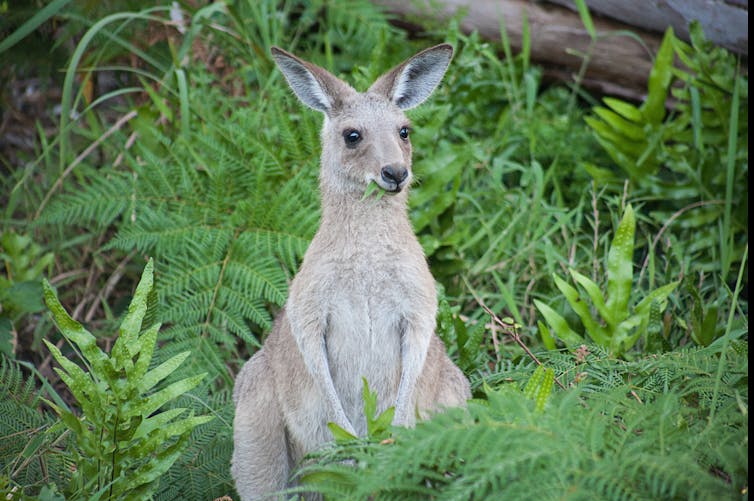
Each year, thousands of wild animals across the world are rescued. They can include young animals saved from abandonment, injury, disease or the death of their parents. Animal carers around the world work tirelessly to help these little animals heal and grow until they are ready to be released back into the wild.
But there can be differences between what captive animals are fed and what wild animals eat. Captive diets can include processed or pre-portioned foods, such as minced meat, peeled, diced or pureed fruit, or feed pellets.
While these kinds of foods generally meet the nutritional demands of growing animals, they are much easier to eat than a typical meal in the wild, and this can have drawbacks for young animals that are trying to grow fit and strong.
In my new research, published today in the journal Integrative Organismal Biology, my colleagues and I show how a diet of exclusively soft foods can hamper skull development in growing animals.
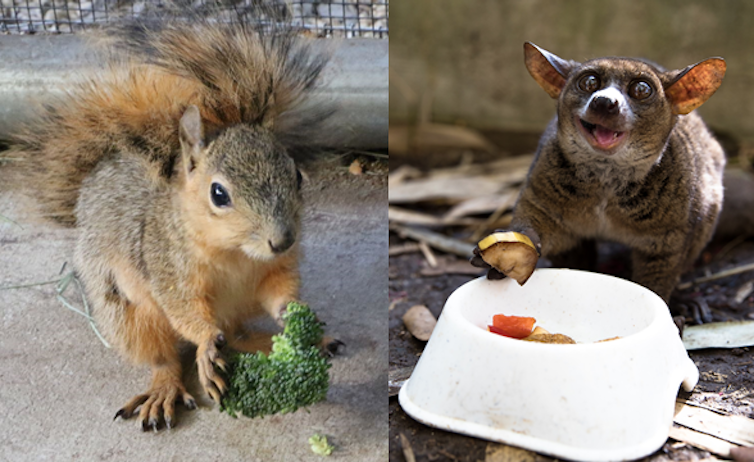
Over the past few decades there have been many documented examples of captive animals – including lions, monkeys and marsupial gliders – that have differently shaped skulls to their wild counterparts. These differences are most often found around the bones and locations of muscles used for feeding, prompting some researchers to suggest they are due to differences in diet.
Our research therefore asked whether growing up on a diet that doesn’t need much biting can impact the ability of an adult skull to bite effectively.
Fortunately, we had access to a large, ready-made data set that could help answer this question. Back in 2012, as part of a different research project, 40 rats were fed contrasting diets, from weaning all the way to adulthood. Some ate hard pellets that needed plenty of biting and then chewing; others ate the same food but after it was first ground into powdered meal. When they reached adulthood, CT scans were taken of their skulls.

Using these scans, I created three-dimensional digital models of each rat’s skull, and carried out bite simulations to compare the amount of stress each skull model experienced when subject to the same biting forces. Greater stress would indicate thinner bone.
Biting Off More Than They Can Chew
Bones are often thought of as simple, hard objects. But bone is actually a complex living tissue that constantly adapts to its job. Every time a bone is used to perform an action, it bends a tiny bit. The more often a bone bends over time, the thicker it can grow – especially when lifting or moving heavier things.
Sure enough, my simulations showed that the skulls of rats fed powdered meal experienced the most stress during biting. This supports the idea that the rats that ate softer foods while growing up had less bone deposited in their skull, leaving the skull weaker as a result.
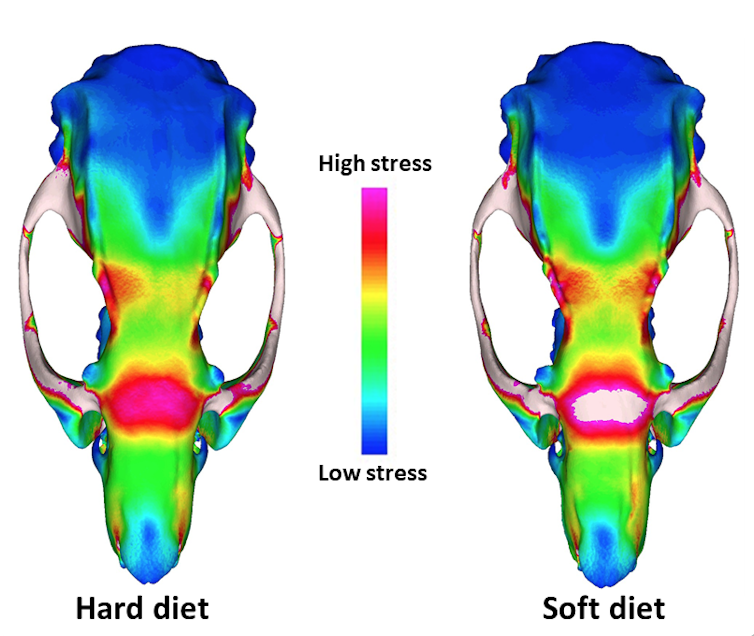
What does this mean for rehabilitation and release of our furry friends during conservation programs? Well, it’s similar to exercise. When someone goes running to prepare for a race, they aren’t just training their bones and muscles to run faster, they’re also reducing their risk of injury by conditioning their body to perform a demanding task.
If rescued baby animals are raised on diets full of soft, processed, peeled, chopped, blended or portioned foods, much of the biting and chewing has already been done for them. This means the bones and muscles of their skulls won’t be as conditioned for the tougher foods they may need to eat in the wild. This might leave them more vulnerable to being injured or going hungry when ultimately released.
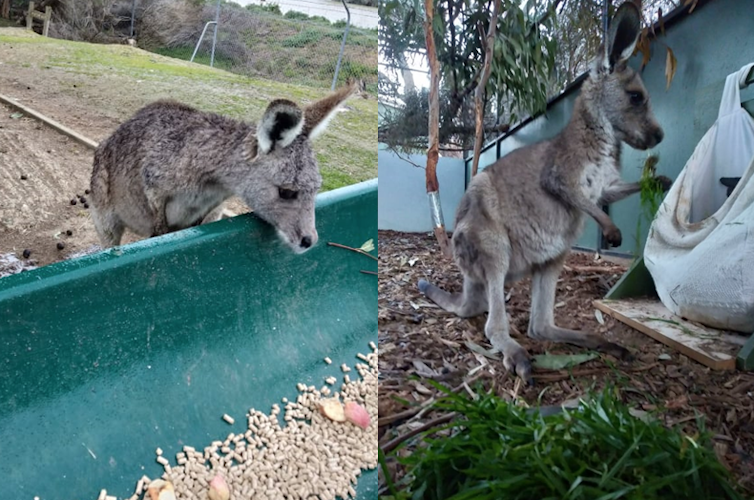
Naturally, these factors would vary between species. So, these findings simply serve as an additional consideration for all those fantastic animal carers who give their time and effort to conserving our native animals.![]()
D. Rex Mitchell, Postdoctoral Fellow, Flinders University
This article is republished from The Conversation under a Creative Commons license. Read the original article.
Invasive species are threatening Antarctica’s fragile ecosystems as human activity grows and the world warms
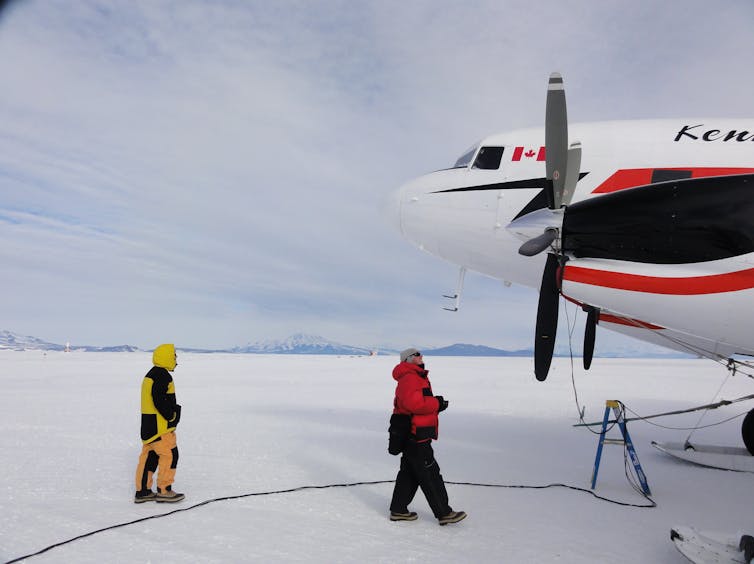
We tend to think Antarctica is isolated and far away – biologically speaking, this is true. But the continent is busier than you probably imagine, with many national programs and tourist operators crisscrossing the globe to get there.
And each vessel, each cargo item, and each person could be harbouring non-native species, hitchhiking their way south. This threat to Antarctica’s fragile ecosystem is what our new evaluation, released today, grapples with.
We mapped the last five years of planes and ships visiting the continent, illuminating for the first time the extent of travel across the hemispheres and the potential source locations for non-native species, as the map below shows. We found that, luckily, while some have breached Antarctica, they generally have yet to get a stranglehold, leaving the continent still relatively pristine.
But Antarctica is getting busier, with new research stations, rebuilding and more tourism activities planned. Our challenge is to keep it pristine under this growing human activity and climate change threat.
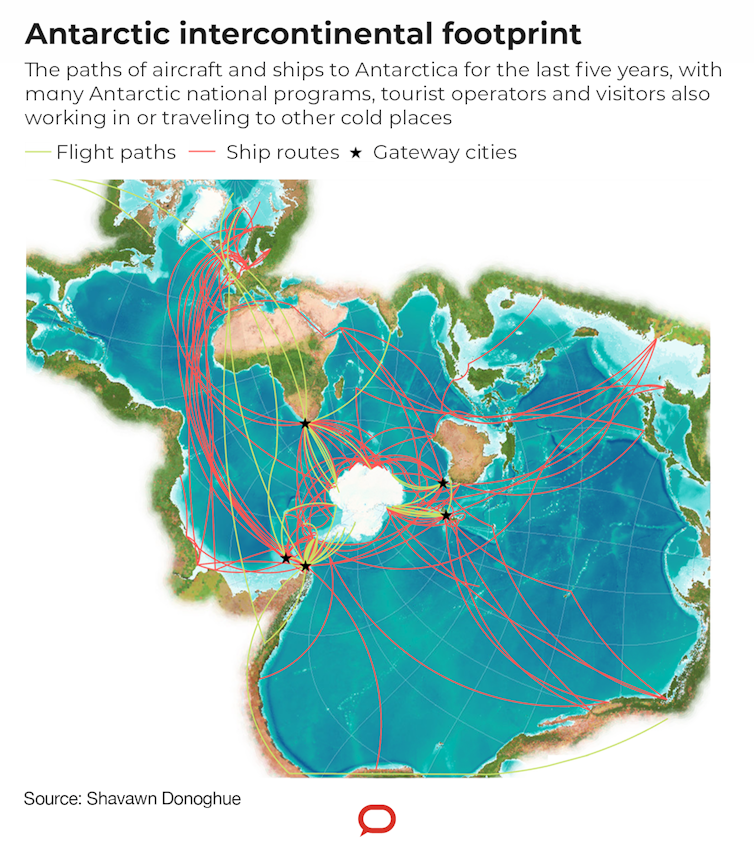
Life Evolved In Isolation
Biodiversity-wise, much of the planet is mixed up. The scientific term is homogenisation, where species, such as weeds, pests and diseases, from one place are transported elsewhere and establish. This means they begin to reproduce and influence the ecosystem, often to the detriment of the locals.
Most life in Antarctica is jammed onto tiny coastal ice-free fringes, and this is where most research stations, ships and people are.
This includes unique animals (think Adélie penguins, Weddell seals and snow petrels), mosses and lichens that harbour tiny invertebrates (such as mites, waterbears and springtails), and an array of microbes such as cyanobacteria. The adjacent coast and ocean team with life, too.
The more we learn about them, the more outstanding life at the end of the planetary spectrum becomes. Just this week, new scientific discoveries identified that some Antarctic bacteria live on air, and make their own water using hydrogen as fuel.
When the Southern Ocean was formed some 30 million years ago, natural barriers were created with the rest of the world. This includes the Antarctic Circumpolar Current, the strongest ocean current on the planet, and its associated strong westerly surface winds, icy air and ocean temperatures.
This means life in Antarctica evolved in isolation, with flora and fauna that commonly exist nowhere else and can cope with frigid conditions. But the simplicity of Antarctica’s food webs can often mean there are gaps in the ecosystem that other species from around the world can fill.
In May 2014, for example, routine biosecurity surveillance detected non-native springtails (tiny insect-like invertebrates) in a hydroponic facility at an Australian Antarctic station.
This station, an ice-free oasis, previously lacked these interlopers, and they had the potential to alter the local fragile ecosystem permanently. Thankfully, a rapid and effective response successfully eradicated them.
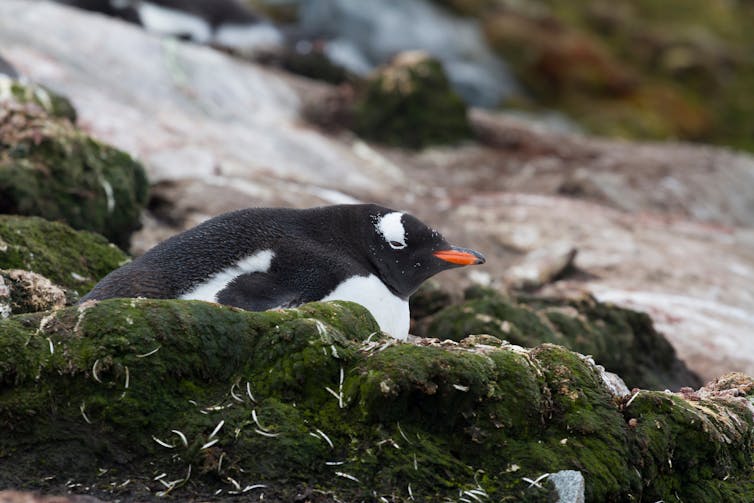
Pressures from climate change are exacerbating the challenges of human activity on Antarctica, as climate change is bringing milder conditions to these wildlife-rich areas, both on land and sea.
As glaciers melt, new areas are exposed, which allows non-Antarctic species greater opportunity to establish and possibly outcompete locals for resources, such as nutrients and precious, ice-free space.
So Far, We’ve Been Lucky
Our past research focused on non-native propagules – things that propagate like microbes, viruses, seeds, spores, insects and pregnant rats – and how they entrain themselves into Antarctica.
They can be easily caught on people’s clothing and equipment, in fresh food, cargo and machinery. In fact, research from the last decade found that visitors who hadn’t cleaned their clothing and equipment carried on average nine seeds each.
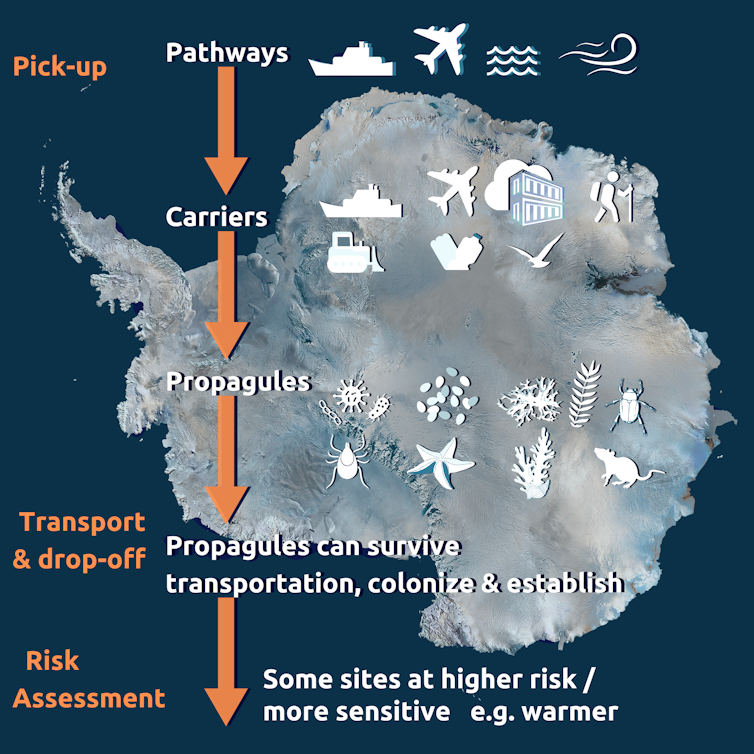
But few non-native species have established in Antarctica, despite their best efforts.
To date, only 11 non-native invertebrate species – including springtails, mites, a midge and an earthworm – have established across a range of locations in the warmer parts of Antarctica, including Signy Island and the Antarctic Peninsula. In the marine realm, some non-native species have been seen but it’s thought none have survived and established.
Microbes are another matter. Each visitor to Antarctica carries millions of microbial passengers, and many of these microbes are left behind. Around most research stations, human gut microbes from sewage have mingled with native microbes, including exchanging antibiotic resistance genes.
Last year, for example, a rare harmful bacteria, pathogenic to both humans and birds, was detected in guano (poo) from both Adélie and gentoo penguin colonies at sites with high rates of human visitors. COVID-19 also made its way to Antarctica last December.
Both these cases risk so-called “reverse zoonosis”, where humans spread disease to local wildlife.
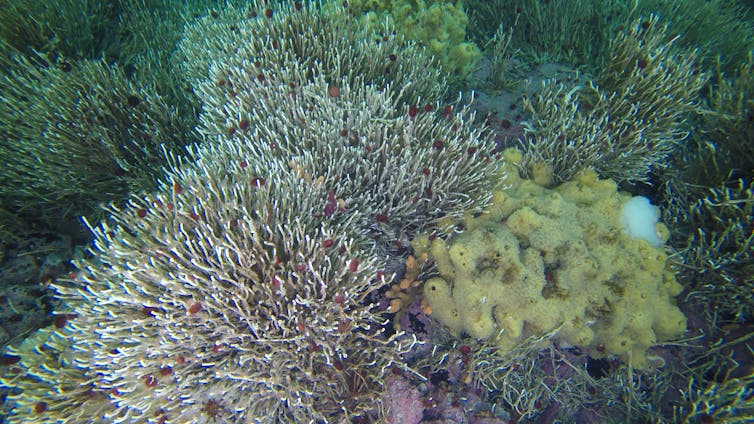
What Do We Do About It?
Three factors have helped maintain Antarctica’s near-pristine status: the physical isolation, cold conditions and co-operation between nations through the Antarctic Treaty. The Treaty is underpinned by the Environmental Protocol, which aims to prevent and respond to threats and pressures to the continent.
There is unanimous commitment from Antarctic Treaty nations towards preventing the establishment of non-native species. This includes adopting a science-based, non-native species manual, which provides guidance on how to prevent, monitor, and respond to introductions of non-native species.
But time is of the essence. We must better prepare for the inevitable arrival of more non-native species to prevent them from establishing, as we continue to break the barriers protecting Antarctica. One approach is to tailor the newly developed 3As approach to environmental management: Awareness of values, Anticipation of the pressures, Action to stem the pressures.
This means ramping up monitoring, taking note of predictions of what non-native species could sneak through biosecurity and establish under new conditions, and putting in place pre-determined response plans to act quickly when they do.![]()
Dana M Bergstrom, Principal Research Scientist, University of Wollongong and Shavawn Donoghue, Adjunct Researcher, University of Tasmania
This article is republished from The Conversation under a Creative Commons license. Read the original article.
The seas are coming for us in Kiribati. Will Australia rehome us?
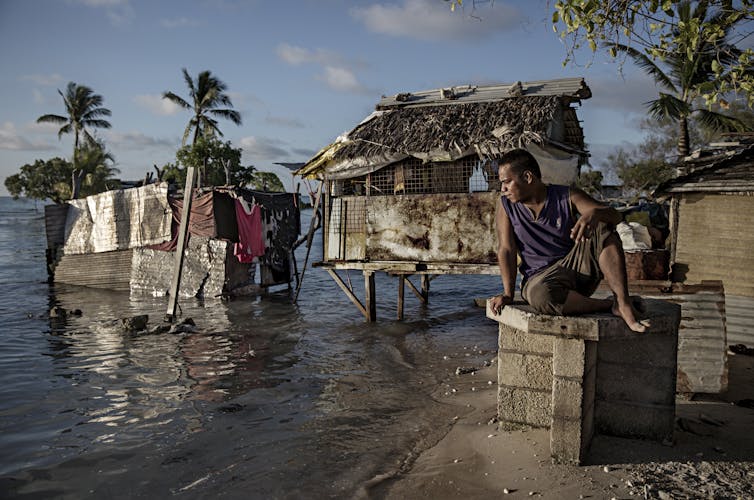
Our atoll nation is barely two metres above sea level, and the waters are coming for us.
Despite the progress and momentum of the COP26 climate conference in Glasgow, we are still not moving fast enough to avoid the worst of climate change.
It is heartening that more than 190 countries and organisations agreed to rapidly phase out coal power and end support for new coal power stations. More than 100 countries signed a pledge to cut methane emissions 30% by the end of the decade, and about the same number agreed to stop deforestation on an industrial scale in the same timeframe.
But even with these agreements, we in Kiribati face the death of our homeland. Co-author Anote Tong led our country as president for 15 years, alongside lead author Akka Rimon, who was foreign secretary between 2014 and 2016.

The problem is speed. Our land is disappearing faster than global action can stem climate change. Delays and a lack of global leadership mean the existence of small island states like Kiribati is now in the balance.
That means we must urgently find ways to rehome our people. It is very difficult to leave our homes, but there is no choice. Time is not on our side. We must prepare for a difficult future.
What we need is a model where displaced people can migrate to host nations when their homes become uninhabitable. Countries like Australia need workers – and we will soon need homes.
This is, increasingly, a question of justice. Australia’s actions, in particular, raise questions over how sincere it is in honouring its recent commitments at COP26.
As the world’s largest exporter of fossil gas and the second largest exporter of coal, Australia’s reluctance to change is putting its neighbours in the Pacific at risk of literally disappearing. It is the only developed nation not committed to cut emissions at least in half by 2030.
In Glasgow, Fiji urged Australia to take real action by halving emissions by 2030. Did it work? No. Australia also refused to sign the agreements on ending coal’s reign, with prominent politicians undermining the COP26 agreement as soon as the conference was over.
We desperately hope the commitments Australia did make at COP26 are not just words on paper. But if they are, that makes our need for certainty even more urgent.
Let us speak plainly: If Australia really does plan to sell as much of its fossil fuel reserves as possible and drag its feet on climate action, the least it can do is help us survive the rising seas caused by the burning of its coal and gas.
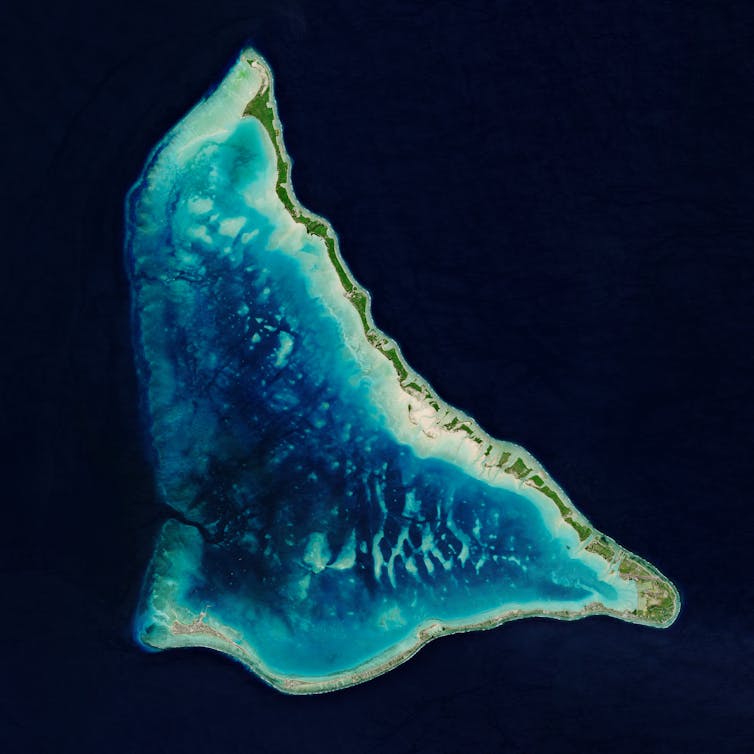
To Migrate With Dignity
Eighteen years ago, the Kiribati government – then headed by Anote Tong – introduced a “migration with dignity” policy as a way for I-Kiribati people to adapt to climate change.
We gave our I-Kiribati workers international qualifications tailored for jobs in demand overseas. After this, Kiribati, Tuvalu, Fiji, Tonga and New Zealand set up a scheme to allow workers to migrate to New Zealand if they had an offer of a job. Each year prior to COVID, 75 people from Kiribati were able to migrate through the scheme.
New Zealand is the first and only country currently offering a permanent labour migration program from Kiribati. While welcome, we will need more places for I-Kiribati as climate change intensifies.
Like New Zealand, Australia has expanded its seasonal worker schemes for Pacific workers, and is now moving towards a longer stay, multi-visa arrangement under its Pacific Labour Scheme. We expect this scheme will evolve into a permanent migration scheme similar to New Zealand.
While we wait in hope for a true safe haven for our people, our diaspora is growing. I-Kiribati are moving now to Pacific countries higher above the water level such as Fiji, the Cook Islands, Niue, Samoa and Tonga.
Are we scared? Of course. We are on the front line of this crisis, despite having done amongst the least to cause it. It is difficult to leave the only home we have known. But science does not lie. And we can see the water coming.
Labour migration will not solve climate change, but it offers hope to those of us who will be displaced first.
This is a vital question of climate justice. This upheaval is caused by high-emitting economic powerhouses like the US, China, and the European Union. But the vulnerable are paying the full cost. That is not fair.
As climate change worsens, other global leaders must consider how best to support adaptation through labour mobility. Far better to plan for this now than to let climate change rage unchecked and trigger ever-larger waves of refugees.
The Question Of Climate Justice
Consider this: in 2018, each person in Kiribati was responsible for 0.95 tonnes of carbon dioxide equivalent. By contrast, each person in the United States was responsible for 17.7 tonnes. Despite this imbalance, the US has taken little responsibility for what is happening to Kiribati and other low-lying nations.
We are hopeful this may change, given US President Joe Biden recently pledged to make his nation a leader in climate finance by supporting nations worst hit by climate change and with the least resources to cope. It’s also encouraging that new laws have been proposed to allow people displaced by climate change to live in America.
We must work to slash emissions and devise solutions for the problems caused by the warming.

International law must recognise climate displaced populations and create ways we can be rehoused.
While other solutions such as climate-proofing infrastructure or even floating islands have been proposed for Kiribati, these cannot happen overnight and are very expensive. By contrast, labour mobility is fast and advantageous to the host country.
Kiribati’s current government is working to increase skills and employability in our workforce. We are doing our part to get ready for the great dislocation.
When I-Kiribati have to migrate, we want them to be able to do so as first class citizens with access to secure futures rather than as climate refugees.
We are doing all we can to stay afloat in the years of ever angrier climate change. But it will take the global village to save our small village and keep alive our culture, language, heritage, spirits, land, waters and above all, our people.![]()
Akka Rimon, PhD Student, Australian National University and Anote Tong, Distinguished Global Leader-in-Residence, University of Pennsylvania
This article is republished from The Conversation under a Creative Commons license. Read the original article.
Bushcare In Pittwater
Where we work Which day What time
Avalon
Angophora Reserve 3rd Sunday 8:30 - 11:30am
Avalon Dunes 1st Sunday 8:30 - 11:30am
Avalon Golf Course 2nd Wednesday 3 - 5:30pm
Careel Creek 4th Saturday 8:30 - 11:30am
Toongari Reserve 3rd Saturday 9 - 12noon (8 - 11am in summer)
Bangalley Headland 2nd Sunday 9 to 12noon
Bayview
Winnererremy Bay 4th Sunday 9 to 12noon
Bilgola
North Bilgola Beach 3rd Monday 9 - 12noon
Algona Reserve 1st Saturday 9 - 12noon
Plateau Park 1st Friday 8:30 - 11:30am
Church Point
Browns Bay Reserve 1st Tuesday 9 - 12noon
McCarrs Creek Reserve Contact Bushcare Officer To be confirmed
Clareville
Old Wharf Reserve 3rd Saturday 8 - 11am
Elanora
Kundibah Reserve 4th Sunday 8:30 - 11:30am
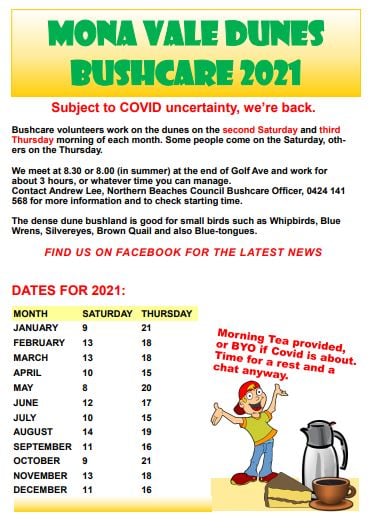 Mona Vale
Mona Vale Mona Vale Beach Basin 1st Saturday 8 - 11am
Mona Vale Dunes 2nd Saturday +3rd Thursday 8:30 - 11:30am
Newport
Bungan Beach 4th Sunday 9 - 12noon
Crescent Reserve 3rd Sunday 9 - 12noon
North Newport Beach 4th Saturday 8:30 - 11:30am
Porter Reserve 2nd Saturday 8 - 11am
North Narrabeen
Irrawong Reserve 2nd Saturday 2 - 5pm
Palm Beach
North Palm Beach Dunes 3rd Saturday 9 - 12noon
Scotland Island
Catherine Park 2nd Sunday 10 - 12:30pm
Elizabeth Park 1st Saturday 9 - 12noon
Pathilda Reserve 3rd Saturday 9 - 12noon
Warriewood
Warriewood Wetlands 1st Sunday 8:30 - 11:30am
Whale Beach
Norma Park 1st Friday 9 - 12noon
Western Foreshores
Coopers Point, Elvina Bay 2nd Sunday 10 - 1pm
Rocky Point, Elvina Bay 1st Monday 9 - 12noon
Gardens And Environment Groups And Organisations In Pittwater
Avalon Golf Course Bushcare Needs You
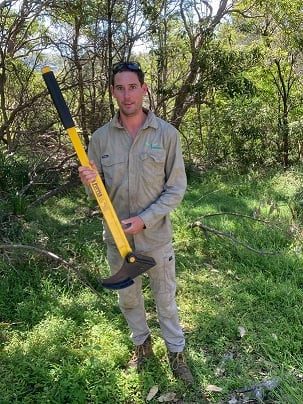
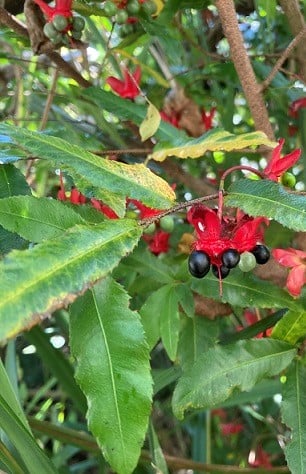
Pittwater Reserves + Others
A History Of The Campaign For Preservation Of The Warriewood Escarpment by David Palmer OAM and Angus Gordon OAM
Angophora Reserve - Angophora Reserve Flowers
Annie Wyatt Reserve - A Pictorial
Avalon's Village Green: Avalon Park Becomes Dunbar Park - Some History + Toongari Reserve and Catalpa Reserve
Bairne Walking Track Ku-Ring-Gai Chase NP by Kevin Murray
Bangalley Headland Bangalley Mid Winter
Banksias of Pittwater
Barrenjoey Headland: Spring flowers Barrenjoey Headland after fire
Bayview Baths
Bayview Wetlands
Beeby Park
Bilgola Beach
Botham's Beach
Bungan Beach Bush Care
Careel Bay Saltmarsh plants
Careel Bay Birds
Careel Bay Clean Up day
Careel Bay Playing Fields History and Current
Careel Creek
Careel Creek - If you rebuild it they will come
Centre trail in Ku-ring-gai Chase National Park
Chiltern Track- Ingleside by Marita Macrae
Clareville Beach
Clareville/Long Beach Reserve + some History
Coastal Stability Series: Cabbage Tree Bay To Barrenjoey To Observation Point by John Illingsworth, Pittwater Pathways, and Dr. Peter Mitchell OAM
Cowan Track by Kevin Murray
Curl Curl To Freshwater Walk: October 2021 by Kevin Murray and Joe Mills
Currawong and Palm Beach Views - Winter 2018
Currawong-Mackerel-The Basin A Stroll In Early November 2021 - photos by Selena Griffith
Currawong State Park Currawong Beach + Currawong Creek
Deep Creek To Warriewood Walk photos by Joe Mills
Drone Gives A New View On Coastal Stability; Bungan: Bungan Headland To Newport Beach + Bilgola: North Newport Beach To Avalon + Bangalley: Avalon Headland To Palm Beach
Dunbar Park - Some History + Toongari Reserve and Catalpa Reserve
Dundundra Falls Reserve: August 2020 photos by Selena Griffith - Listed in 1935
Elsie Track, Scotland Island
Elvina Track in Late Winter 2019 by Penny Gleen
Elvina Bay Walking Track: Spring 2020 photos by Joe Mills
Elvina Bay-Lovett Bay Loop Spring 2020 by Kevin Murray and Joe Mills
Fern Creek - Ingleside Escarpment To Warriewood Walk + Some History photos by Joe Mills
Ingleside
Ingleside Wildflowers August 2013
Irrawong - Ingleside Escarpment Trail Walk Spring 2020 photos by Joe Mills
Irrawong - Mullet Creek Restoration
Katandra Bushland Sanctuary - Ingleside
McCarrs Creek
McCarr's Creek to Church Point to Bayview Waterfront Path
McKay Reserve
Mona Vale Beach - A Stroll Along, Spring 2021 by Kevin Murray
Mona Vale Headland, Basin and Beach Restoration
Mount Murray Anderson Walking Track by Kevin Murray and Joe Mills
Mullet Creek
Narrabeen Creek
Narrabeen Lagoon Catchment: Past Notes Present Photos by Margaret Woods
Narrabeen Lagoon State Park
Narrabeen Lagoon State Park Expansion
Narrabeen Rockshelf Aquatic Reserve
Nerang Track, Terrey Hills by Bea Pierce
Newport Bushlink - the Crown of the Hill Linked Reserves
Newport Community Garden - Woolcott Reserve
Newport to Bilgola Bushlink 'From The Crown To The Sea' Paths: Founded In 1956 - A Tip and Quarry Becomes Green Space For People and Wildlife
Pittwater spring: waterbirds return to Wetlands
Pittwater's Lone Rangers - 120 Years of Ku-Ring-Gai Chase and the Men of Flowers Inspired by Eccleston Du Faur
Pittwater's Parallel Estuary - The Cowan 'Creek
Riddle Reserve, Bayview
Salvation Loop Trail, Ku-Ring-Gai Chase National Park- Spring 2020 - by Selena Griffith
Stapleton Reserve
Stapleton Park Reserve In Spring 2020: An Urban Ark Of Plants Found Nowhere Else
The Chiltern Track
The Resolute Beach Loop Track At West Head In Ku-Ring-Gai Chase National Park by Kevin Murray
Towlers Bay Walking Track by Joe Mills
Trafalgar Square, Newport: A 'Commons' Park Dedicated By Private Landholders - The Green Heart Of This Community
Turimetta Beach Reserve by Joe Mills, Bea Pierce and Lesley
Turimetta Beach Reserve: Old & New Images (by Kevin Murray) + Some History
Turimetta Headland
Warriewood Wetlands and Irrawong Reserve
Whale Beach Ocean Reserve: 'The Strand' - Some History On Another Great Protected Pittwater Reserve
Winji Jimmi - Water Maze
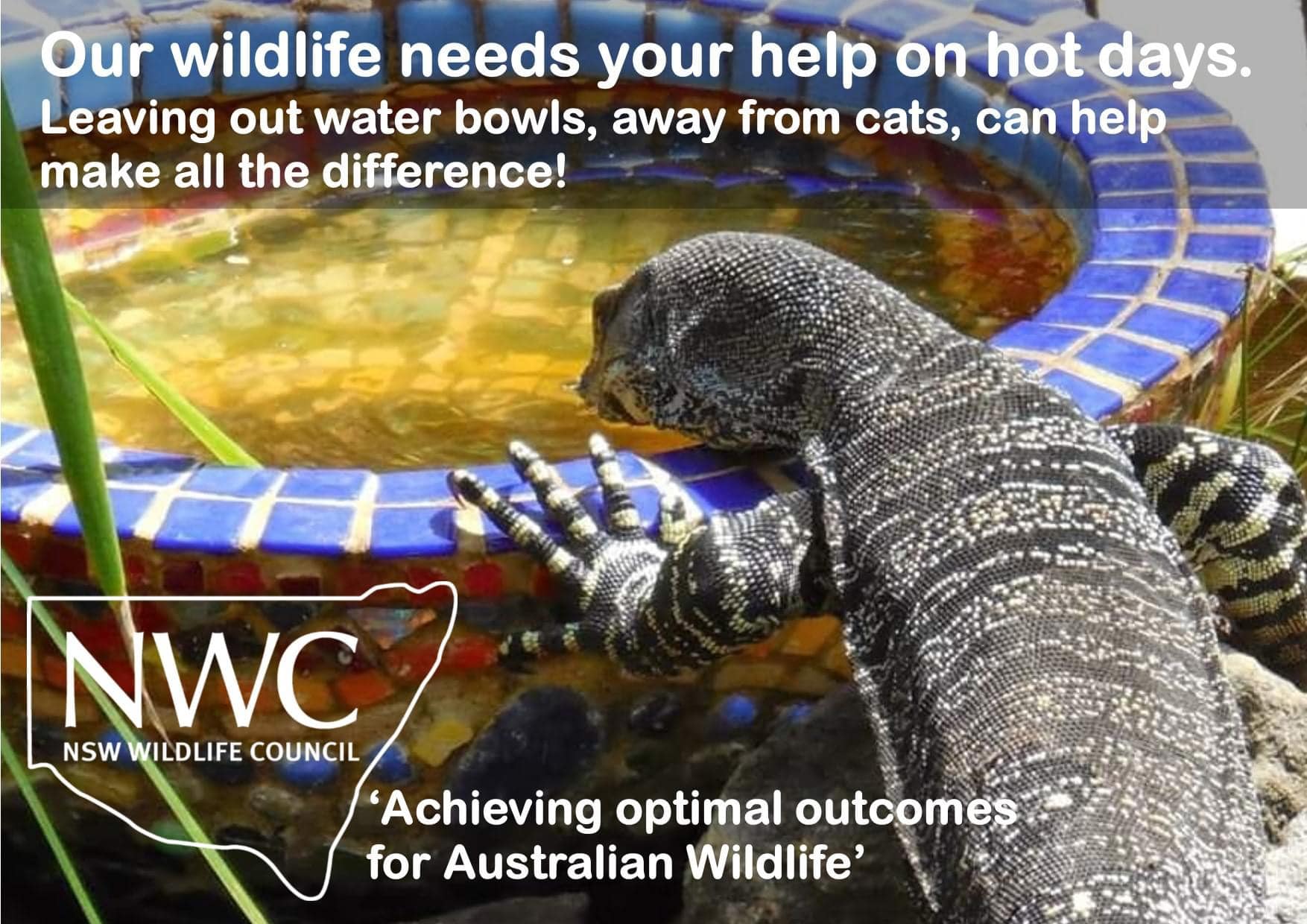
New Shorebirds WingThing For Youngsters Available To Download
A Shorebirds WingThing educational brochure for kids (A5) helps children learn about shorebirds, their life and journey. The 2021 revised brochure version was published in February 2021 and is available now. You can download a file copy here.
If you would like a free print copy of this brochure, please send a self-addressed envelope with A$1.10 postage (or larger if you would like it unfolded) affixed to: BirdLife Australia, Shorebird WingThing Request, 2-05Shorebird WingThing/60 Leicester St, Carlton VIC 3053.
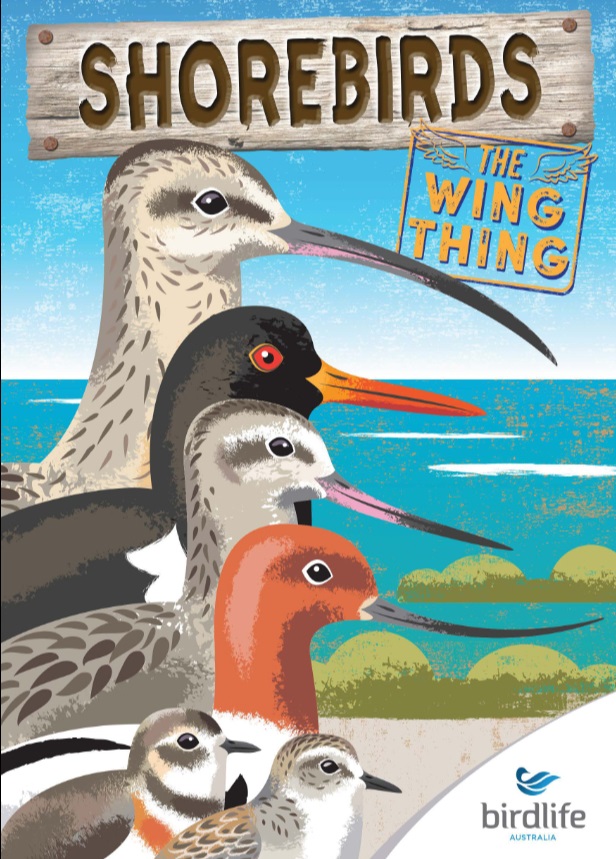
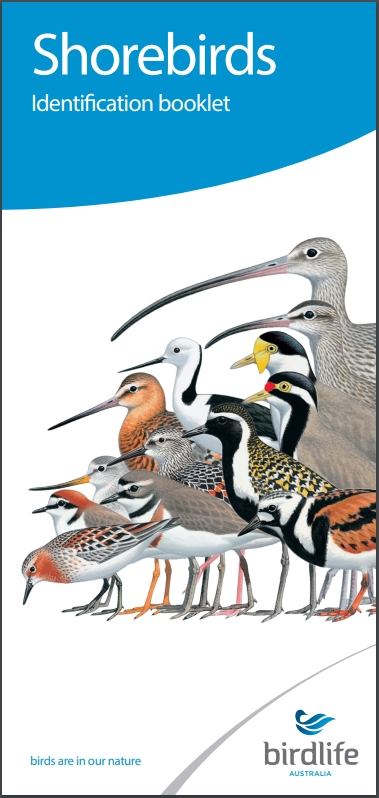 Shorebird Identification Booklet
Shorebird Identification Booklet
The Migratory Shorebird Program has just released the third edition of its hugely popular Shorebird Identification Booklet. The team has thoroughly revised and updated this pocket-sized companion for all shorebird counters and interested birders, with lots of useful information on our most common shorebirds, key identification features, sighting distribution maps and short articles on some of BirdLife’s shorebird activities.
The booklet can be downloaded here in PDF file format: http://www.birdlife.org.au/documents/Shorebird_ID_Booklet_V3.pdf
Paper copies can be ordered as well, see http://www.birdlife.org.au/projects/shorebirds-2020/counter-resources for details.
Download BirdLife Australia's children’s education kit to help them learn more about our wading birdlife
Shorebirds are a group of wading birds that can be found feeding on swamps, tidal mudflats, estuaries, beaches and open country. For many people, shorebirds are just those brown birds feeding a long way out on the mud but they are actually a remarkably diverse collection of birds including stilts, sandpipers, snipe, curlews, godwits, plovers and oystercatchers. Each species is superbly adapted to suit its preferred habitat. The Red-necked Stint is as small as a sparrow, with relatively short legs and bill that it pecks food from the surface of the mud with, whereas the Eastern Curlew is over two feet long with a exceptionally long legs and a massively curved beak that it thrusts deep down into the mud to pull out crabs, worms and other creatures hidden below the surface.
Some shorebirds are fairly drab in plumage, especially when they are visiting Australia in their non-breeding season, but when they migrate to their Arctic nesting grounds, they develop a vibrant flush of bright colours to attract a mate. We have 37 types of shorebirds that annually migrate to Australia on some of the most lengthy and arduous journeys in the animal kingdom, but there are also 18 shorebirds that call Australia home all year round.
What all our shorebirds have in common—be they large or small, seasoned traveller or homebody, brightly coloured or in muted tones—is that each species needs adequate safe areas where they can successfully feed and breed.
The National Shorebird Monitoring Program is managed and supported by BirdLife Australia.
This project is supported by Glenelg Hopkins Catchment Management Authority and Hunter Local Land Services through funding from the Australian Government’s National Landcare Program. Funding from Helen Macpherson Smith Trust and Port Phillip Bay Fund is acknowledged.
The National Shorebird Monitoring Program is made possible with the help of over 1,600 volunteers working in coastal and inland habitats all over Australia.
The National Shorebird Monitoring program (started as the Shorebirds 2020 project initiated to re-invigorate monitoring around Australia) is raising awareness of how incredible shorebirds are, and actively engaging the community to participate in gathering information needed to conserve shorebirds.
In the short term, the destruction of tidal ecosystems will need to be stopped, and our program is designed to strengthen the case for protecting these important habitats.
In the long term, there will be a need to mitigate against the likely effects of climate change on a species that travels across the entire range of latitudes where impacts are likely.
The identification and protection of critical areas for shorebirds will need to continue in order to guard against the potential threats associated with habitats in close proximity to nearly half the human population.
Here in Australia, the place where these birds grow up and spend most of their lives, continued monitoring is necessary to inform the best management practice to maintain shorebird populations.
BirdLife Australia believe that we can help secure a brighter future for these remarkable birds by educating stakeholders, gathering information on how and why shorebird populations are changing, and working to grow the community of people who care about shorebirds.
To find out more visit: http://www.birdlife.org.au/projects/shorebirds-2020/shorebirds-2020-program
Aussie Bread Tags Collection Points

Champions Crowned At The 2021 Woolworths Surfer Groms Comp. In Kiama: Northern Beaches Leg Runs December 11-12
Kiama came alive on Monday November 15th 2021 as the Woolworths Surfer Groms Comps saw all champions crowned in one-to-two foot conditions at Jones Beach.
Kash Brown (Cronulla) will be heading back to the Sutherland Shire with his head held high as he notched up two excellent scoring waves to gain the upper hand against his fellow finalists in the Under-14 Boys. Brown finished the final with a solid 16.50 heat total to claim the title from perennial standout Ocean Lancaster (Merewether) who finished in second place.
Local surfer Lucy Darragh (Gerringong) claimed her second Woolworths Surfer Groms Comps title in as many weeks, taking out the Under-14 Girls. Darragh took down some stellar competition to end up on the top of the dais with an impressive 11.26 heat total.
Jaggar Phillips (Maroubra) made his presence felt in the Under-12 division, taking wins in every one of his heat en route to the final where he claimed the heat with a 13.33 two-wave total. Phillips smashed out an array of powerful forehand snaps and carves in the final to take the win.
Local female surfer Kendall Payne (Gerringong) followed the same pattern as Darragh in the Under-10 Girls division, taking a win for the south coast locals. Payne finished the final with a decent 10.10 two-wave heat total to claim the win.
HUGE CONGRATULATIONS to Cody Cattle (Narrabeen), Ben Zanatta (Dee Why) and Ruby Trew (Manly), who were among the winners by competition end.
Ruby followed this up by becoming, on Monday November 22nd became the Under 14 Woolworths NSW Junior State Titles Champion - more in this week's Aquatics page.
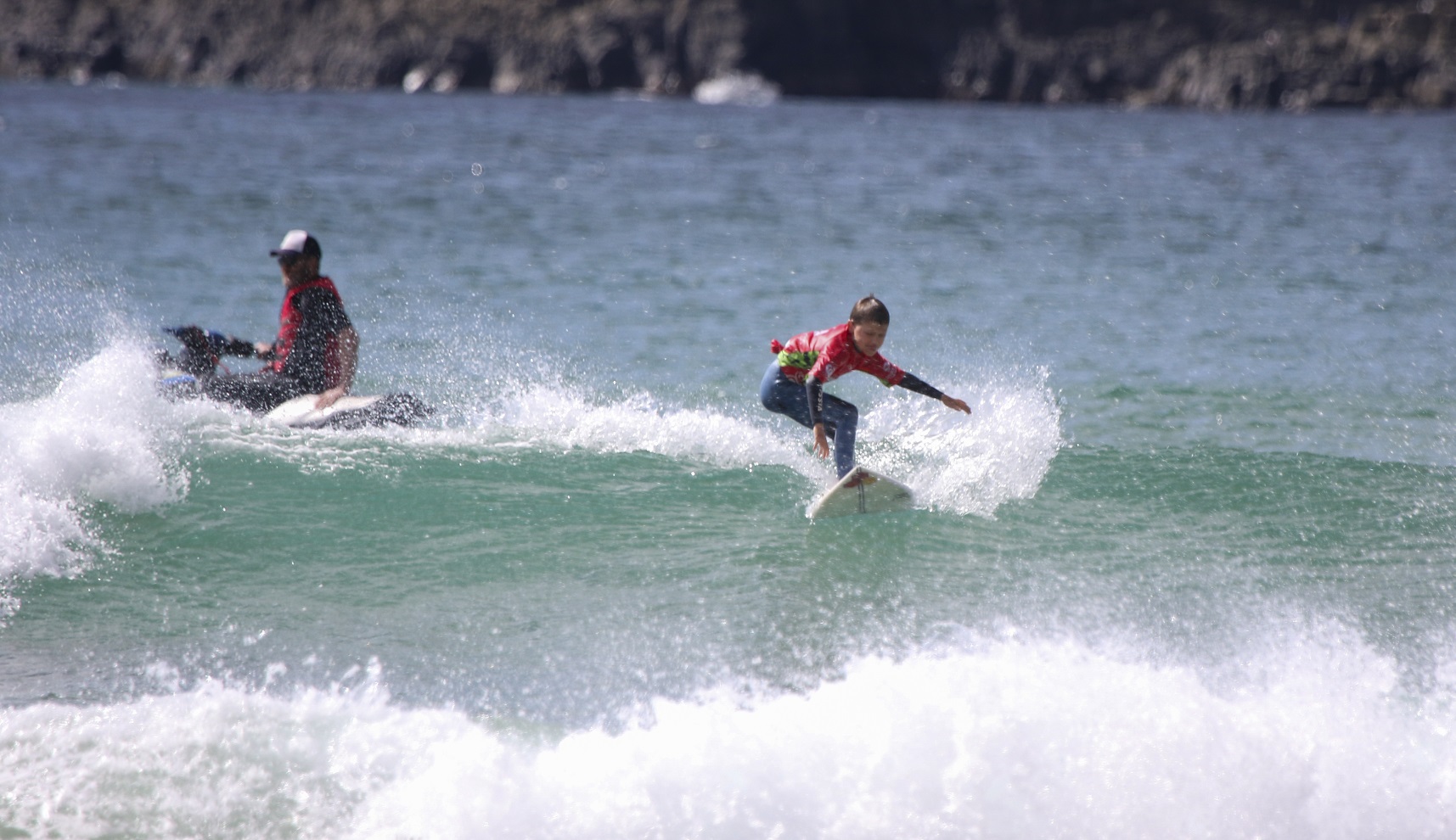
Cody Cattle - Photo: Josh Brown / Surfing NSW

Ben Zanatta - Photo: Josh Brown / Surfing NSW
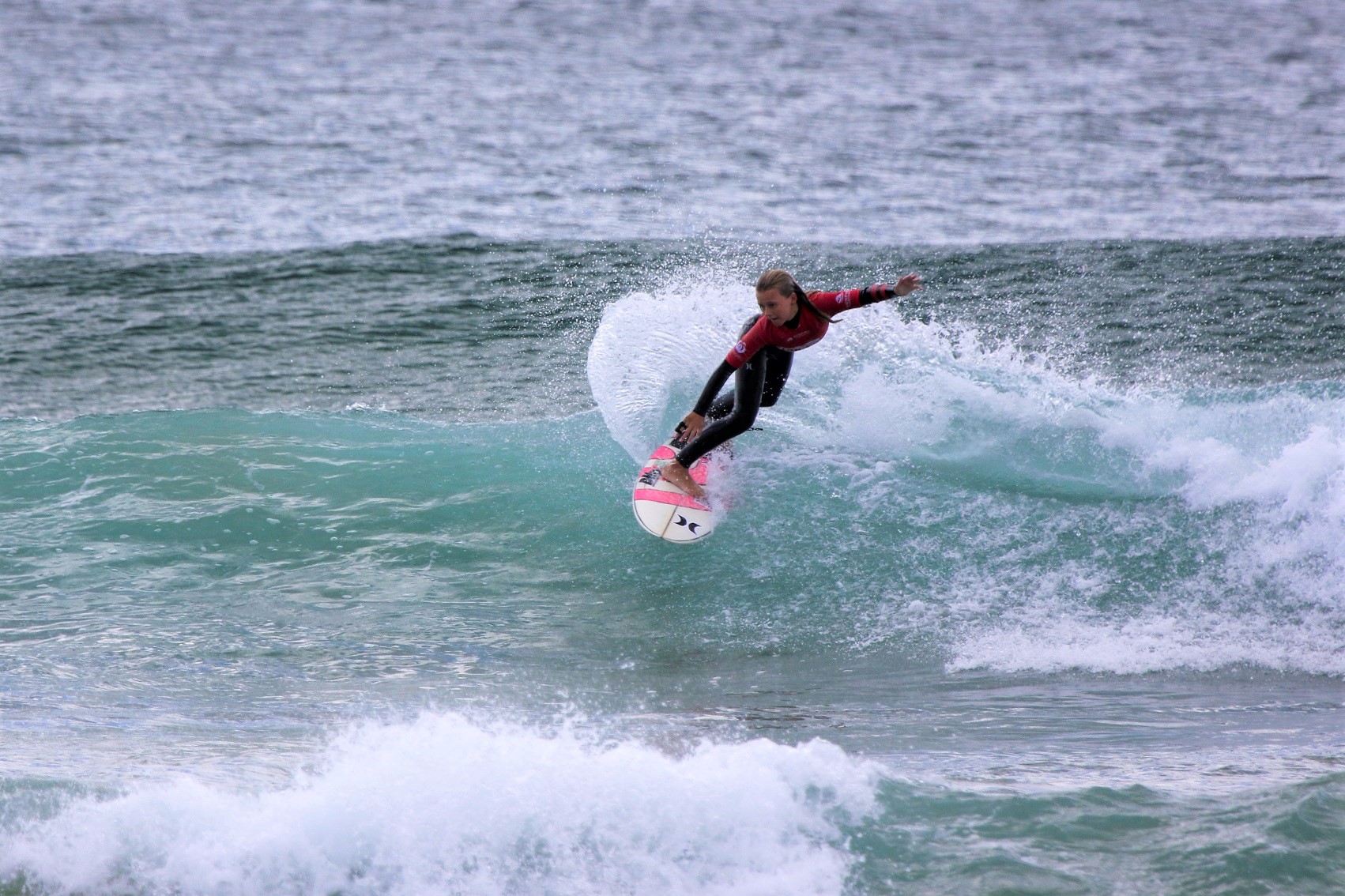
Ruby Trew - Photo: Josh Brown / Surfing NSW
This great event for youngsters saw surfers competing in four different age divisions, starting at Under-8’s right through to the Under-14’s. Close to 80 competitors were in the event.
All competitors and spectators abided by the COVID-19 regulations that were in place on the event days.
Regarded as one of the major steppingstones in the development of young Australian surfers, the 10-event Wool Comps series caters for surfers from Under 8 to Under 14 and will be held in New South Wales, Queensland, Victoria, Western Australia, Tasmania and South Australia over summer.
As an added bonus, the respective winners of the Under 14 boys’ and girls’ divisions from each event will receive an invite to attend an all-expenses-paid, three-day Woolworths Surfer Groms Comps National Final Surf Camp, (1-day coaching clinic, two days of competition and heat analysis coaching) at the Surfing Australia High-Performance Centre (HPC). For the South Australian, Victorian and Tasmanian events, the Woolworths Surf Camp prize will be awarded to the highest place Under-14 Boy and Girl who reside in that respective state.
The Northern Beaches edition of this years' Woolworths Surfer Groms Comp. will run over the weekend of December 11th and 12th.
Woolworths Surfer Groms Comps 2021 Schedule:
- Surfer Groms Comps – EVENT 1 – Fleurieu Peninsula, SA – Oct 16, 2021
- Surfer Groms Comps – EVENT 2 – Trigg, WA – Oct 23 – 24, 2021
- Surfer Groms Comps – EVENT 3 – Clifton Beach, TAS – Oct 30, 2021
- Surfer Groms Comps – EVENT 4 – Coffs Harbour, NSW – Nov 6 – 7, 2021
- Surfer Groms Comps – EVENT 5 – Kiama, NSW – Nov 13 -14, 2021
- Surfer Groms Comps – EVENT 6 – Gold Coast, QLD – Nov 20 – 21, 2021
- Surfer Groms Comps – EVENT 7 – Torquay, VIC – Nov 27 – 28, 2021
- Surfer Groms Comps – EVENT 8 – Cronulla, NSW – Dec 4 – 5, 2021
- Surfer Groms Comps – EVENT 9 – Northern Beaches, NSW – Dec 11 – 12, 2021
- Surfer Groms Comps – EVENT 10 – Sunshine Coast, QLD – Dec 11 – 12, 2021
- Surfer Groms Comps – Nat Final – Surfing Aus HPC, Casuarina NSW – Dec 17 – 19, 2021
RESULTS:
Pics Star Performer
Holly Walker (Kiama Downs)
Lucy Darragh (Gerringong)
Woolworths Pick Fresh, Play Fresh Award
Lani Caincross (Kiama Downs)
Ocean Lancaster (Merewether)
U8 Mixed
4th Riley Woods (Kiama Downs)
3rd Everly Morgan (Milton)
2nd Clive Morriss (Avoca Beach)
1st Hayden Mee (Merewether)
U10 Girls
4th Olive Morriss (Avoca Beach)
3rd Jamie Paipa (Cronulla
2nd Rubylee Neil (Kiama Downs)
1st Kendall Payne (Gerringong)
U10 Boys
4th Ollie Croft (Burraneer)
3rd Cody Cattle (Narrabeen)
2nd Hayden Mee (Merewether)
1st Nixon Clark (Bronte)
Photo: Josh Brown / Surfing NSW
U12 Girls
4th Sophia Lamberger (Thirroul)
3rd Lucy Darragh (Gerringong)
2nd Lani Caincross (Kiama Downs)
1st Talia Tebb (Kincumber)
U12 Boys
4th Joe Rocco Sommerville (Thirroul)
3rd Banjo Harvey (Elanora High)
2nd Omar Moltzen (Boomerang)
1st Jaggar Phillips (Maroubra)
U14 Girls
4th Ruby Trew (Manly)
3rd Grace Gosby (Cronulla)
2nd Alice Hodgson (Kiama Downs)
1st Lucy Darragh (Gerringong)
Photo: Josh Brown / Surfing NSW
U14 Boys
4th Ben Zanatta (Dee Why)
3rd George Messiter (Maroubra)
2nd Ocean Lancaster (Merewether)
1st Kash Brown (Cronulla)
Photo: Josh Brown / Surfing NSW
All About Pollination
Published by Royal Botanic Gardens and Domain
Do you know the important role bees, butterflies, moths, birds and marsupials have in pollinating plants?
Pollination is the fertilisation of a plant via pollen transfer from the male part of the plant to the female part of the plant – on either the same plant (self-pollination) or between flowers on different plants of the same species (cross-pollination). Pollination is vital for plants to create seeds.
For some plants, pollination can occur by wind or water. However almost 90% of flowering plants need an animal pollinator. The introduced European honeybee may be the most well-known, but there are many other insects that pollinate flowers: butterflies, flies, moths, wasps, beetles, ants, and over 2000 native Australian bee species. Other animals also provide pollination services, including lizards, flying foxes, birds, rodents, gliders, and possums.
Sleepy Seals And Adorable Pups!
Published November 22, 2021 by BBC Earth Kids
Edwin Towler takes us to visit some very sleepy seals and their curious pups, finds a herd of regal red deer and visits a mother fox, with four adorable cubs.
Curious Kids: how do birds make their nests?
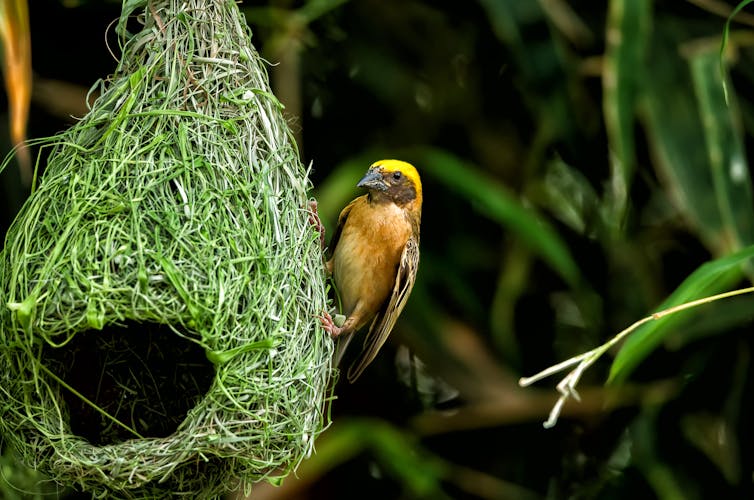
I would please like to know how birds make their nests? How do they know how to weave the twigs together and what makes the twigs stick together? – Miguel, age 10, Brisbane
Hi Miguel, thanks for this great question!
The first thing to know is not all birds make nests. For example, emperor penguin fathers carry their precious egg on their feet (to keep it off the frozen ground).
Some birds, such as cuckoos, will lay their eggs in someone else’s nests. Others lay them on the ground among leaves or pebbles, or on cliffs with very little protection.
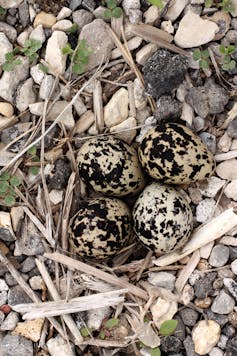
For the birds that do build nests, there is one main goal: to keep their eggs and chicks safe.
Many Places To Build A Nest
Many birds also make their nests in tree hollows, including parrots. That’s just one reason it’s important to not cut trees down!
Meanwhile, kookaburras use their powerful beaks to burrow into termite nests and make a cosy nest inside. And the cute spotted pardelote will dig little burrows in the side of earth banks – with a safe and cosy spot for its eggs at the end of the tunnel.
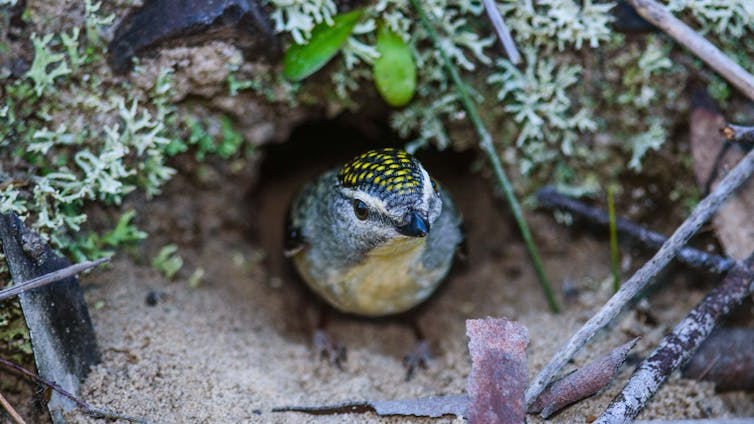
Some birds, such as brush turkeys, spend months building huge mounds on the ground which can heat up from the inside. The male turkey makes sure the ground is exactly the right temperature inside the mound, and then lets the female lay the eggs inside. He’ll take big mouthfuls of dirt surrounding the eggs to check it’s not too hot or cold.
What Materials Do They Use?
Birds construct many different types of nests. There are floating nests, cups, domes, pendulums and basket-shaped nests. They can be made out of sticks, twigs, leaves, grasses, mosses or even mud.
Magpie-larks (also called “peewees”), apostlebirds and choughs make mud bowl nests that look like terracotta plant pots. To do this, they gather mud and grasses in their beaks and shake it around to mix it with their saliva. They can then attach it to a branch and build upwards until the nest is complete.
In fact, bird saliva is a really strong and sticky material to build nests with. Birds will often mix saliva and mud to make a type of glue. And some swiftlets make their nests entirely out of solidified saliva. People will even eat these nests in bird’s nest soup!
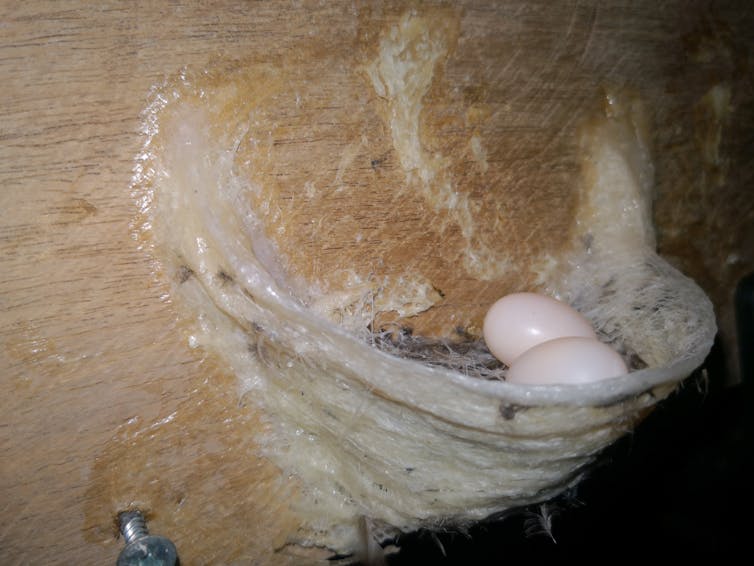
Willie wagtails use another type of glue - sticky spiderwebs. They “sew” grasses together using spider webs and the webs help keep the nests strong against wind and water, too. They have to perfect the technique of gathering the spiderweb though, otherwise it can get tangled in their feathers.
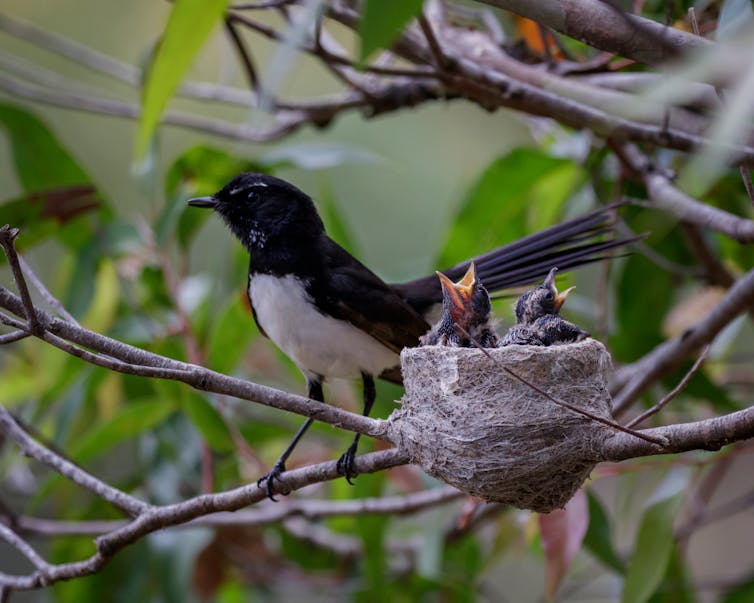
Magpies and crows, both common visitors to our gardens, are also clever nest builders. Not only can they expertly layer their sticks into a bowl, but they also use many human-made materials in their nests. You might find them using fabric, string or a wire to hold a nest together.
Some birds such as red kites have even been seen “decorating” their nests with human rubbish. And Australian babblers line the inside of their nests with a thick wall of kangaroo poo, followed by soft fluff, to keep their chicks warm.
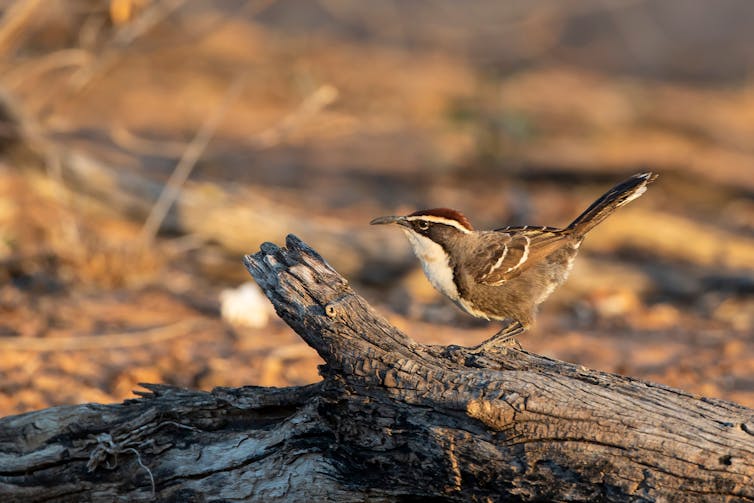
The Building Process
To actually weave the nests, birds will usually create a base by layering sticks or twigs in the place they want it. Then they use their beaks and feet to weave a chosen materials through, to hold the sticks in place.
They can pull strips of material with their beaks over and under, just like weaving a rug. They can even tie knots! Nests can take a really long time to make, so they’re often reused year after year. Weaver birds are so good at weaving, they can build complex nests that cover entire trees and have several chambers.
To summarise, birds are really intelligent animals. They use their intelligence, along with their beaks and feet, to find the most clever ways to make nests with whatever materials are available. And they get better at this by learning from others, such as their parents or peers.![]()
Kiara L'Herpiniere, PhD Candidate, Wildlife Biologist, Macquarie University
This article is republished from The Conversation under a Creative Commons license. Read the original article.
Nazare ALIVE - The Best Paddle Day EVER!
Published November 27, 2021 by Tim Bonython/Surfing Visions
NSW Rugby Union State 7s Championships 2021 U15'S And U17'S: Warringah And Manly + 2021 NSWJRU AGM Notes
The NSW Junior Rugby Union State Sevens Championships at Forster on Saturday and Sunday, November 20 and 21.
For the Warringah Rats Junior Rugby Union the NSW Youth 7s State Championships has become one of the highlights of the Season. A meticulously organised event with lots of great rugby on display and smiles on the faces of our rugby community.
Warringah’s U17 Boys were undefeated State Champions, beating Hunter, Mid North Coast, Gordon, Eastwood and Manly along the way. An outstanding achievement by them, and the first ever State Sevens title for Warringah Juniors.
This weekend was 7 years in the making. A team of mates playing together and staying together through the tough times makes the victory so much more enjoyable. Working hard as mates, winning well as a team.

Photo: Warringah Rats Junior Rugby Union
Warringah’s U15 Boys continue to improve, winning the Plate Final, which was coincidentally the same result the current U17s had 2 years ago. This group of fine young men that continue to grow and develop as rugby players and humans.

Warringah Rats Junior Rugby Union
Massive thanks to everyone involved that helped make the weekend such a resounding success. Doylo, Junior and the team from NSW Rugby did an amazing job organising and running the weekend. Thanks to the mighty Forster Tuncurry Dolphins for hosting the event, its always a pleasure to come and spend time in Forster/Tuncurry. Thanks to all the coaches and managers for preparing the teams, and looking after them over the course of the weekend. Thanks to all the parents and family for everything you do, it doesn't go unnoticed. And a special thanks to all the players for your commitment to Rats rugby, and representing Warringah with pride both on and off the field.
Already looking forward to 2022 - NSW Junior Rugby Union!!
The Wahu Manly Mermaids and Manly Marlins U15's are also now State Champions.
After an fantastic weekend in Forster representing Manly in the NSW 7s State Championships these amazing U15s Girls went through undefeated (6 from 6) to claim the NSW 7s State Champs title.
Coming into the competition with the smallest and youngest squad in the comp with 5 x 13 year old girls and 4 x 14year old all the girls showed their amazing skills and potential all weekend with some dazzling display of running and breakdown rugby. Awesomely coached and Managed by Buck and Leischa Gray it allowed for the girls to showcase their amazing skills.

Photo: Manly JRU

Photo: Manly JRU
Thank you to all the Manly coaches and parents and a huge and special thank you David Beat for being instrumental in getting Manly to Forster in 2021.
Congratulations to all teams, U15s finishing first in the state and U17s on some great playing and commitment to the game. Manly juniors are looking strong for the 2032 Olympics.
Thank you to our coaches and managers, great weekend team.
U15 girls - Coach Buck Gray & Manager Leischa Gray
U15 boys - Coach Harry Berryman & Manager Craig Poynton
U17 girls - Coach Stevie Berryman & Manager Andrew Bullman
U17 boys - Coach Tua Marsters & Manager Jodie Marsters.
Special mention to the very important support crew - Put Berryman, Matty Burke, Mania Marsters, Brad Fittler, Chas Tonga, Michael Donaghy, who all played a very important role.
Our camera and film crew - Carl Petersen & Tiahn Watters.
Add in and jersey designer Paladin Sports, James Hilterbrand, Georgia Grey, Ally Bullman. The very important parents.
Video below.
NSWRU Youth 7s Squads
On Thursday November 25theveryone who have been selected in the NSWRU Youth 7s squads was announced. Congratulations to local players who will form part of this.
NSWRU Under 15 Youth Boys 7s Squad
First Camp – Saturday 4th and Sunday 5th December, Location TBA
- Jarrah Bell
- Tomoko Berryman-Black
- Sam Blank
- Charlie Boyle
- Anthony Dean
- Zach Fittler
- Marshall Le Maitre
- Xavier Leota
- King Manu
- Corey Mcdougall
- Casey Mclean
- Daniel Mefou
- Harry Middleton
- Tuaomaliemavaitoelau Patea
- Jojo Justin Pese
- Charlie Poynton
- Will Rylands
- Itula Seve
- Mitchell Sweet
- Sam Talataina
- Jack Tully
- Daniel Usumaki
- Nathan Vaughan
- Joe Walsh
- Baxter Warner
NSWRU Under 17 Youth Boys 7s Squad
First Camp – Saturday 4th and Sunday 5th December, Location TBA Second Camp – 24th and 25th January, Location TBA
- Leo Bassingwhaite
- Ollie Cummins
- Faalentino (Tino) Jahnke-Tavana
- Thomas Klem
- Thomas Livingstone
- Tyrese Lokeni
- Henry Mann
- Maxwell Marsters
- Hamish McDonald
- Jesse McLean
- Sam Mitchell
- Rory Morgan
- Omar Nourredine
- Doug Philipson
- Rio Portersheen
- Charlie Poynton
- Jekope Sovau
- Angus Staniforth
- Savelio Tamale
- Josiah Vatubua
- Joe Walsh
- Finn Watkins
NSWRU Under 17 Youth Girls 7s Squad
First Camp – Saturday 4th and Sunday 5th December, Location TBA Second Camp – 24th and 25th January, Location TBA
U15’s Girls will be notified of talent identification and invited into Rugby Australia’s Emerging Talent Squad.
- Sophia Addington
- Lilli Boyle
- Ally Bullman
- Edie Burke
- Ella Carlisle
- Isobel Gosper
- Georgia Grey
- Martha Harvey
- Olivia Herman
- Chloe Jackson
- Ella Koster
- Kyanna Lokeni
- Madison McAthur
- Faitala Moleka
- Lailani Montgomery
- Ambryn Murphy-Haua
- Aliyah Nasio
- Ava Osland
- Taytana Pati Ah-Cheung
- Liliana Reardon
- Sofia Saroukos
- Piper Simons
- Monalisa Soliola
- Jesse Southwell
- Manilita Takapautolo
- Brooke Talataina
- Georgina Tuipulotu
The 2021 NSWJRU Presidents report by Ben Gregory, who is standing down after 8 years in an executive role, 5 of them as president, published November 25, 2021 can be read in full here: https://www.nswjuniors.com.au/post/2021-nswjru-presidents-report
Mr. Gregory's 2021 Report informs us that NSWJRU have updated and replaced all our City vs Country Trophies and State Championship Shields. A sub-committee was formed to dedicate a number of the vacant Age group Shields to NSWJRU people who have had a major impact on State Champs history – a fitting way to honour their contribution. The Trophies are now known as;
NSWJRU State Gala
- U10 Boys – The A.E.Fisher ‘Spirit of Rugby’ Shield
- U11 Boys – The G.R.Paton ‘Spirit of Rugby’ Shield
NSWJRU State Championships
- U12 Boys – The J.C.Degotardi Trophy
- U13 Boys – The B.J.Gregory Shield
- U14 Girls – The Phil Warner Trophy
- U14 Boys – The Hawton Trophy
- U15 Boys – The John Goddard Shield
- U16 Girls – The Kerry Brady Shield
- U16 Boys – The Chas Hansen Trophy
- U18 Girls – The J.B.Carroll Shield
- U18 Boys – The N.S.W.J.R.U Shield
NSWJRU City vs Country
- U14 Boys – The Tim Gavin Shield
- U14 Girls – The N.S.W.J.R.U Sponsors Plate
- U15 Boys – The Steve Tuynman Cup
- U16 Boys – The Ella Cup
- U16 Girls – The Mahalia Murphy Shield
- U18 Boys – The Michael Brial Cup
- U18 Girls – The Grace Hamilton Shield
There is also the Dave McCormack Memorial Shield awarded to the best NSW Country player at the U14 City vs Country game.
For the record the State Champions in 2021 were;
- U12 Boys – Warringah (held at Camden Rugby Park, Camden)
- U13 Boys – Western Sydney Two Blues (held at Apex Oval, Dubbo)
- U14 Girls - Western Sydney Two Blues (held at Boronia Park, Hunters Hill)
- U14 Boys – Penrith (held at Endeavour Oval, Orange)
- U15 Boys – Manly (held at St Lukes Oval, Concord)
- U16 Girls – Penrith & Gold Coast Coomera (held at Boronia Park, Hunters Hill)
- U16 Boys – Gordon (held at Rat Park, Narrabeen)
- U18 Girls – Sydney University (held at Boronia Park, Hunters Hill)
- U18 Boys – Randwick (held at Rat Park, Narrabeen)
Ben says the 2022 version of the State Championships will see the inclusion of the Country Champs and a NEW SJRU "Sydney" Championship to be held within the State Champs format over the June long weekend. A very exciting addition for the U14 and older age groups.
The Annual General Meeting of NSWJRU was held on Thursday, November 25, 2021
The Committee elected for 2022:
NSWJRU President - Andrew Hutton
VP Commercial - Tony Fisher
VP Reps - Ben Gregory
VP State Champs - Gary Paton
At the NSWJRU AGM the Committee had the honour of nominating their Patrons for 2022 and have named DARREN COLEMAN & GRACE HAMILTON as the Patrons of NSW Juniors for 2022. It doesn't get much better than that.
So you have the Head Coach of the TOP team in NSW - our Waratahs and the Captain of the Waratah Women Super W team and the Buildcorp Wallaroos both supporting the grassroots part of our junior game. Sensational!
2021 ARIA Awards: Local Winners Include Lime Cordiale + Angus & Julia Stone

The 2021 ARIA Awards in partnership with YouTube Music, was broadcast live from Sydney’s iconic Taronga on Cammeraigal country and streamed around the world on YouTube on Wednesday November 24th.
This was a celebration of the incredible talent and diversity of this year’s nominated artists, in what has been an extremely difficult year. Throughout the challenges and uncertainty 2021 has brought upon the music industry, Australian artists have continued to prove their extraordinary abilities to connect people through music.
For local artists its been a good ARIA's 2021 year.
Lime Cordiale won Best Australian Live Act presented by Heaps Normal for their 2021 Relapse Tour. The band played their biggest shows since the pandemic halted live music. Named after the deluxe edition of their 2020 album ’14 Steps To A Better You (Relapse)’, included six new songs or, as the band referred to them on social media, “6 more steps to better the you”. This is Lime Cordiale's second ARIA Award after winning Best Breakthrough Artist in 2020.
In a nice twist, the award was presented by The Wiggles, with Anthony Field, Murray Cook and Jeff Fatt of former The Cockroaches fame, and sprung from Manly, beaming over the announcement. The newest member of The Wiggles, Tsehay Hawkins, 16, read out the winner.

Photo © ARIA - Australian Recording Industry Association Ltd.
Angus and Julia Stone returned to the music scene together after almost four years and won Best Original Soundtrack or Musical Theatre Cast Album for their unexpected, unguarded, and unforgettable soundtrack to the Life Is Strange: True Colors video game. The sibling’s hiatus allowed them to explore their own artistic endeavours, but their reunion on this soundtrack produced a piece that’s a mix of their old and new work.
The In Memoriam segment of this Years' ARIAs featured Narrabeen-Collaroy Legend Doug Parkinson among other music luminaries such as Bert Newtown and the legendary Michael Gudinski and two members of the Party Boys, former Status Quo bassist Alan Lancaster and Warren McLean, Machinations, I'm Talking and the Divinyls, who used to rock out venues in our area.

Photo © ARIA - Australian Recording Industry Association Ltd.
Milla Brown-Ruby Trew Win 2021 NSW Junior State Titles


Ruby Trew showed her star was continuing to rise as she claimed the Under-14 Girls final. As a goofy-footer, Trew used her sharp backhand repertoire to muster up a solid 16.56 total to claim the final. Trew gained the title from north coast standout Ocea Curtis (Lennox Head) who put on a valiant performance to finish the final with a 14.00 total.
The 2021 Woolworths NSW Junior State Titles pres by Ocean and Earth at Illawarra ran from 17th – 22nd November 2021 with junior surfers from across the state competing for a coveted title in Under-14, Under-16, and Under-18 age divisions.
“It has been a difficult year for surfing events in the latter part of 2021, so it comes as some comfort that we can still crown some junior state champions in the closing months of the year,” said Surfing NSW CEO Luke Madden.
“Due to all competitors residing within NSW state borders and having no need to cross borders – as well as developing a thorough COVID safe plan – we feel the Woolworths Junior State Titles pres. by Ocean and Earth is the perfect event to run for our up-and-coming junior talent. We thank Destination Wollongong for their support and we can’t wait to see who will claim a coveted NSW Title at the end of the event.”
Earlier in the competition Oliver Heintz (Avalon) showed he will be a name to watch out for in future years as he nabbed a first-round victory over perennial event standout Winter Vincent (Manly) in the Under-18 Boys division. Heintz lit up the tiny righthanders on his way to the win, knocking out a chain of mammoth backside hits to amass a gigantic 18.60 two-wave heat total.

Oliver Heintz. Photo: Josh Brown /Surfing NSW
TAFE NSW Offers Thousands Of Free Training Places
November 22, 2021
School leavers and jobseekers in the Northern Beaches now have access to thousands of free course places in the NSW Government funded Summer Skills, Lockdown Learning, and Job Trainer programs at TAFE NSW.
TAFE NSW is offering free training in courses aligned to meet the skills needs of businesses in NSW, such as aviation, construction, cyber security and hospitality.
TAFE NSW Managing Director Steffen Faurby said more than 20,000 people have already enrolled in fee-free Lockdown Learning courses, with almost 10,000 people studying with TAFE NSW for the first time.
“TAFE NSW has assisted thousands of people with free training to upskill themselves or their staff, enhance their job prospects, or begin retraining for a new career,” Mr Faurby said.
“With HSC exams underway, Summer Skills offers school leavers free short courses to upskill over the summer months, in courses such as Medical Terminology, Design and Build a Website, and Retail Customer Service.”
TAFE NSW Northern Beaches will be offering the free Summer Skills course: Statement of Attainment in Introduction to Cookery Skills.
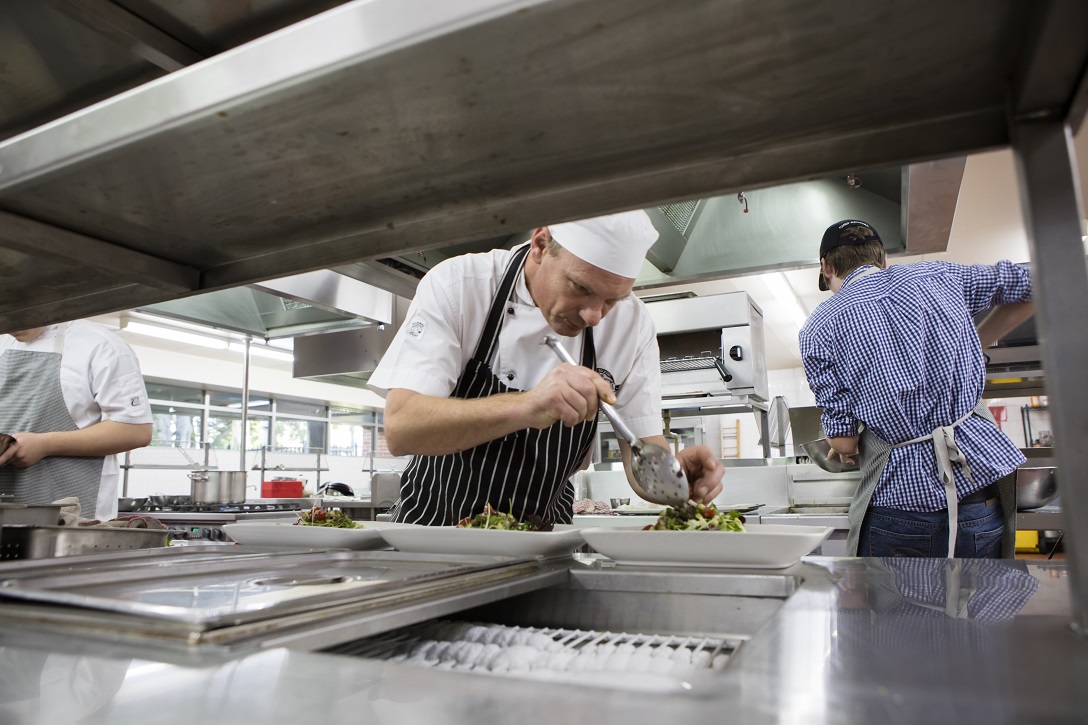
Leading employment marketplace Seek currently has 1,200 kitchenhand jobs in NSW on its site, with North Shore & Northern Beaches accounting for more than 140 of them.
TAFE NSW Head Teacher of Commercial Cookery Richard Etherington said the Statement of Attainment in Introduction to Cookery Skills is fully subsidised for eligible students and allows them to launch a career in the fast-paced hospitality industry.
“TAFE NSW is offering many Summer Skills courses via online learning or virtual classrooms, which means that no matter where you are located you can take up the opportunity to boost your employability and gain new skills,” Mr Etherington said.
“The Statement of Attainment in Introduction to Cookery Skills is being offered at the local Northern Beaches campus, and is a great opportunity for school leavers to learn practical cookery and kitchen organisational skills.
“Students will learn how to prepare dishes using basic methods of cookery, use hygienic practices for food safety, participate in safe work practices, and use food preparation equipment.”
For more information about studying at TAFE NSW, visit www.tafensw.edu.au or phone 131 601.
Sulphur Crested Cockatoo Mates: Our Place
Did you know you can only tell the gender of these birds by the colour of the eyes?: males have a solid black iris, females a red iris.
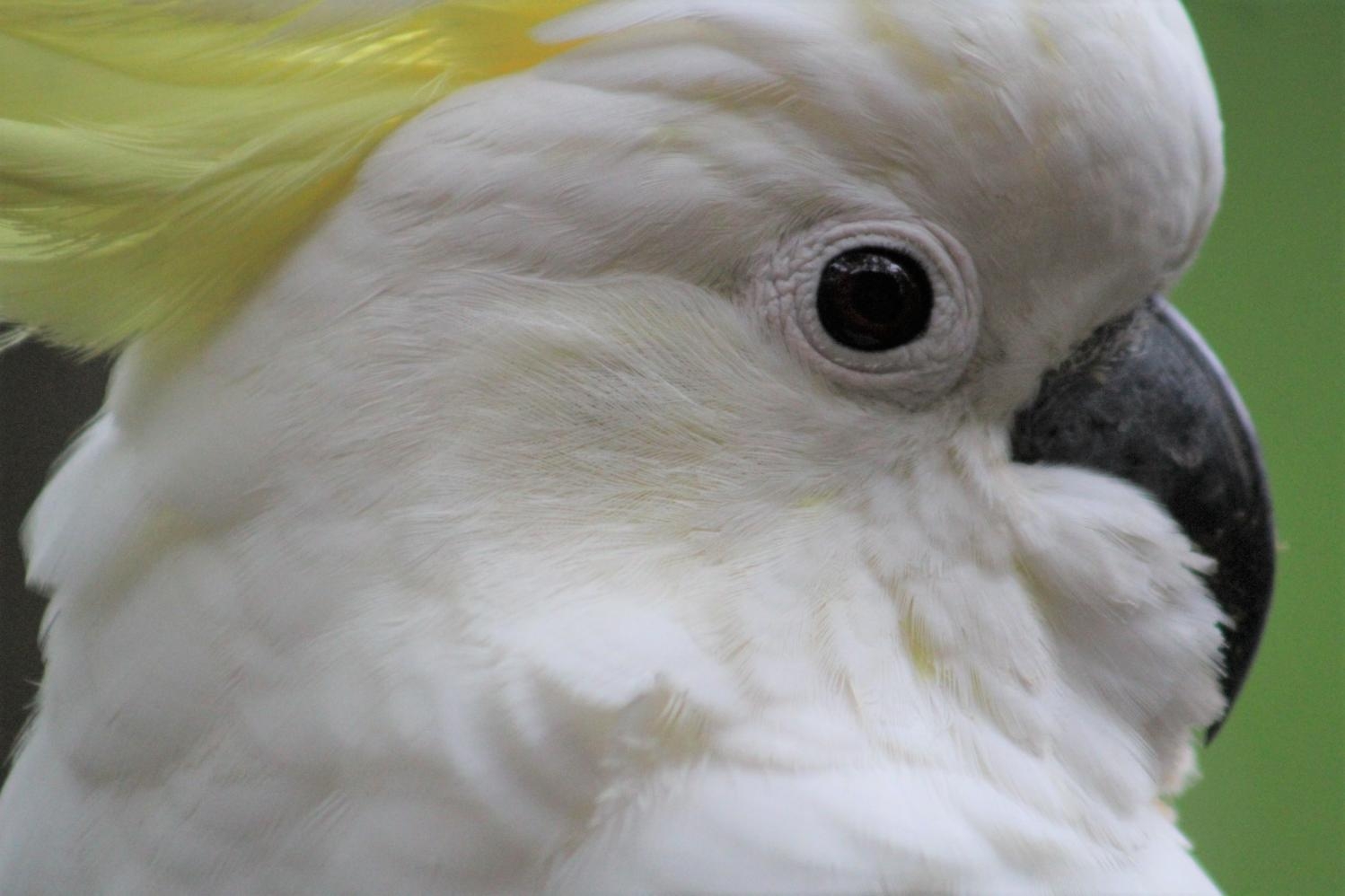
You're not like to see baby cockatoos because they don't emerge from the nest until they're bigger. But if you listen carefully you might hear them — they make a droning 'arrrrrrrr' call when they're begging for food and a quick staccato squeak when they're fed.
Tracking has also found cockatoos are very egalitarian when it comes to parenting, with each long-term partner taking turns to stay with the eggs and the chicks, while the other goes out foraging.
When they do grow up, cockatoos can live for a long time — perhaps 40 years in the wild to over 100-odd years in captivity.
Of the pair below one looks quite dirty - this can mean that its nesting and gets grubby getting in and out of that nest, or that it has lost its powder down feathers. It commonly affects young Sulphur Crested Cockatoos in their first year and is known as Psittacine Beak and Feather Disease Syndrome (PBFDS).
Infections can be treated and a non-stressful environment combined with a balanced diet may help during the course of the disease.
Parrots (scientific name: psittacines) have roughly 370 species and 80 genera that make up the order Psittaciformes. There is much debate over the grouping of families. Originally all birds in the order Psittaciformes were grouped into one family, but in light of recent research the parrots could be classified into three superfamilies: Strigopoidea, the New Zealand parrot super family; Cacatuoidea, the family of cockatoos; and Psittacoidea, the true parrots (Joseph et al. 2012).
Two characteristics that set psittacines apart from other birds include their strong, hooked beak (maxilla) which has a hinge-like flexible attachment to the skull and fits over the mandible. The other unique characteristic is their zygodactyl toes, meaning they have four toes on each foot, two pointing forward and two projecting backward. The positioning of the toes is especially useful for climbing and prehension. Psittacines are reportedly the only birds that hold their food in one foot to eat it. This arrangement of beak and toes allow psittacines to easily manoeuvre among many types of vegetation (Foster and Smith Inc 2015).
Parrots are thought of as rainforest inhabitants; however, in Australia, they have expanded out of the wetter forests and have evolved to fill many different niches, reaching their highest diversity in open woodlands. Parrots in the Australasian region have attained the greatest ecological and morphological diversity. The plumage of most parrots around the world are variants of green due to their rain forest habitat, however, in Australia, parrots are found with multiple colours including black, white, red, yellow, grey, and pink, due to their colonisation of a wide variety of habitats (Chambers 2009).
There are over 50 species of parrot in Australia, with over 40 endemic ones and around here - lots of sulphur crested cockatoos, all with their own personalities.
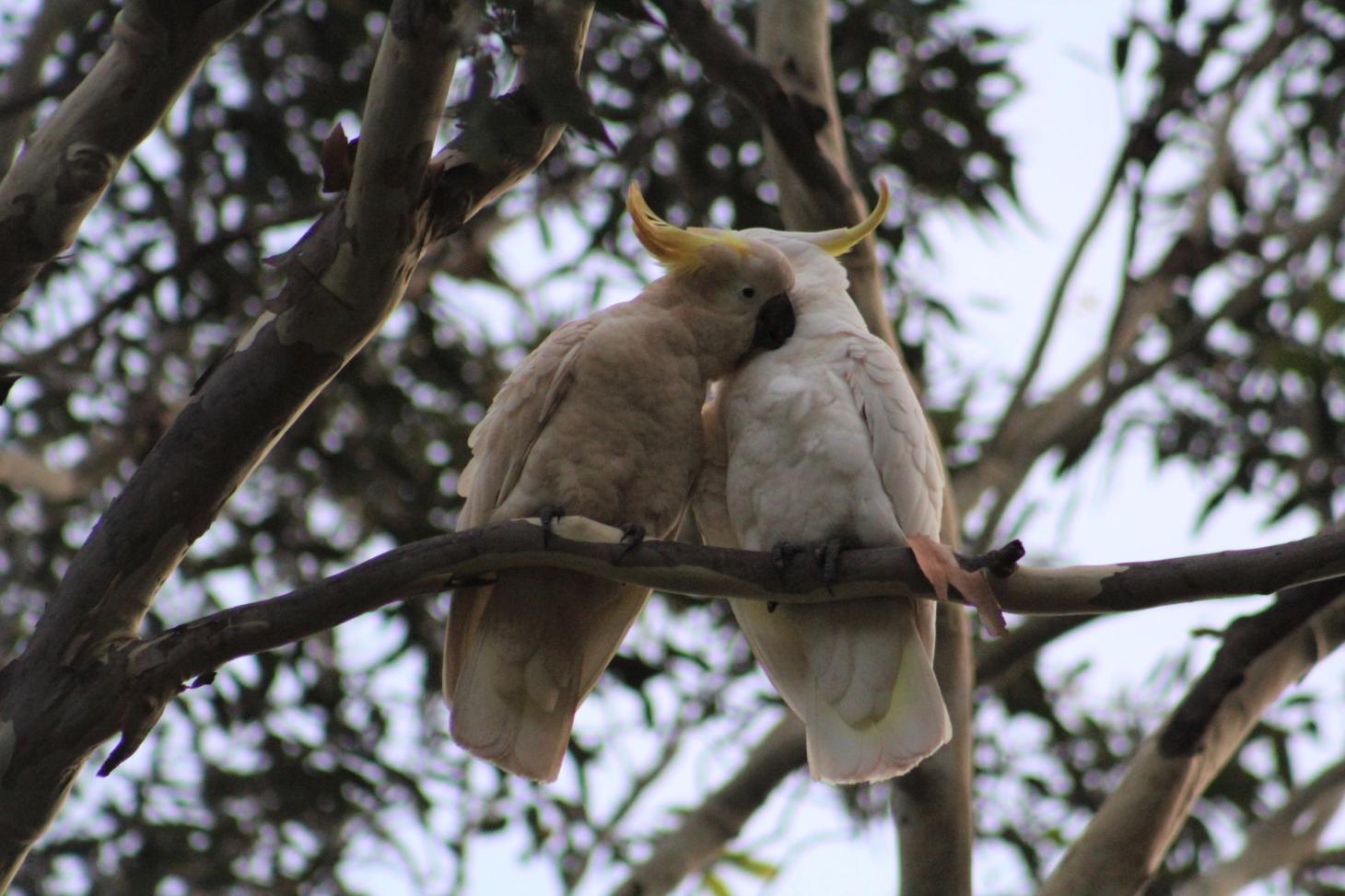
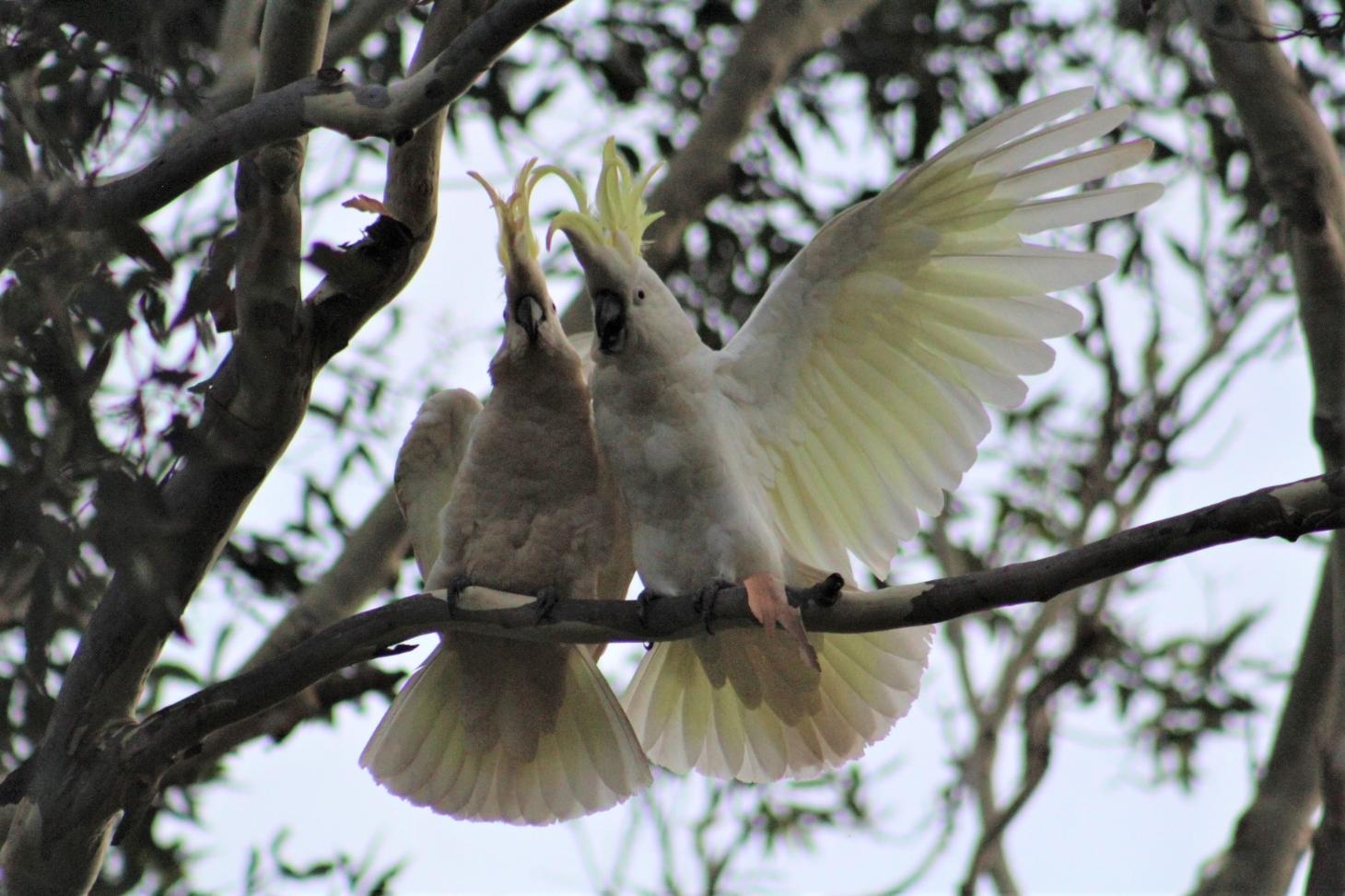
Could we really deflect an asteroid heading for Earth? An expert explains NASA’s latest DART mission
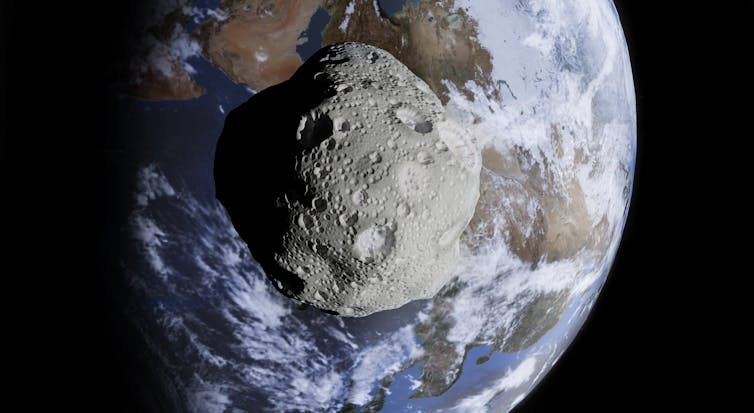
A NASA spacecraft the size of a golf cart has been directed to smash into an asteroid, with the intention of knocking it slightly off course. The test aims to demonstrate our technological readiness in case an actual asteroid threat is detected in the future.
The Double Asteroid Redirection Test (DART) lifted off aboard a SpaceX rocket from California on November 23, and will arrive at the target asteroid system in September, next year.
The mission will travel to the asteroid Didymos, a member of the Amor group of asteroids. Every 12 hours Didymos is orbited by a mini-moon, or “moonlet”, Dimorphos. This smaller half of the pair will be DART’s target.
Are We Facing An Extinction Threat From Asteroids?
We’ve all seen disaster movies in which an asteroid hits Earth, creating an extinction event similar to the one that killed off the dinosaurs millions of years ago. Could that happen now?
Well, Earth is actually bombarded frequently by small asteroids, ranging from 1-20 metres in diameter. Almost all asteroids of this size disintegrate in the atmosphere and are usually harmless.
There is an inverse relationship between the size of these object and the frequency of impact events. This means we get hit much more frequently by small objects than larger ones – simply because there are many more smaller objects in space.
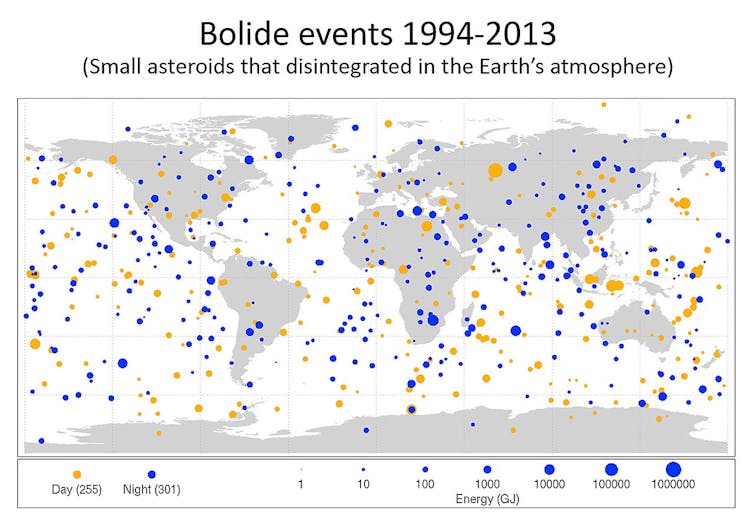
Asteroids with a 1km diameter strike Earth every 500,000 years, on average. The most “recent” impact of this size is thought to have formed the Tenoumer impact crater in Mauritania, 20,000 years ago. Asteroids with an approximate 5km diameter impact Earth about once every 20 million years.
The 2013 Chelyabinsk meteoroid, which damaged buildings in six Russian cities and injured around 1,500 people, was estimated to be about 20m in diameter.
Assessing The Risk
NASA’s DART mission has been sparked by the threat and fear of a major asteroid hitting Earth in the future.
The Torino scale is a method for categorising the impact hazard associated with a near-Earth object (NEO). It uses a scale from 0 to 10, wherein 0 means there is negligibly small chance of collision, and 10 means imminent collision, with the impacting object being large enough to precipitate a global disaster.
The Chicxulub impact (which is attributed to the extinction of non-avian dinosaurs) was a Torino scale 10. The impacts that created the Barringer Crater, and the 1908 Tunguska event, both correspond to Torino Scale 8.
With the increase of online news and individuals’ ability to film events, asteroid “near-misses” tend to generate fear in the public. Currently, NASA is keeping a close eye on asteroid Bennu, which is the object with the largest “cumulative hazard rating” right now. (You can keep up to date too).
With a 500m diameter, Bennu is capable of creating a 5km crater on Earth. However, NASA has also said there is a 99.943% chance the asteroid will miss us.
Brace For Impact
At one point in their orbit around the Sun, Didymos and Dimorphos come within about 5.9 million km of Earth. This is still further away than our Moon, but it’s very close in astronomical terms, so this is when DART will hit Dimorphos.
DART will spend about ten months travelling towards Didymos and, when it’s close by, will change direction slightly to crash into Dimorphos at a speed of about 6.6km per second.
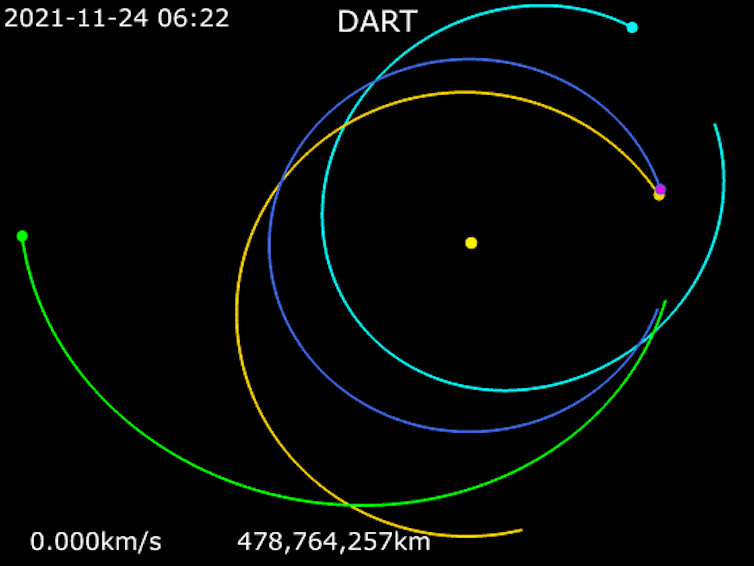
The larger Didymos is 780m in diameter and thus makes a better target for DART to aim for. Once DART has detected the much smaller Dimorphos, just 160m in diameter, it can make a last-minute course correction to collide with the moonlet.
The mass of Dimorphos is 4.8 million tonnes and the mass of DART at impact will be about 550kg. Travelling at 6.6km/s, DART will be able to transfer a huge amount of momentum to Dimorphos, to the point where it’s expected to actually change the moonlet’s orbit around Didymos.
This change, to the tune of about 1%, will be detected by ground telescopes within weeks or months. While this may not seem like a lot, 1% is actually a promising shift. If DART were to slam into a lone asteroid, its orbital period around the Sun would change by only about 0.000006%, which would take many years to measure.
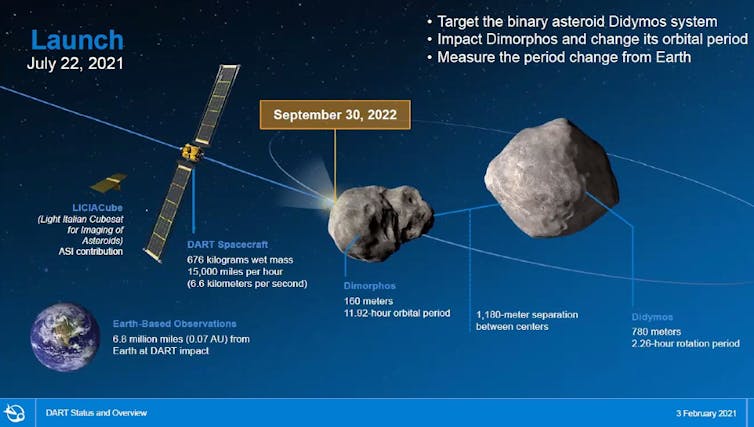
So we’ll be able to detect the 1% change from Earth, and meanwhile the pair will continue along its orbit around the Sun. DART will also deploy a small satellite ten days before impact to capture everything.
This is NASA’s first mission dedicated to demonstrating a planetary defence technique. At a cost of US$330 million, it’s relatively cheap in space mission terms. The James Webb Telescope set to launch next month, costs close to US$10 billion.
There will be little to no debris from DART’s impact. We can think of it in terms of a comparable event on Earth; imagine a train parked on the tracks but with no brakes on. Another train comes along and collides with it.
The trains won’t break apart, or destroy one another, but will move off together. The stationary one will gain some speed, and the one impacting it will lose some speed. The trains combine to become a new system with different speeds than before.
So we won’t experience any impact, ripples or debris from the DART mission.
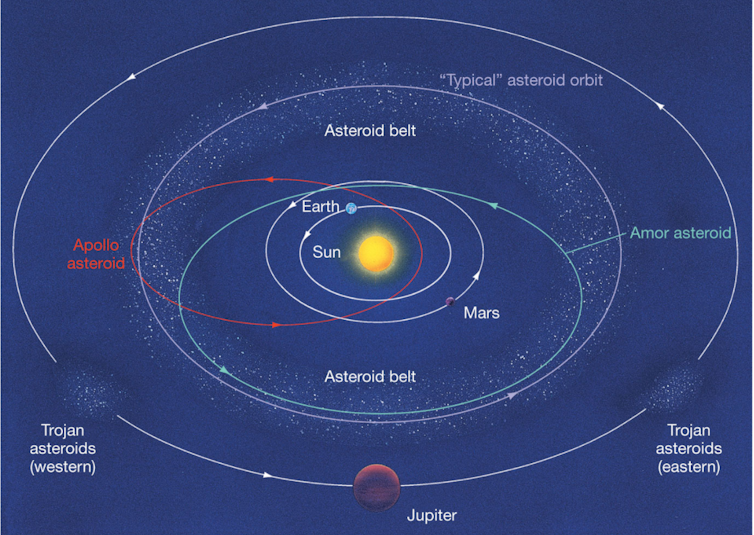
Is The Effort Really Worth It?
Results from the mission will tell us just how much mass and speed is needed to hit an asteroid that may pose a threat in the future. We already track the vast majority of asteroids that come close to Earth, so we would have early warning of any such object.
That said, we have missed objects in the past. In October 2021, Asteroid UA_1 passed about 3,047km from Earth’s surface, over Antarctica. We missed it because it approached from the direction of the Sun. At just 1m in size it wouldn’t have caused much damage, but we should have seen it coming.
Building a deflection system for a potential major asteroid threat would be difficult. We would have to act quickly and hit the target with very good aim.
One candidate for such a system could be the new technology developed by the US spaceflight company SpinLaunch, which has designed technology to launch satellites into orbit at rapid speeds. This device could also be used to fire masses at close-passing asteroids. ![]()
Gail Iles, Senior Lecturer in Physics, RMIT University
This article is republished from The Conversation under a Creative Commons license. Read the original article.
The Beatles: Get Back review – Peter Jackson’s TV series is a thrilling, funny (and long) treat for fans

The Beatles’ Get Back project, undertaken in January 1969, has finally been completed. Again.
For most of the last 50 years it has been known as Let it Be, a film and LP record released in 1970. The project, conceived by Paul McCartney, was originally intended to be a television special documenting the band’s preparation for a live concert (their first in two and a half years). Because of the performance element, the Beatles decided to get back to their roots and only develop material that could be played without adding overdubs.
As it happened, the concert didn’t go ahead, the Beatles famously deciding instead to play a short unannounced gig on the roof of their headquarters. The TV special became a feature film, and the audio was handed over to the “wall of sound” producer, Phil Spector (leading to controversial results).
Meanwhile, in the early 1980s, the Beatles withdrew the film version (a fly-on-the-wall documentary directed by Michael Lindsay-Hogg) from circulation.
Lindsay-Hogg’s Let it Be is remembered as a portrait of a band in the process of breaking up. And indeed, George Harrison did briefly quit the band early into the four-week project, though Lindsay-Hogg’s documentary does not cover this episode.
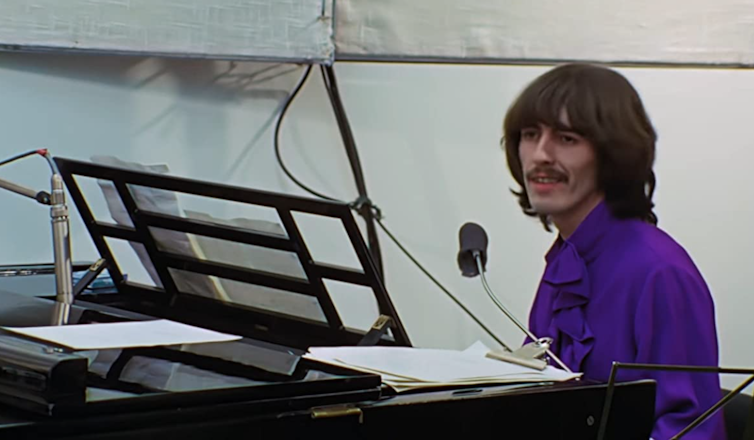
Let it Be was seen as a downer in part because the Beatles, especially Lennon, were keen to trash it in the light of the band’s breakup (which occurred just weeks before the release of Let it Be, both film and album). As Lennon said in December 1970, the shoot was “hell”, and Spector was “given the shittiest load of badly recorded shit”.
A Different Tenor
While the newly released The Beatles: Get Back, directed by Peter Jackson, covers Harrison’s departure and return, Jackson’s film is tonally different from Lindsay-Hogg’s. According to Jackson, the dour account of Let it Be is inaccurate, since there is much “joy” and friendship evident in the 60 hours of film and 150 hours of audio tape that has been sitting in a vault for half a century.
Much of this audio has long been available as bootlegs, informing written accounts of this period of the Beatles’ history. The audio without the video, however, doesn’t always tell the whole story.
While Jackson and his team haven’t shied away from the moments of friction, ennui, and aimlessness experienced by the band, the tenor of Get Back is more upbeat than Lindsay-Hogg’s version (though there is perhaps more levity in that film than Jackson or its reputation allows).
But Get Back is not just a recut of Let it Be; it is a documentary in its own right, a film about the making of a film. Lindsay-Hogg is now a character in the drama of trying to work out what the project is about, and how it will end.
Unlike the cinema verité style of Let it Be, Get Back gives much-needed context in the form of titles naming the protagonists and songs, as well as explaining what is happening. The use of a day-by-day countdown to the live performance gives the otherwise shapeless events a sense of narrative and even tension.
Get Back was to be a feature film with a theatrical release, but COVID-19 led to a rescheduling and reconceptualising of the work, so that it became a documentary for Disney+. Recent reports were that the series would be a three-part series with a six-hour running time.
The Climactic Rooftop Concert
As it turns out, that running time is closer to eight hours. (Let it Be is a mere 80 minutes long.) Almost all of these eight hours show the Beatles at work on a sound stage (at Twickenham Film Studios) or in an ad hoc recording studio (put together in the Beatles’ Apple headquarters, when – after Harrison’s walkout – it was decided that Twickenham wasn’t conducive to creativity).
The Apple studio is clearly more pleasant, and the tone is further lightened when the Beatles are joined by an outsider, their old friend Billy Preston, on keyboards (a crucial moment for the project).
There is nevertheless something of a hermetic feel to most of Get Back, so that when the Beatles and Preston head up to the rooftop to play in public – the cinematic “payoff” that the band and Lindsay-Hogg had been looking for throughout the project – there is a palpable sense of release.
And the famous rooftop concert, presented with creative use of split screen, is stunningly good (and is also, for the first time, presented in its 42-minute entirety).
After the countless run throughs and takes of the same songs over the preceding weeks (as well as numerous covers and early Beatles tunes), the sense of energy and the quality of playing gives the film the climactic moment that it needs, complete with police officers demanding, albeit politely, that the Beatles stop breaching the peace of London’s West End.
Cigarettes, Cups Of Tea, And White Bread
Get Back is very different from Let it Be in part due to Jackson’s editing, especially his use of montage, which produces a dynamic, sometimes frenetic, energy. Beyond these stylistic elements, Get Back is notable as a technical feat.
It looks and sounds astonishingly good, not something that was ever said about Let it Be. Jackson and his technical team have employed the kind of film restoration techniques used in his war documentary They Shall Not Grow Old (2018).
The vision in Get Back is beautifully saturated, sharp, and less grainy than Lindsay-Hogg’s film. Harrison and Starr, in their sartorial splendour, often resemble their cartoon equivalents from Yellow Submarine (1968).
If there is anything unvarnished about Jackson’s film it is the sight of people apparently living off cigarettes, cups of tea, and white bread. Also notably “historical” is the homosocial nature of the project; almost all of the active participants are men. Even Yoko Ono, who sits beside Lennon throughout, is almost entirely silent (save for her vocal participation in a couple of impromptu jams).
While the film has been painstakingly restored, the soundtrack has been almost remade. Much of the audio was recorded on mono quarter-inch tape. Jackson’s technical team used machine learning to effectively “remix” these mono tapes, allowing Jackson to hone in on individual voices masked by other sound sources (voices or musical instruments).

This is an extraordinary technological breakthrough, allowing key conversations to be heard properly for the first time, and for the remixing of the play throughs and rehearsals of songs, which weren’t being recorded as “takes” on the eight-track system.
Get Back is a treat for any Beatles fan. It’s a reminder, too, if one is needed, that some classic songs were recorded for the project. (Given that McCartney supplied at least three of these classics – Let it Be, The Long and Winding Road, and Get Back – it’s unsurprising that he has long been unsatisfied with the way they were originally showcased.)
But Jackson’s film isn’t all sweetness and light. Lennon, for instance, is dismissive of Harrison’s I, Me, Mine, and he makes a throwaway joke about Bob Wooler, a Liverpool disc jockey whom Lennon assaulted in 1963. Also notable is the relative absence of George Martin, who largely hands production duties to his sound engineer, Glyn Johns, surely a sign that Martin found something amiss with the project.
And indeed numerous sequences show a band lacking focus and discipline. Get Back, then, is unquestionably a mixed bag: thrilling, compelling, and funny, but also sometimes just a little boring.
In this, Jackson has been true to the original project. His extraordinary TV series is essential viewing for anyone interested in popular music.![]()
David McCooey, Professor of Writing and Literature, Deakin University
This article is republished from The Conversation under a Creative Commons license. Read the original article.
Pythagoras’ revenge: humans didn’t invent mathematics, it’s what the world is made of

Many people think that mathematics is a human invention. To this way of thinking, mathematics is like a language: it may describe real things in the world, but it doesn’t “exist” outside the minds of the people who use it.
But the Pythagorean school of thought in ancient Greece held a different view. Its proponents believed reality is fundamentally mathematical.
More than 2,000 years later, philosophers and physicists are starting to take this idea seriously.
As I argue in a new paper, mathematics is an essential component of nature that gives structure to the physical world.
Honeybees And Hexagons
Bees in hives produce hexagonal honeycomb. Why?
According to the “honeycomb conjecture” in mathematics, hexagons are the most efficient shape for tiling the plane. If you want to fully cover a surface using tiles of a uniform shape and size, while keeping the total length of the perimeter to a minimum, hexagons are the shape to use.
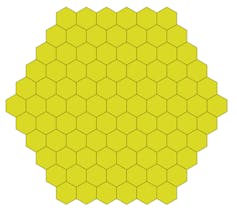
Charles Darwin reasoned that bees have evolved to use this shape because it produces the largest cells to store honey for the smallest input of energy to produce wax.
The honeycomb conjecture was first proposed in ancient times, but was only proved in 1999 by mathematician Thomas Hales.
Cicadas And Prime Numbers
Here’s another example. There are two subspecies of North American periodical cicadas that live most of their lives in the ground. Then, every 13 or 17 years (depending on the subspecies), the cicadas emerge in great swarms for a period of around two weeks.
Why is it 13 and 17 years? Why not 12 and 14? Or 16 and 18?
One explanation appeals to the fact that 13 and 17 are prime numbers.
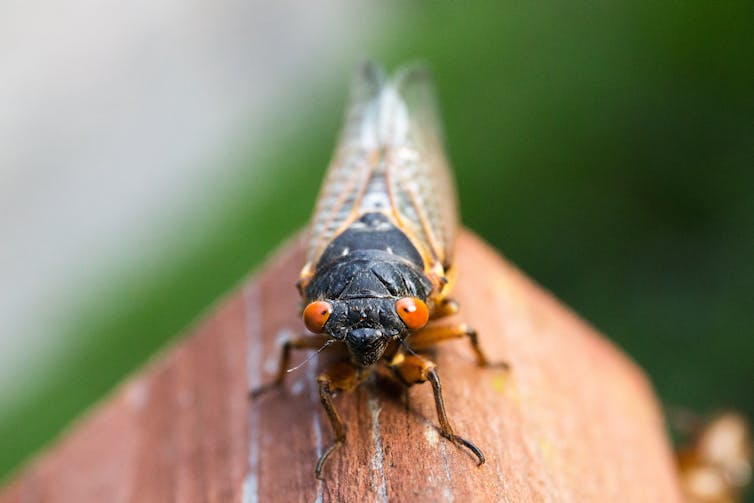
Imagine the cicadas have a range of predators that also spend most of their lives in the ground. The cicadas need to come out of the ground when their predators are lying dormant.
Suppose there are predators with life cycles of 2, 3, 4, 5, 6, 7, 8 and 9 years. What is the best way to avoid them all?
Well, compare a 13-year life cycle and a 12-year life cycle. When a cicada with a 12-year life cycle comes out of the ground, the 2-year, 3-year and 4-year predators will also be out of the ground, because 2, 3 and 4 all divide evenly into 12.
When a cicada with a 13-year life cycle comes out of the ground, none of its predators will be out of the ground, because none of 2, 3, 4, 5, 6, 7, 8 or 9 divides evenly into 13. The same is true for 17.
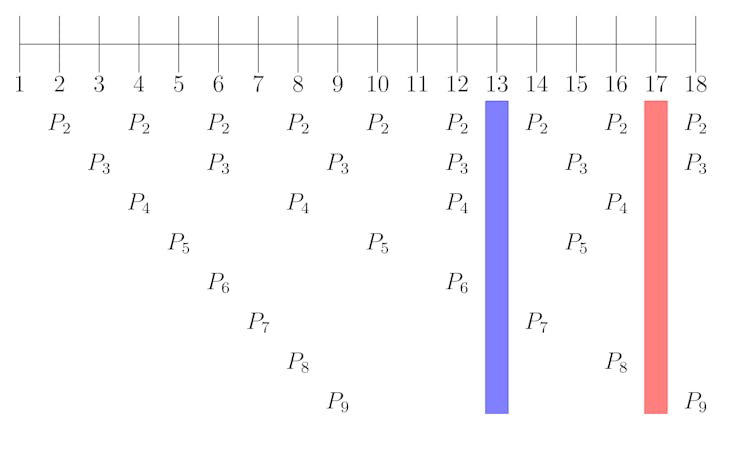
It seems these cicadas have evolved to exploit basic facts about numbers.
Creation Or Discovery?
Once we start looking, it is easy to find other examples. From the shape of soap films, to gear design in engines, to the location and size of the gaps in the rings of Saturn, mathematics is everywhere.
If mathematics explains so many things we see around us, then it is unlikely that mathematics is something we’ve created. The alternative is that mathematical facts are discovered: not just by humans, but by insects, soap bubbles, combustion engines and planets.
What Did Plato Think?
But if we are discovering something, what is it?
The ancient Greek philosopher Plato had an answer. He thought mathematics describes objects that really exist.
For Plato, these objects included numbers and geometric shapes. Today, we might add more complicated mathematical objects such as groups, categories, functions, fields and rings to the list.

Plato also maintained that mathematical objects exist outside of space and time. But such a view only deepens the mystery of how mathematics explains anything.
Explanation involves showing how one thing in the world depends on another. If mathematical objects exist in a realm apart from the world we live in, they don’t seem capable of relating to anything physical.
Enter Pythagoreanism
The ancient Pythagoreans agreed with Plato that mathematics describes a world of objects. But, unlike Plato, they didn’t think mathematical objects exist beyond space and time.
Instead, they believed physical reality is made of mathematical objects in the same way matter is made of atoms.
If reality is made of mathematical objects, it’s easy to see how mathematics might play a role in explaining the world around us.

In the past decade, two physicists have mounted significant defences of the Pythagorean position: Swedish-US cosmologist Max Tegmark and Australian physicist-philosopher Jane McDonnell.
Tegmark argues reality just is one big mathematical object. If that seems weird, think about the idea that reality is a simulation. A simulation is a computer program, which is a kind of mathematical object.
McDonnell’s view is more radical. She thinks reality is made of mathematical objects and minds. Mathematics is how the Universe, which is conscious, comes to know itself.
I defend a different view: the world has two parts, mathematics and matter. Mathematics gives matter its form, and matter gives mathematics its substance.
Mathematical objects provide a structural framework for the physical world.
The Future Of Mathematics
It makes sense that Pythagoreanism is being rediscovered in physics.
In the past century physics has become more and more mathematical, turning to seemingly abstract fields of inquiry such as group theory and differential geometry in an effort to explain the physical world.
As the boundary between physics and mathematics blurs, it becomes harder to say which parts of the world are physical and which are mathematical.
But it is strange that Pythagoreanism has been neglected by philosophers for so long.
I believe that is about to change. The time has arrived for a Pythagorean revolution, one that promises to radically alter our understanding of reality.![]()
Sam Baron, Associate professor, Australian Catholic University
This article is republished from The Conversation under a Creative Commons license. Read the original article.
Concerned about overeating? Here’s what you need to know about food addiction

For many of us, eating particular foods can be comforting: a pick-me-up during a hard task; a reward after a long day at work; a satiating end to a lovely dinner.
But some people have a compulsive and uncontrolled urge to eat particular foods, especially hyper-palatable “junk” foods. This can impact on their day-to-day functioning, and their ability to fulfil social, work or family roles.
People who struggle with addictive eating may have intense cravings, which don’t relate to hunger, as well as increased levels of tolerance for large quantities of food, and feelings of withdrawal.
Rather than hunger, these cravings may be prompted by low mood, mental illness (depression and anxiety), high levels of stress, or heightened emotions.
“Food addiction” or “addictive eating” is not yet a disorder that can be diagnosed in a clinical setting. Yet patients often ask health professionals about how to manage their addictive eating.
These health providers generally acknowledge their patients’ addictive eating behaviours but may be unsure of suitable treatments.
Food addiction is commonly assessed using the Yale Food Addiction Scale.
The science of addictive eating is still emerging, but researchers are increasingly noting addiction and reward pathways in the brain triggered by stress, heightened emotions and mental illness are associated with the urge to overeat.
How Common Is It?
Many factors contribute to overeating. The abundance of fast food, junk food advertising, and the highly palatable ingredients of many processed foods can prompt us to eat whether we are hungry or not.
However, some people report a lack of control over their eating, beyond liking and wanting, and are seeking help for this.
Around one in six people (15-20%) report addictive patterns of eating or addictive behaviours around food.
While food addiction is higher among people with obesity and mental health conditions, it only affects a subset of these groups.
How Can You Tell If You Have A Problem?
Typically, food addiction occurs with foods that are highly palatable, processed, and high in combinations of energy, fat, salt and/or sugar while being low in nutritional value. This might include chocolates, confectionery, takeaway foods, and baked products.
These foods may be associated with high levels of reward and may therefore preoccupy your thoughts. They might elevate your mood or provide a distraction from anxious or traumatic thoughts, and over time, you may need to eat more to get the same feelings of reward.

However, for others, it could be an addiction to feelings of fullness or a sense of reward or satisfaction.
There is ongoing debate about whether it is components of food that are addictive or the behaviour of eating itself that is addictive, or a combination of the two.
Given people consume foods for a wide range of reasons, and people can form habits around particular foods, it could be different for different people.
It Often Starts In Childhood
Through our research exploring the experiences of adults, we found many people with addictive eating attribute their behaviours to experiences that occurred in childhood.
These events are highly varied. They range from traumatic events, to the use of dieting or restrictive eating practices, or are related to poor body image or body dissatisfaction.
Our latest research found addictive eating in teenage years is associated with poorer quality of life and lower self-esteem, and it appears to increase in severity over time.
Children and adolescents tend to have fewer addictive eating behaviours, or symptoms, than adults. Of the 11 symptoms of the Yale Food Addiction Scale, children and adolescents generally have only two or three, while adults often have six or more, which is classified as severe food addiction.
The associations we observed in adolescents are also seen in adults: increased weight and poorer mental health is associated with a greater number of symptoms and prevalence of food addiction.
This highlights that some adolescents will need mental health, eating disorder and obesity services, in a combined treatment approach.
We also need to identify early risk factors to enable targeted, preventative interventions in younger age groups.
How Is It Treated?
The underlying causes of addictive eating are diverse so treatments can’t be one-size-fits-all.
A large range of treatments are being trialled. These include:
passive approaches such as self-help support groups
trials of medications such as naltrexone and bupropion, which targets hormones involved in hunger and appetite and works to reduce energy intake
bariatric surgery to assist with weight loss. The most common procedure in Australia is gastric banding, where an adjustable band is placed around the top part of the stomach to apply pressure and reduce appetite.
However, few of the available self-help support groups include involvement or input from qualified health professionals. While providing peer support, these may not be based on the best available evidence, with few evaluated for effectiveness.
Medications and bariatric surgery do involve health professional input and have been shown to be effective in achieving weight loss and reducing symptoms of food addiction in some people.
However, these may not be suitable for some people, such as those in the healthy weight range or with complex underlying health conditions. It’s also critical people receiving medications and surgery are counselled to make diet and other lifestyle changes.
Other holistic, personalised lifestyle approaches that include diet, physical activity, as well as mindfulness, show promising results, especially when co-designed with consumers and health professionals.

Our Emerging Treatment Program
We’re also creating new holistic approaches to manage addictive eating. We recently trialled an online intervention tailored to individuals’ personalities.
Delivered by dietitians and based on behaviour change research, participants in the trial received personalised feedback about their symptoms of addictive eating, diet, physical activity and sleep, and formulated goals, distraction lists, and plans for mindfulness, contributing to an overall action plan.
After three months, participants reported the program as acceptable and feasible. The next step in our research is to trial the treatment for effectiveness. We’re conducting a research trial to determine the effectiveness of the treatment on decreasing symptoms of food addiction and improving mental health.
This is the first study of its kind and if found to be effective will be translated to clinical practice.
If you feel you experience addictive eating, talk to your GP or contact an accredited practising dietitian for assessment and support.![]()
Tracy Burrows, Professor Nutrition and Dietetics, University of Newcastle and Megan Whatnall, Post-Doctoral Researcher in Nutrition and Dietetics, University of Newcastle
This article is republished from The Conversation under a Creative Commons license. Read the original article.
Adele has successfully asked Spotify to remove ‘shuffle’ from albums. Here’s why that’s important for musicians
D. Bondy Valdovinos Kaye, Queensland University of TechnologyAdele’s long awaited, newly released fourth studio album, 30 was guaranteed to make waves in the international music scene as Adele’s first full-length record in over six years. This week it made the news for a different reason.
In response to Adele’s request, Spotify has hidden the shuffle button from all albums accessed via the streaming music platform. In a viral tweet immediately following the release of “30”, Adele commented “We don’t create albums with so much care and thought into our track listing for no reason… our art tells a story and our stories should be listened to as we intended. Thank you Spotify for listening.”
To which Spotify’s official Twitter account responded, “Anything for you.”
The move is likely to be well-received by Adele’s popstar peers, such as Lady Gaga who implored the public listen to her album Chromatica start to finish when it released in 2020.
Shuffle Away
Spotify’s shuffle button randomises songs. It is neither new nor unique. In the early 1980s, shuffle was available on CD players and MP3 players. It served as a staple for Spotify’s largest competitor Apple, via iTunes and long-forgotten devices such as the iPod and iPod shuffle.
Shuffle is essentially a random number generator that picks the next songs based on chance. The problem is true randomness means the same song might sometimes play repeatedly. In 2014, Spotify tweaked their algorithm to make shuffle seem more random.
Shuffle is still available on Spotify for playlists, but users must now access it via a menu when listening to albums as opposed to having the option right next to the play button. A statement from Spotify hailed their “new premium feature […] to make play the default button on all albums”. This change applies to all albums, not just Adele’s 30, and features on both mobile and desktop versions of Spotify.
Spotify has faced dissatisfaction and criticism from musicians who decry the appalling low streaming payout rates to artists, and academics who raise concerns over the platform’s lack of transparency around data.
But Spotify has rarely changed course in response to critique – yet Spotify willingly removed the feature from album pages upon Adele’s request to preserve the continuity of her album – a sign of the artist’s immense clout.
The Album Is Not Dead
Spotify’s decision to hide the shuffle button contrasts accusations that Spotify is responsible for “killing” the musical album as we once knew it.
As the largest music streaming service by paid subscription, Spotify is a powerful force in the global music industry. Artists, labels and production companies have taken note from Spotify as to what works and doesn’t work on a music streaming platform.
Though revenues from streaming are far lower than purchases or individual downloads, superstar artists like Drake have taken advantage of streaming services to garner billions of streams that pay out millions of dollars in revenue.
Even so, the numbers are underwhelming for mid-tier and independent artists. According to Digital Music News a niche EDM artist who managed the impressive feat of having listeners stream their music one million times over four months only generated about US$5,000 (A$6,924) in 2013.
One important issue is curated playlists. Much like radio stations, Spotify features playlists of the top charting songs in various regions, but unlike radio stations Spotify has a vast library of playlists to match every genre, mood, and moment handpicked by curators or created and shared by other users.
Producing “playlistable” songs that are more likely to be placed on a popular genre or mood playlist is now a crucial strategy to build a following, attract labels and earn a living in music – but doing so comes at a cost. Orphan songs separated on a playlist from their album will not be experienced as part of a story in the context as artists like Adele intended.
The imperative to create popular singles is not new, the music industry is and has been centred around the hits, but the shifting logic of digital music streaming puts pressure on artists to examine carefully the cost and benefits of creating longer form art.
Beginning in 2014, Billboard started calculating album equivalent units, or the number of streams that would count as one album sale when determining an album’s position on Billboard Charts. Having more songs on an album means more streams, which could translate to a higher chart position. It also means more money.
Artists have released longer albums, such as Kanye West’s recent album Donda (Deluxe) with a track listing topping 30 songs. This strategy could be seen to lead to more padding and fewer hits, ultimately diluting powerful records with bland or forgettable tunes, “as if artists are curating playlists rather than crafting cohesive projects”, according to this VICE article.
Adele’s insistence on the importance of streaming the twelve tracks on 30 in their proper order, and Spotify’s capitulation to her request, will resonate with artists who have been urged by labels, publishers, or the industry writ large to create “playlistable” singles or lengthier albums.
Long Live The Album
The death of the album has been forecast for over a decade and streaming services like Spotify have been one of the many potential culprits blamed. Yet artists are still releasing full, artistically realised albums in 2021.
In 2015, I released an album with my band on streaming services including Spotify and Apple. My band-mates and I experienced firsthand the time and expenses needed to produce a full-length original album. We agonised over the track listing and waited until the full album was finished before we released any of our songs.
Six years later, I fully agree with Adele. I prefer to listen to my album in its intended order and I hope others will too. Like me, the average artist lacks Adele’s persuasive influence to change the design of a major music streaming platform in order to tell a more cohesive musical story.
But that’s exactly what Adele and Spotify have done. Now you are encouraged to stream 30 by Adele in the order the artist intended.![]()
D. Bondy Valdovinos Kaye, Assistant researcher, Queensland University of Technology
This article is republished from The Conversation under a Creative Commons license. Read the original article.
It’s 30 years since Freddie Mercury died. His music is still the soundtrack of our lives
Leigh Carriage, Southern Cross UniversityFreddie Mercury (born Farrokh Bulsara in 1946) died on this day 30 years ago. A prolific songwriter, arranger and music producer, a consummate theatrical entertainer and one of the 20th century’s best-known lead singers, Mercury fronted Queen from 1970 until his death in 1991.
Artistically, he challenged many of the prevailing pop and rock parameters, willing to take musical risks and happy not to be part of the mainstream. He fearlessly pushed artistic boundaries, believing in the spontaneity of live performance: every show was different.
The Composer
As a composer, Mercury drew on an eclectic range of genres. He wrote songs with poetic and heartfelt lyrics, witty metaphors and memorable melodies, with Queen drawing influences from The Everly Brothers, the Beatles, Jimi Hendrix, Pink Floyd and the Beach Boys.
Mercury’s 1979 composition Crazy Little Thing Called Love pays homage to Elvis Presley. In the song, Mercury subtly models aspects of Presley’s vocal tone and rockabilly styling in the catchy chorus.
He gives us just a hint of his vocal range in the bridge, on the lyrics “she gives me hot and cold fever” where Mercury effortlessly uses an octave yodel.
In 1975’s Bohemian Rhapsody, perhaps Queen’s most famous song, Mercury took genre crossing to a new level. This six-minute epic is unrivalled in complexity of form, lavish production, vocal layering and the sheer number of choral overdubs.
The song, which topped the British charts for almost nine weeks, was described by Mercury as a “mock opera” .
The Singer
Technically masterful, Mercury possessed a voice that was powerful, agile, and highly expressive. A lyric rock tenor with over three octaves in range, Mercury could belt into his upper register with his signature fast vibrato, or use a controlled pure falsetto with smooth legato phrasing.
Strong musicianship, excellent pitch and vocal control enabled Mercury to draw on a broad array of note choices, dynamics, tone colours and vocal effects. His vocal timbre could depict a delicate vulnerability, especially with his falsetto, or use dynamic extremes to accentuate lyrics with screams and growls.
Mercury demonstrated his versatility, genre crossing and creative exploration on the 1985 song Living On My Own.
Here, he employs scat singing and the opening syncopated repetition of a single note hints at Ella Fitzgerald’s influence. It is a driving, high spirited and fearless vocal solo. Mercury solos again at the end of the song with a loose vocal reference to Duke Ellington’s It Don’t Mean a Thing (If It Ain’t Got That Swing).
The Performer
Queen’s appearance at the historic Live Aid Concert at London’s Wembley Stadium in July 1985 remains one of the greatest rock performances of all time.
Mercury and band were in stellar form, having just completed a world tour for their album The Works, recorded in 1984. When the entire crowd of 72,000 joins Mercury in beating out the rhythm to We Will Rock You, it is electrifying.
Further evidence of Mercury’s masterful stagecraft can be found in a bootleg video of Queen performing in Sydney in 1985.
Twelve minutes into the footage, Mercury slowly struts to the piano and improvises a segue into Somebody to Love in a gospel style with a call and response with the audience.
His years of touring experience provided him with an arsenal of stagecraft prowess: strutting, holding poses, dressed in his glam rock style, with white spandex.
Audiences adored his showmanship and flamboyance.
The Influencer
30 years on from his death, Mercury’s incredible compositions are still part of the soundtrack of our lives.
Somebody To Love was used in the films Happy Feet (2006) and Ella Enchanted (2004). Lady GaGa coopted her name from Queen’s Radio GaGa.
Ceelo Green attributes his falsetto usage to his collection of Queen albums.
Kurt Cobain listened to Queen’s News of the World on 8-track.
Katy Perry has acknowledged Mercury as a major influence, performing Queen’s Don’t Stop Me Now during her Hello Katy tour in 2009. P!nk included the iconic stadium songs We Are the Champions in her tour in 2019.
Many filmmakers have told his story: Bryan Singer’s film Bohemian Rapsody (2018) is joined by a suite of documentaries. Next month, the BBC are releasing a new documentary, this time looking at his tragic death from AIDS at just 45.
30 years on, Mercury is remembered as a powerful songwriter, filled with on-stage magnetism, creativity and intelligence, a hard work ethic and a passion for perfection.![]()
Leigh Carriage, Senior Lecturer in Music, Southern Cross University
This article is republished from The Conversation under a Creative Commons license. Read the original article.
New National Aged Care Advisory Council Established
Report On The Operation Of The Aged Care Act
Taking It Easy As You Get Older? Wrong
Why researchers are turning to music as a possible treatment for stroke, brain injuries and even Parkinson’s

You probably don’t realise it when you’re listening to your favourite song, but music has an incredibly powerful effect on the human brain. Singing, playing an instrument or listening to music have all been shown to activate numerous areas of the brain that control speech, movement and cognition, memory and emotion – often all at the same time. Remarkably, research also suggests that music can physically increase brain matter, which could help the brain repair itself.
More intriguing is the impact that music can have even in cases where the brain may not be functioning as it should. For example, studies show that for people with Alzheimer’s, music can often spark a reaction, helping patients access memories that were previously lost. There’s also evidence of patients who have suffered brain damage and lost the ability to speak that can still sing when music is played.
Given the powerful effect that music has on the brain, researchers are investigating whether it can be used to treat many different neurological conditions – such as stroke, Parkinson’s disease or brain injury. One such treatment currently being investigated for use is neurologic music therapy.
Neurologic music therapy works a bit like physiotherapy or speech therapy, in that it aims to help patients manage symptoms and function better in their daily life. Therapy sessions use musical or rhythmical exercises to help patients regain functional skills. For example, patients relearning to walk after an accident or trauma might walk to the rhythm of music during a therapy session.
Talking, Walking, Thinking
So far, this type of therapy has shown promise in helping stroke survivors to recover language, improve walking and recover physical movement better than other standard therapies.
Researchers have also investigated whether neurologic music therapy can treat other movement disorders, such as Parkinson’s disease. Most studies in this area have used a technique called rhythmic entrainment exercises, which uses the brain’s ability to synchronise with a beat unconsciously – such as having to walk to a specific speed of music or beat.

Compared to doing therapy without music, neurologic music therapy has been shown to improve walking and reduce moments of “freezing” (a temporary, involuntary inability to move) in Parkinson’s patients.
Studies have also investigated whether this type of therapy can treat cognitive issues in people who have suffered a traumatic brain injury or have Huntington’s disease. For these types of conditions, neurologic music therapy focuses on activating and stimulating areas of the brain which may have been damaged – such as the prefrontal cortex, an area of the brain responsible for planning, decision-making, problem solving and self control. This might involve the patient switching between playing two types of musical instruments when they hear a change in the music they’re playing along to (such as the tempo becoming faster or slower).
One research study found that these types of activities improved concentration and attention for patients with traumatic brain injury. This in turn had a positive impact on their wellbeing, and lowered feelings of depression or anxiety.
Music And The Brain
It’s thought that the reason neurological music therapy works is because music can activate and simulate so many different parts of the brain simultaneously. For patients with neurological conditions, it’s often the connections in the brain that are causing problems, rather than a specific area itself.
Research shows that music can uniquely form new connections in the brain. Listening to music also improves neuron repair better than other activities – such as listening to an audiobook – which may mean the brain functions better and builds new connections.
Music is believed to have long lasting effects on the brain, too. So much so that a musician’s brain is actually better connected than people who haven’t played music. This could be important for people with neurological conditions, as music could help to repair damaged connections over time.
This activation of multiple areas of the brain may be the reason why neurologic music therapy is more successful than other standard therapies alone. Given that many neurological conditions affect the connections in the brain, music’s ability to activate multiple areas simultaneously may help bypass these problem connections and build new ones – allowing people to overcome certain symptoms, or better manage them.
Though more research still needs to be done before neurological music therapy is used widely across healthcare systems, early results from studies show how much promise this therapy could hold. Research is also underway to see whether it can be used to help people with age-related diseases, such as dementia or Alzheimer’s.![]()
Rebecca Atkinson, Doctoral Researcher in Neurologic Music Therapy, University of Brighton
This article is republished from The Conversation under a Creative Commons license. Read the original article.
Study Reveals Drinking Coffee Could Lower The Risk Of Alzheimer’s Disease

New religious discrimination bill will cause damage to Australian society that will be difficult to heal
Elenie Poulos, Macquarie UniversityAustralia is not a particularly religious country. Australians have a reputation for being largely ambivalent about the place of religion in their lives and in society.
But while increasing numbers of people claim “no religion” in the census, Australia is one of the most religiously diverse countries in the world. Despite this, the legal protections for religious freedom are weak.
If we had a human rights charter, religious freedom would be protected alongside other rights we have committed to uphold. In the absence of a charter, the protection of people’s rights becomes more complex than it should be.
However, a bill to protect people from discrimination on the basis of religion should be a law that most Australians would welcome, just as we welcomed, for example, the Sex Discrimination Act and the Disability Discrimination Act.
Our religious diversity is part of what makes Australia a robust and vibrant country. So this law should be a statement of how much we value this diversity and our commitment to creating a society where everyone feels safe and valued. What we have had, however, is a toxic debate that has unnecessarily divided the community.
The Morrison government has released its long-awaited third and final draft of the Religious Discrimination Bill.
It has been stripped of some of the more controversial clauses, including those that allowed doctors to claim a conscientious objection in the provision of healthcare services, and the so-called “Folau clause” that restricted the capacity of large organisations to address issues related to employees expressing religious beliefs at odds with their values.
However, the bill has maintained the extreme privileging of “statements of belief” which, if they meet certain conditions (and the bar is set low), can override all relevant state laws and other Commonwealth anti-discrimination laws.
This is deeply concerning for anyone who might find themselves accused of “sinfulness” in the name of deeply held beliefs.
This bill began its life as a concession to both conservative Christian leaders and lobby groups, and right-wing culture warriors, in the heated debate about marriage equality.
Born out of a politically constructed dichotomy between religious freedom and equality rights, and drafted at least partly in response to a handful of high-profile cases (Israel Folau and Julian Porteous), the first two versions pitted religious believers against equality rights advocates.

Lost in the middle were Indigenous peoples and people from minority religious groups, who have historically been the ones to actually suffer the effects of prejudice, harassment, discrimination, abuse and even religiously discriminatory legislation.
The Religious Freedom Review Panel, chaired by Philip Ruddock, was already aware of and concerned by this shift. It noted “the limited focus given to religious freedom in more general discussions about diversity, understanding and tolerance” and recommended the government conduct more research into “the community experience of religious freedom”.
Also lost in this no-win battle has been a fulsome understanding of religion itself. Religion has been cast narrowly as that which divides people (the saved, the sinful and the rest). At the same time, religious “belief” is widely understood as little more than personal assent to a series of propositions about so-called morality issues, such as sexuality, euthanasia, abortion, gender identity, marriage and divorce.

Another disappearance in the debate over this bill has been the theological diversity within religious traditions, especially Christianity. The Australian Christian Lobby and its allies present as speaking for all Christians. But the ACL speaks only for a minority of Christians.
ACL media statements and appearances are usually met with an avalanche of responses in my social media feeds from committed church people, lay and ordained, eager to declare the ACL does not speak for them.
This bill effectively protects religiously framed speech and religiously defined practices that discriminate and potentially cause harm.
It serves those who seek to maintain control over people’s bodies.
The churches, just like governments and other public institutions, must be open to challenges to their power. The most recent iteration of the discourse of religious freedom (and my research has found three different religious freedom discourses over the past 35 years) has churches and Christians being framed as a threatened minority. In this narrative, they are besieged by an increasingly belligerent, even aggressive secularism.
However, the churches maintain significant political influence, as the history of this bill has demonstrated. They also exercise power and social influence as large employers and providers of government-funded community and education services.
As the Ruddock Report found, there is little evidence Christians are being persecuted in Australia. A small number of high-profile individuals being challenged to consider the potentially damaging influence of their speech, and a few high-profile cases in overseas jurisdictions very different to ours, did not justify the over-reach of the second draft of the bill.
The final version of the bill does offer protections for people from minority religious groups. It has withdrawn the more idiosyncratic and demeaning parts of the second exposure draft.
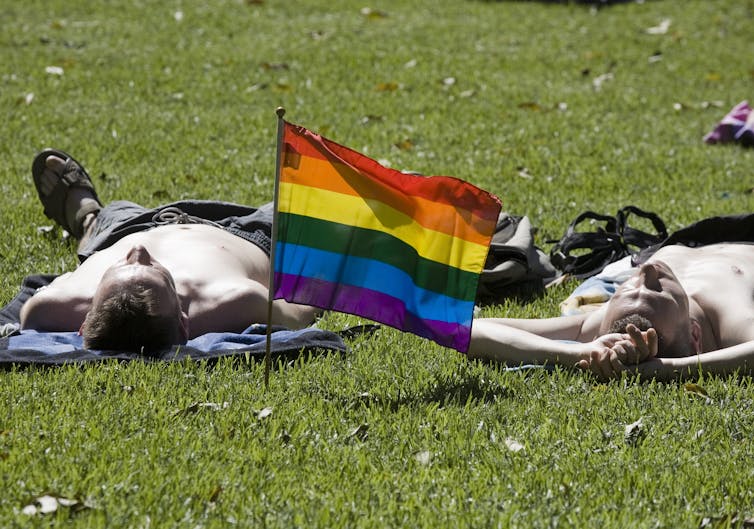
But it still allows for discrimination by religious groups against LGBTIQ+ people, women and people on the basis of their religion. If passed, it will entrench in law the idea that LGBTIQ+ people are still not quite like everyone else – for this is the effect of state-sanctioned discrimination.
The bill will also legitimise the fallacy that the rights of LGBTIQ+ people are incompatible with religious freedom. It has already successfully wedged the ALP.
In setting free the expression of religious beliefs from the responsibility to take account of how even “well-meaning” statements of judgment and condemnation can harm people, the divisions this debate has created within Australia’s social fabric will be difficult to heal.![]()
Elenie Poulos, Honorary Postdoctoral Associate, Macquarie University
This article is republished from The Conversation under a Creative Commons license. Read the original article.
Schools can still expel LGBTQ+ kids. The Religious Discrimination Bill only makes it worse

The Religious Discrimination Bill is back, this time in its third iteration. The Coalition party room unanimously endorsed the bill on Tuesday, but a number of Liberal MPs voiced concerns about what it could mean for LGBTQ+ students and teachers at faith-based schools and universities.
Attorney General Michaelia Cash has said no child should be “suspended or expelled from school on the basis of their sexuality or gender identity”, and that discrimination against students is “unacceptable”.
However, the bill does nothing to protect LGBTQ+ students and teachers. It allows more, not less, discrimination by religious schools.
The Prime Minister’s Long Lost ‘Promise’
In October 2018, the Prime Minister promised to ban religious schools from expelling students on the basis of their sexuality.
This requires removing the exemptions in the federal Sex Discrimination Act which permit religious schools to expel LGBTQ+ students and sack LGBTQ+ teachers. The reason can be as simple as “they’re bisexual”, or “they’re transgender” – as long as this fits within the school’s religious beliefs.
More than three years later, these exemptions still remain. Religious schools can, today, expel kids just for being gay. While many might not choose to do this and are supportive of the LGBTQ+ community, there have still been cases of non-supportive religious schools who have sacked teachers for being gay.
Despite this, the federal government has continually kicked the can down the road on this reform.
Michaelia Cash last week asked the Australian Law Reform Commission to provide detailed advice on the Sex Discrimination Act exemptions. This comes some 30 months after the Commission was first asked to conduct an inquiry into this issue.
But here’s the kicker – they can only report back 12 months after the Religious Discrimination Bill becomes law.
At best, this is likely to be early 2023, since the Religious Discrimination Bill seems destined to head to a Senate inquiry. An entirely new law will then need to be drafted and passed through parliament to change the Sex Discrimination Act exemptions.
The best-case scenario is that religious schools lose the right to sack LGBTQ+ staff and expel LGBTQ+ students in, wait for it… 2024. A student who was in year 7 when this change was promised will have graduated from high school by the time it is implemented.
And even then, if only suspension and expulsion were banned – the attorney general only promised to address these two outcomes – this wouldn’t stop religious schools mistreating LGBTQ+ students in other ways. Schools could still ban same-sex relationships, or refuse to use a transgender student’s pronouns.
So What Does The Religious Discrimination Bill Have To Say About It?
If the Sex Discrimination Act exemptions are eventually removed, that still isn’t the end of the story.
Federal Labor has expressed concern at how the Religious Discrimination Bill may adversely affect LGBTQ+ students and teachers at religious schools. Their concern is well founded.
The bill’s main purpose is to prohibit discrimination on the basis of religious belief or activity. This means, for example, that an employer would not be able to sack someone on the basis they are Jewish, or Muslim.
However the bill also contains very wide exemptions. These are situations in which discrimination is allowed.
Religious schools are permitted to discriminate on the basis of a person’s religion. They only need to prove that an individual of the same religion as the school “could reasonably consider” the school’s actions to accord with their religious beliefs.
It is a test not seen in any other Australian discrimination laws. It is such a low bar that religious schools can likely rely on it for almost everything they do.
This means that even if the Sex Discrimination Act exemptions are removed, the Religious Discrimination Bill could provide an alternative route for religious schools to discriminate against LGBTQ+ teachers and students.
For instance, a non-supportive religious school may teach that gay couples should not be allowed to marry or have children. They could then discriminate against any staff and students who do not adhere to this belief – such as a teacher who marries their same-sex partner.
To partly address this, the government added a clarification in the second draft of the bill that it “does not” permit conduct that is unlawful under the Sex Discrimination Act.
However, the third draft of the Bill has watered this down. It now simply says that conduct covered by the bill “may” still be discriminatory under the Sex Discrimination Act. The subtle change from “does not” to “may” makes a big difference, and puts LGBTQ+ teachers and students at risk.
And because of the controversial “statement of belief” provisions in the bill, religious schools are largely free to tell trans students that their gender identity is against the laws of God, or to tell lesbian parents they are evil for depriving their child of a father. Even if other discrimination laws ban such statements being made, this bill overrides them.
No matter how you cut it, the Religious Discrimination Bill permits far too much harm in the name of religion.
Oh, And One More Thing…
As if this wasn’t enough, the latest version of the bill adds a second override provision.
This allows religious schools to hire and fire on the basis of any religious views, even where such views are irrelevant to the position in question. The school only needs to share publicly their policy on this.
Although some state and territory laws provide stronger protection for staff at religious schools, the bill overrides these laws.
Victoria, for instance, is considering a new law which would bar religious schools from employment discrimination except for key faith-based roles, such as religious education teachers. It would mean religion cannot be used to discriminate against maths teachers, or gardeners.
This new provision in the Religious Discrimination Bill would reverse that protection, and open up Victorian teachers and staff to discrimination.
In the last 40 years of discrimination laws in Australia, there is hardly a single example of a federal law overriding discrimination protections granted under state and territory laws. In this Bill, there are two: both with severe consequences for the LGBTQ+ community.
Unless the Morrison government takes swift action to correct this course, being an LGBTQ+ student or staff member at a non-supportive religious school is going to become even harder than it already is.![]()
Liam Elphick, Associate Lecturer, Faculty of Law, Monash University and Alice Taylor, Assistant Professor, Faculty of Law, Bond University
This article is republished from The Conversation under a Creative Commons license. Read the original article.
Ending online anonymity won’t make social media less toxic

In recent months the government has proposed cracking down on online anonymity. The idea is that attaching online posts to a person’s real name will reduce abuse and increase accountability.
Online bullying and misinformation are growing problems, and government action to address them is overdue.
However, limiting anonymity alone won’t make social media less toxic. It will only work combined with broader reforms to platform design and business models, which drive polarisation, negativity, abuse and misinformation.
Reforms must also protect free speech and account for power imbalances between citizens and the state. The mooted changes come alongside suggestions of public funding for defamation actions by parliamentarians. Cynics might view these two suggestions together as an effort to silence reproach.
Potential Anonymity Reforms
In April this year, a parliamentary committee recommended requiring users to provide ID documents before opening social media accounts.
This was not implemented, but in June the Online Safety Act was changed to empower the e-Safety Commissioner to require platforms to disclose personal information of alleged online bullies.
In September, the High Court held that media outlets can be liable for defamatory third-party comments on their social media posts.
Government comments indicate intent to further regulate online anonymity. Prime Minister Scott Morrison recently described social media as a “coward’s palace”, pressuring platforms to expose the identities of anonymous trolls.
Deputy Prime Minister Barnaby Joyce also criticised platforms professing to be “vessels of free speech” while enabling users to conceal their identities.
Risks
There are risks with the proposed policy direction. First, anonymity regulation alone may be ineffective in stopping abuse and misinformation.
Second, reforms must be scrutinised to ensure they serve public rather than political interests. While the state stifling dissent may seem less of a concern in a democracy like Australia than in authoritarian regimes, it is important to ensure new measures won’t unreasonably compromise free speech and privacy.
This concern is underscored by politicians issuing legal threats to citizens for voicing online critiques.
In combination with Australia’s defamation laws, removing online anonymity may further expose users and chill democratic debate.
Complex Drivers Of Toxicity
Anonymity is only one factor contributing to online toxicity.
Most current platforms are designed to maximise user engagement. Platform algorithms, in combination with human behaviour, mean negative and angry content outcompetes positive content. This promotes negativity, polarisation and extremism.
Engagement-driven business models also incentivise fake news. Mistruths attract more engagement, so falsity is 70% more likely to be retweeted than fact.
Research further shows sharing of political misinformation is driven by partisanship more than ignorance. Online polarisation therefore propels misinformation in aid of the culture wars.
For example, the COVID-19 hashtag “#Danliedpeopledied” was driven by hyper-partisan and fake accounts. An anti-vax “infodemic” now spreads online, propelled by tribal influencers and anti-vaxxer communities.
Online toxicity is exacerbated by social media’s addictiveness. Each “like” and comment gives users “a little dopamine hit”. Outrage and negativity equal more engagement, which means more dopamine rewarding the behaviour.
Connection
While we turn to social media for company and validation, heavy use can make us feel alone. Isolation may leave us more susceptible to tribes that foster belonging.
Tribalism can encourage group attacks, reinforcing tribal connection. Social media “pile-ons” can be devastating for the target. Such bullying would probably not occur in person. But online, we have fewer physical and visual cues to encourage empathy.
While some (especially anonymous trolls) find courage on social media, others are frightened off. Negative online encounters can create a “spiral of silence”, discouraging moderate users from participating. This creates more room for fringe voices emboldened by the echo chamber.
What Reforms Are Needed?
Anonymity regulation will only help with bullying and misinformation if part of broader reforms tackling other drivers of toxicity, like engagement-driven polarisation. This means addressing platform business models and design – a complex task.
Reforms must also be fair.
First, anonymity regulation must apply equally to parliamentarians. Some politicians have used fake accounts to confect support, which undermines healthy debate.
A parliamentary code of conduct could define standards for politicians’ behaviour, both online and offline. Regulating truth in political advertising may curtail dishonesty.
Second, if anonymity is regulated, it is even more crucial to ensure citizens are not gratuitously sued or threatened by politicians for voicing opinions online.
Protection of reputation and accuracy are important, but we must safeguard fair debate. Politicians enjoy free speech bolstered by parliamentary privilege and media platforms.
Social media has disrupted politicians’ domination of political discourse, which helps explain the recent explosion of defamation threats and actions by politicians.
Any anonymity regulation must be balanced by free speech protections, including more robust defamation defences accounting for power imbalances between citizens and the state.
Given their positions of power, politicians should accept a higher threshold of criticism.
This article was co-authored with Andrew Ball, who is an Associate Director at IT consultancy firm Accenture.![]()
Shireen Morris, Senior lecturer, Macquarie University
This article is republished from The Conversation under a Creative Commons license. Read the original article.
Curriculum is a climate change battleground and states must step in to prepare students

There is a pressing need to prepare for the impact of the climate crisis on schools and school education in Australia. A Western Australian parliamentary inquiry into the response of the state’s schools to climate change reflects this need. It is investigating current and potential mitigation and adaptation strategies undertaken in schools.
The inquiry seeks to prepare for the impacts of a heating planet on the infrastructure and provision of school education. It is investigating the actions, benefits and barriers to climate change responses in schools. But, oddly, its terms of reference exclude curriculum.
Curriculum is the bread and butter of schooling. And research shows it’s an effective means to reduce and adapt to climate change impacts.
When it comes to climate change, however, curriculum is a battleground. It may not be as visible as the student climate protests, but it is a crucial sphere in which the future of the world is understood, imagined and created. For educators, what they do, what they teach and the possibilities they imagine often start and end with the curriculum.
Yet, in Australia, there is no substantive national climate change education or curriculum.
Why Does The Curriculum Neglect Climate Change?
The 2008 Melbourne Declaration on Educational Goals for Young Australians, made by all the nation’s education ministers, referred to climate change and the embedding of sustainability across the curriculum. But under the stewardship of the federal education minister, these references were removed when the declaration was updated and agreed to by the ministers in 2019. We have also seen the withdrawal of federal funding and support for school sustainability initiatives and national action plans over the past decade.
The piecemeal curriculum approach to climate change has left schools and teachers to “fend for themselves” if they want to teach climate change.
The lack of national vision and strategy reflects the federal government’s failure to lead responses that match the scale of the climate crisis. It bodes poorly for achieving a national approach to climate change education.
While the states have constitutional responsibility for school education, reforms over the past two decades have only strengthened the federal government’s influence over education. This includes influence over the national curriculum, which it has not hesitated to exercise.
Schools Can Make A Difference
With the federal government at odds with states that wish to pursue ambitious climate change agendas, or simply to make climate change an educational priority, those states must go it alone. The Victorian government, for instance, is consulting on its Education and Training Climate Change Adaptation Plan 2022-2026. It seeks to embed a climate-change lens in decision-making across the many facets of its education sector, including curriculum.
The education policy architecture created over the past two decades is meant to serve the national interest. When it comes to climate change education, the absence of the federal government in this sphere is glaring.
There is still cause for modest hope that schools are getting it right when it comes to climate change. However, the response of Australia’s school system to the climate crisis is like that of other systems around the world: diffuse and fragmented. Thus, schools are largely “unexploited as a strategic resource to mitigate and adapt to climate change”.
Onus Is On The States To Act
Perhaps, then, the states need to better assert their constitutional rights over schooling. They could use the national policymaking architecture to create and administer an ambitious national response to climate change that includes curriculum.
Australian schools and young people need to be prepared for their climate futures. This means every teacher must be a climate change educator and every school an incubator of informed and empowered citizens.
With a federal government missing in action, state-led responses to climate change, such as the schools inquiry in WA, must be unapologetically ambitious. To do less is to abdicate their constitutional role.
When it comes to climate change education, to repurpose the words of then Labor MP Gordon Bryant in a 1958 parliamentary debate over the role of the states, the dead hand of the federal government should not be allowed to strangle the education systems of this country.![]()
Brad Gobby, Senior Lecturer in Curriculum, Curtin University and George Variyan, Lecturer, Faculty of Education, Monash University
This article is republished from The Conversation under a Creative Commons license. Read the original article.
Every dollar invested in research and development creates $3.50 in benefits for Australia, says new CSIRO analysis

Each dollar invested in research and development (R&D) would earn an average of A$3.50 in economy-wide benefits for Australia, according to evidence compiled in a new report from CSIRO.
Many Australians know research and development drives economic growth and improves our well-being and prosperity. However, few could describe the size of the relationship between Australia’s research and development spending and economic growth, or compare this to performance on other typical investment returns.
Examples of future industries that could be unlocked by research and development in Australia include the quantum technology and hydrogen industries. Examples of emerging technologies that could change the way Australians work and live include artificial intelligence and robotics.
This is significant, given recent figures from the Australian Bureau of Statistics show business spending on research and development as a proportion of GDP is just half the OECD average, and the lowest it has been since 2003.
We hope our analysis will raise awareness of the value of this kind of spending, and its importance for Australia’s economic recovery and long-term resilience. Investing in innovation now is crucial for the future.
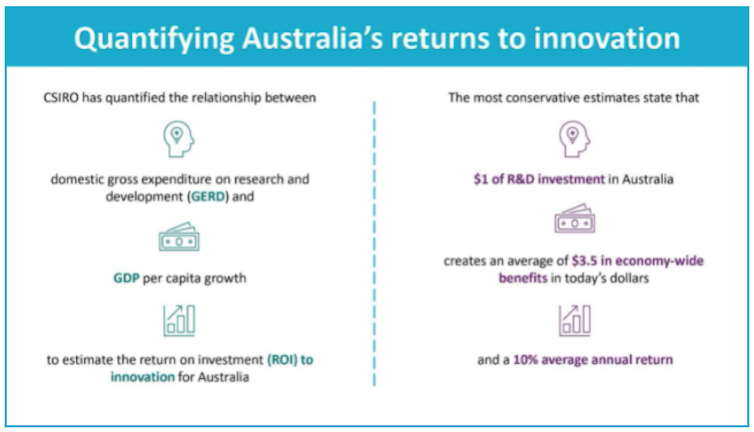
In consultation with government and academic stakeholders, our team at CSIRO Futures, the strategic and economic advisory arm of Australia’s national science agency, used a new yet simple economic approach to quantify the return on investment in overall research and development spending for Australia.
By adapting a method originally developed in the US, we calculated return on investment by defining the relationship between domestic gross spending on research and development, and the growth in per capita gross domestic product (GDP) that follows as a result. This method encompasses both successful and unsuccessful research and development investments, and quantifies only monetary benefits (excluding non-monetary social and environmental benefits).
Our approach also accounts for delays between research and development investments and payoffs, and for the capital costs of integrating research and development into the economy. For example, an innovation of new computer software must be built into existing computer systems, and might therefore take a decade before its use becomes widespread.
Overall, we calculate that $1 of research and development investment creates an average of $3.50 in economy-wide benefits in today’s dollars, and a 10% average annual return for Australia.
By removing the considerations of delays and capital costs, we can also calculate an upper boundary on our estimate – that is, the maximum theoretical return on investment barring any hurdles along the way.
This unadjusted result, which does not account for the additional time and costs associated with integrating research and development into the economy, is estimated as creating $20.80 in economy-wide benefits, and a 104% average annual return for every dollar spent on research and development in Australia.
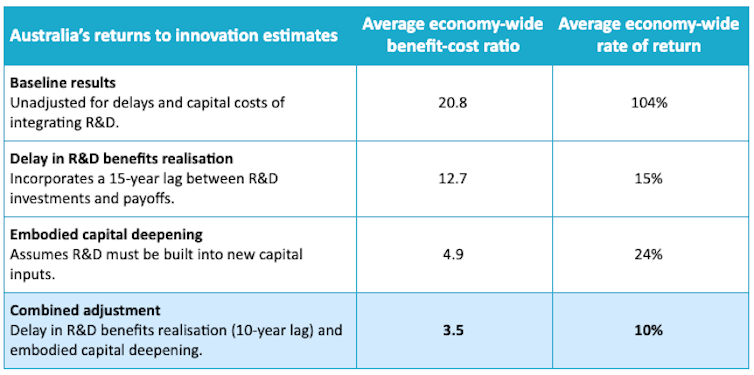
Even with our conservative estimate of $3.50 return on the dollar, the expected benefits of investing in innovation are high compared with many other types of investments. For example, Australia’s ten-year government bond returns have historically averaged around 7% per year. Private investments in the ASX200 stock index have typically yielded around 10% annually.
Perhaps even more significantly, even our conservative estimate of $3.50 return on investment suggests research and development has a cost/benefit ratio well in excess of $1 to $1. This means there is a strong economic case for this kind of spending.
But research and development investment is risky, right? This may be much less of a problem at a national level. While cost or time overruns are never favourable for any investment, building this uncertainty into our findings shows research and development investment remains economically viable even if this happens.
Results from sensitivity analysis demonstrate that if the costs of research and development spending or delays of payoffs increase by 20%, the most conservative (combined adjustment) results only fall to $3.30 return on investment, with annual yields of 9.5% (at lowest). These are still strong returns.
Our findings imply that so far, Australian innovation investments - whether they be in new products and services or in creating new industries - have been well worthwhile, and that increasing future investment could capture substantial economy-wide returns.
As our estimates only capture the economic benefits of innovation, actual returns are likely to be much higher when also considering the broader social and environmental benefits of Australian research and development. ![]()
Katherine Wynn, Lead Economist, CSIRO Futures, CSIRO; Jasmine Cohen, Economic Consultant, CSIRO Futures, CSIRO, and Mingji Liu, Senior Economic Consultant, CSIRO
This article is republished from The Conversation under a Creative Commons license. Read the original article.
How to make roads with recycled waste, and pave the way to a circular economy
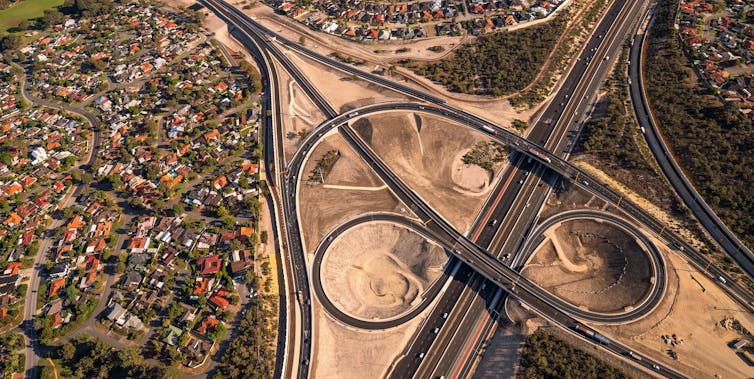
It cost A$49 million to add 12.5 kilometres of extra lanes to Western Australia’s Kwinana Highway, south of Perth’s CBD. That’s not unusual. On average, building a single lane of road costs about about A$5 million per kilometre.
What is unusual about this stretch of extra freeway is not the money but the materials beneath the bitumen: two stabilising layers comprised of 25,000 tonnes of crushed recycled concrete, about 90% of which came from the demolition of Subiaco Oval (once Perth’s premier football ground).
Recycling building and construction materials remains the exception to the rule in Australia. The National Waste Policy agreed to by federal, state and territory governments has a target of 80% resource recovery by 2030. It’s currently about 40%.
Of the 74 million tonnes of waste generated in Australia in 2020, masonry materials comprised about 22.9 million tonnes. Plastics, by comparison, comprised about 2.5 million tonnes. Of the 61.5 million tonnes of “core waste” managed by the waste and resource recovery sector, 44% (27 million tonnes) came from the construction and demolition sector, compared with 20% (12.6 million tonnes) from households and local government activities.
Most of this waste – concrete, brick, steel, timber, asphalt and plasterboard or cement sheeting – could be reused or recycled. It ends up in landfill due to simple economics. It’s cheaper to buy new materials and throw them away rather than reuse and recycle.
Changing this equation and moving to a circular economy, in which materials are reused and recycled rather than discarded in landfill, is a key goal to reduce the impact of building and construction on the environment, including its contribution to climate change.
The Economics Of ‘Externalities’
The fact it is more “economic” to throw materials away than reuse them is what economists call a market failure, driven by the problem of “externalities”. That is, the social and environmental costs of producing, consuming and throwing away materials is not reflected in the prices charged. Those costs are instead externalised – borne by others.
In such cases there is a legitimate – and necessary – role for governments to intervene and correct the market failure. For an externality such as carbon emissions (imposing costs on future generations) the market-based solution favoured by most economists is a carbon price.
For construction material waste, governments have a few more policy levers to help create a viable market for more recycling.
Using Procurement Policies
One way to make recycling more attractive to businesses would be to increase the cost of sending waste materials to landfill. But this would likely have unintended consequences, such as illegal dumping.
The more obvious and effective approach is to help create more demand for recycled materials through government procurement, adopting policies that require suppliers to, for example, use a minimum amount of recycled materials.
With enough demand, recyclers will invest in further waste recovery, reducing the costs. Lower costs in turn create the possibility of greater demand, creating a virtuous circle that leads to a circular economy.
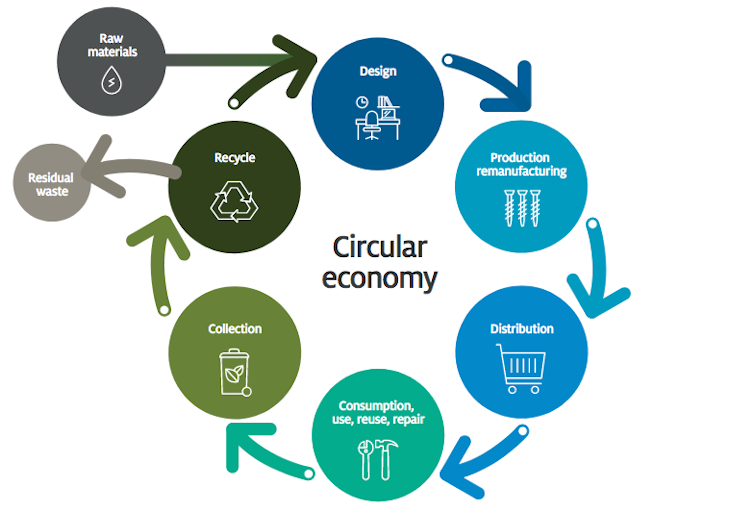
Australia’s federal, state and territory governments all have sustainable procurement policies. The federal Sustainable Procurement Guide states the Australian government “is committed to transforming Australia’s waste into a resource, where most goods and services can be continually used, reused, recycled and reprocessed as part of a circular economy”.
But these policies lack some basic elements.
Three Key Market-Making Reforms
Our research suggests three important reforms could make a big difference to waste market operations. This is based on interviewing 27 stakeholders from the private sector and government about how to improve sustainable procurement.
First, government waste policies that set aspirational goals are not supported by procurement policies setting mandatory minimum recycled content targets. All contractors on government-funded construction projects should be required to use a percentage of recycled waste materials.
Second, the nature of salvaging construction materials means quality can vary significantly. Cement recycled from a demolition site, for example, could contain contaminants that reduce its durability.
Governments can help the market through regularly auditing the quality of recycler’s processes, to increase buyer confidence and motivate suppliers to invest in production technologies.
Third, in some states (such as Western Australia) the testing regimes for recycled construction products are more complex than that what applies to raw materials. More reasonable specifications would reduce compliance costs and thereby the cost of using recycled materials.![]()
Salman Shooshtarian, Research Fellow, RMIT University; Savindi Caldera, Research Fellow and Project Development Manager, Cities Research Institute, Griffith University; Tayyab Maqsood, Associate Dean and Head of of Project Management, RMIT University, and Tim Ryley, Professor and Head of Griffith Aviation, Griffith University
This article is republished from The Conversation under a Creative Commons license. Read the original article.
How Sugar-Loving Microbes Could Help Power Future Cars

Disclaimer: These articles are not intended to provide medical advice, diagnosis or treatment. Views expressed here do not necessarily reflect those of Pittwater Online News or its staff.
